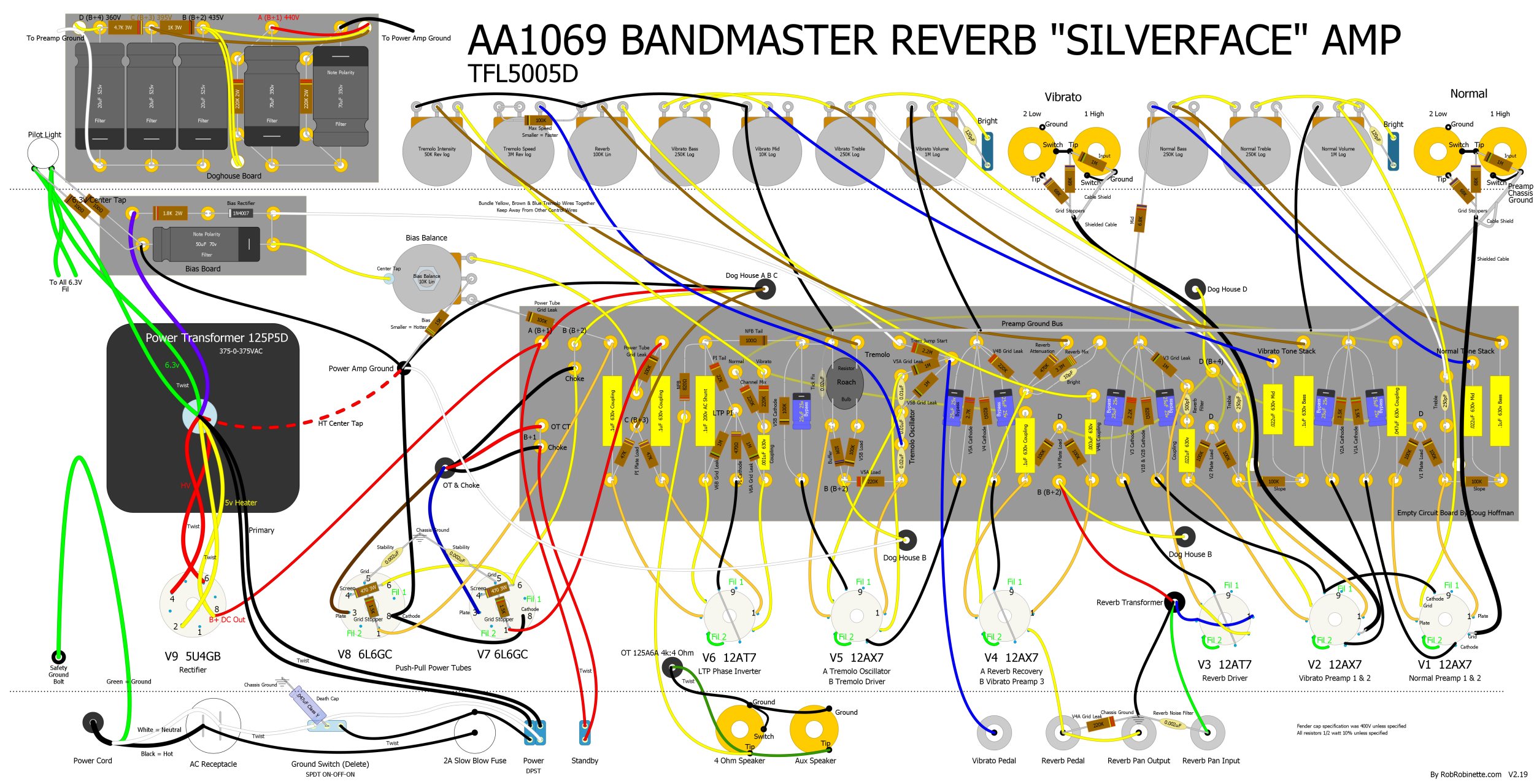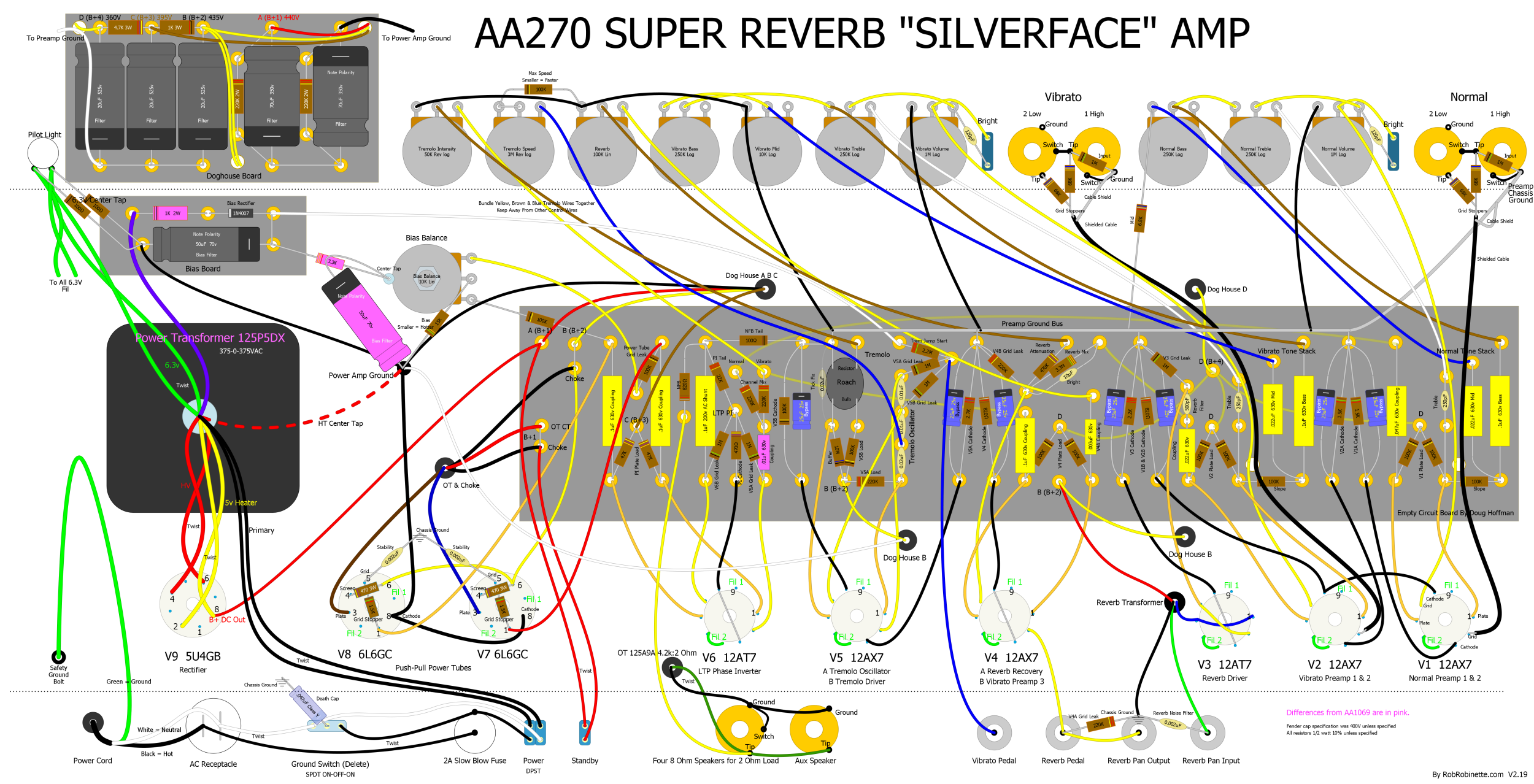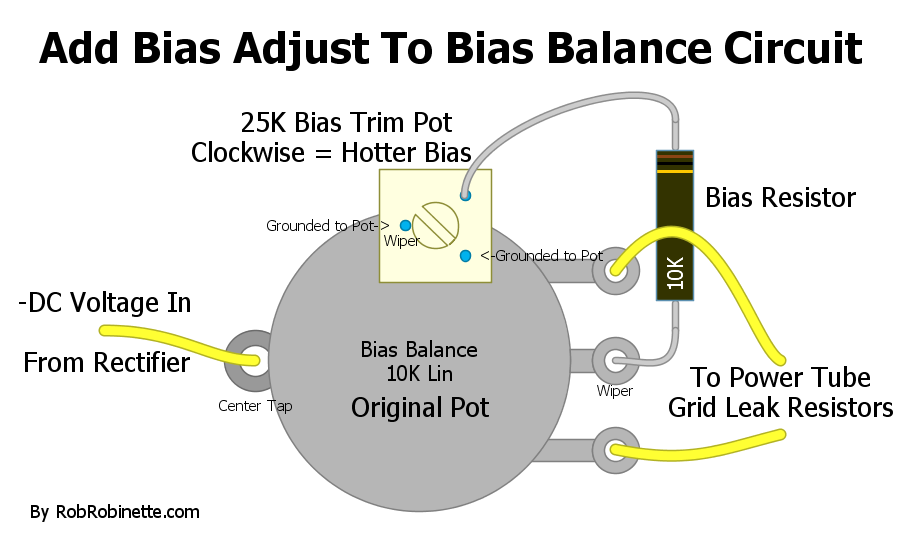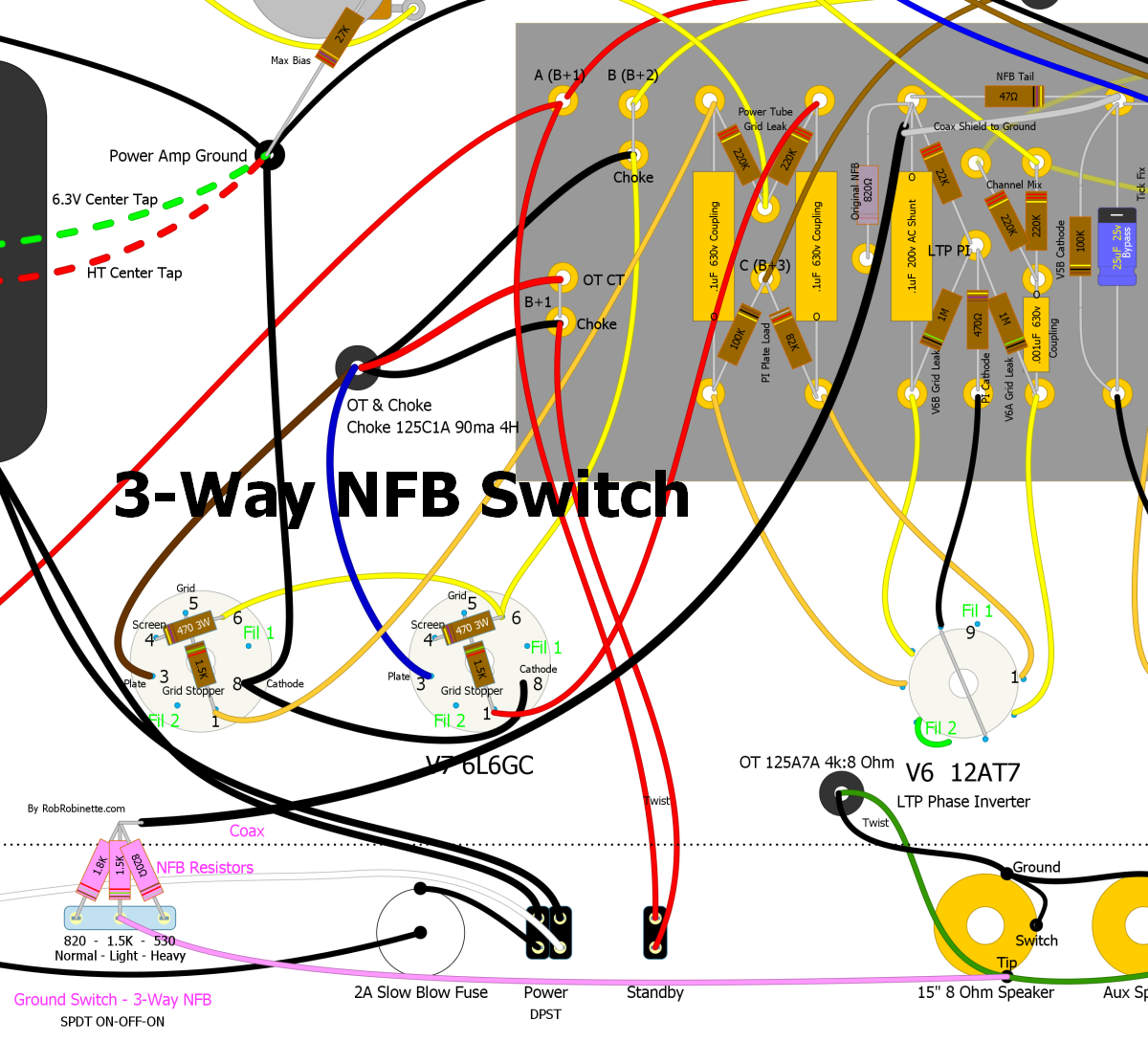Silverface Amp Modifications
By Rob Robinette
Have comments or corrections? Email rob at: robinette at comcast dot net
WARNING: A tube amplifier chassis contains lethal high voltage even when unplugged--sometimes over 700 volts AC and 500 volts DC. If you have not been trained to work with high voltage then have an amp technician service your amp. Never touch the amplifier chassis with one hand while probing with the other hand because a lethal shock can run between your arms through your heart. Use just one hand when working on a powered amp. See more tube amplifier safety info here.
'AA1069' was Fender's internal model designation for the 1969 silverface circuit. The "1069" in the model name comes from the circuit change date of 10-1969. Silverface amps include the Deluxe Reverb, Twin Reverb, Super Reverb, Pro, Bandmaster Reverb, Bassman, Princeton, Princeton Reverb, Champ, Vibro Champ, Showman and Vibrolux Reverb.
The silverface amps are surprisingly similar to the coveted Fender blackface line of amps so many blackface mods and tweaks apply to the silverface lineup. It's pretty easy to "blackface" these amps for a full generational regression.
I usually prefer switchable mods that allow me to go back to the amp's original circuit and tone. The often unused Normal channel is also a great place to mod away with to make that channel interesting and usable.
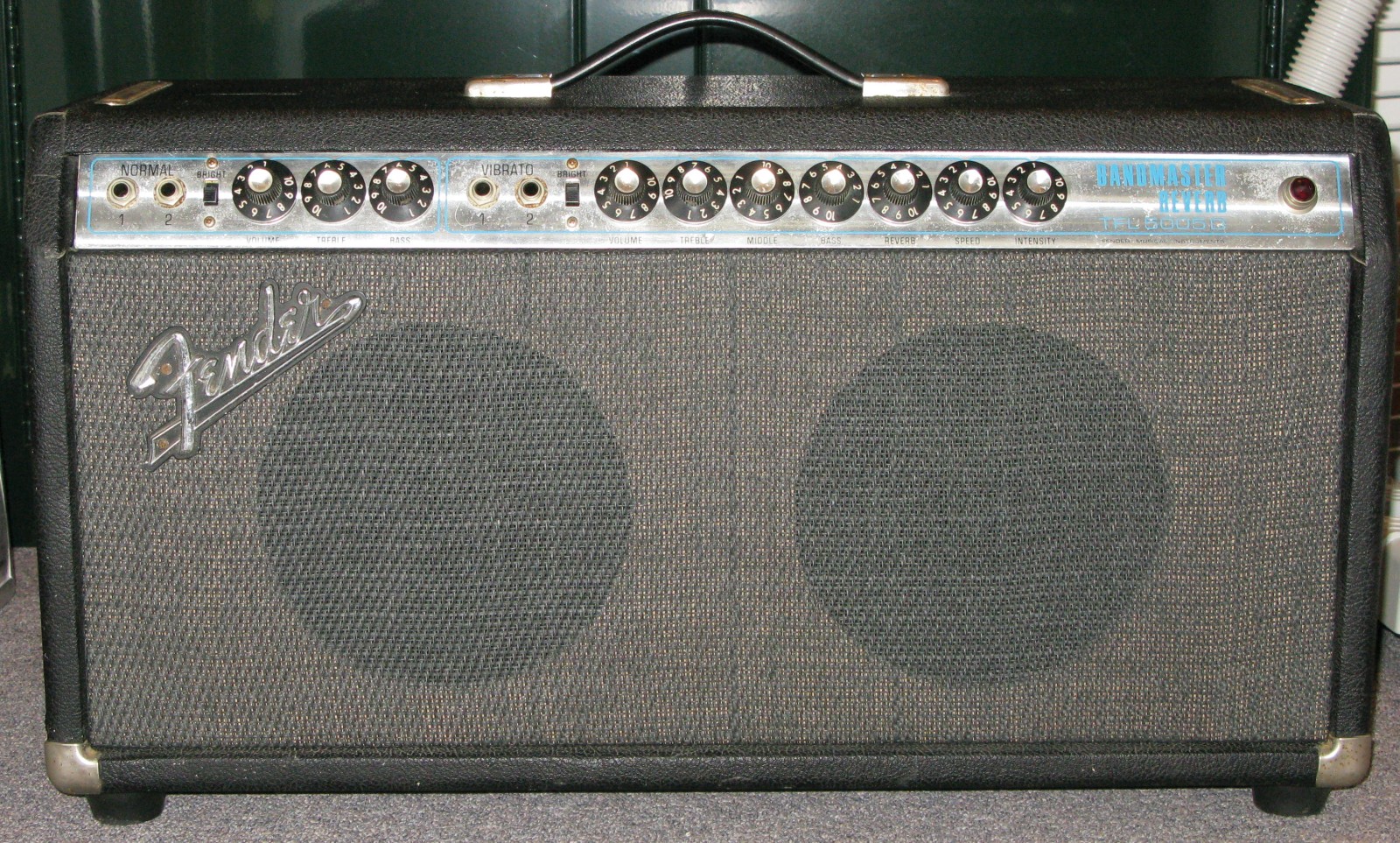
My very cool Fender AA270 silverface Bandmaster Reverb. Fender made the head cab extra large to allow for distance between the power transformer and the reverb tank. This extra size allowed two 8" Fender Special Design C8R speakers to fit nicely.
List of Mods
"Blackface" a Silverface Amp Make your silverface amp sound right ;)
Convert a Silverface Amp's Bias Balance circuit to Adjustable Bias + Bias Balance It's very easy to tack on a bias trim pot.
robrob Normal Channel Reverb Mod The preferred way to apply reverb and tremolo to both channels and allow channel jumpering.
Fender Normal Channel Reverb Mod Apply reverb and tremolo to both channels the way Fender did it in the 68 Custom Deluxe Reverb.
Lead Channel Mod Do something constructive with your unused Normal channel.
3-Way Negative Feedback Mod Make your amp more versatile. Cut the NFB in half and add some color and texture.
Master Volume Mod Add a Trainwreck Type-2 or simple Type-3 PPIMV master volume.
Vox Cut Control + Master Volume Mod Master volume AND late-in-the-circuit tone control. I love this thing.
1/4 Power Switch Dump 3/4 of the amp output for lower volume
10% Power Switch Dump 90% of the amp output for true bedroom level output
10% Power Jack Use your Aux jack as a 10% output jack
10% Power In External Box External box goes between your amp and speaker to dump 90% of amp power
1/2 Power Pentode/Triode Switch Cut power tube output for lower volume
Add a Presence Control Use this late-in-the-circuit tone control to tame ice pick and tweak your tone.
Add a Mid Tone Pot If you amp doesn't have one then add one
Raw Switch Mod Eliminate the tone stack and boost gain for a very tweedy tone.
Tone Stack Mods Why have two identical tone stacks? Mod one of them.
Mixing Resistor Bright Cap Mod Moar bright!
Increase Preamp & Phase Inverter Voltage An excellent mod for amps upgraded from 6V6 to 6L6 power tubes.
Ice Pick Cap Mod Take the edge off an ice picky speaker.
Tremolo Cut Mod Add preamp gain with this simple mod.
Slow the Tremolo Slow is good.
Stop Tremolo Ticking Add one cap and it's gone.
Always On Tremolo Plug Leave your tremolo footswitch at home.
Reverb Dwell Control Mod Add more reverb control.
Humdinger Heater Hum Pot Minimize 60Hz heater hum.
Add 8" Speakers to a Head Cab Make your head cab a little heavier but a lot more flexible.
Run 6V6 Power Tubes in a 6L6 Amp Less output power, small bottle tone with more power tube distortion.
Run 6L6 Power Tubes in a 6V6 Amp A tone change with little power gain.
Run 2 Power Tubes in a 4 Power Tube Amp Cut your output power almost in half.
Run 2 6V6 Power Tubes in a 4x6L6 Amp Cut your big amp's power by 65%.
Preamp Tube Tweaks It's surprising how much you can do with simple preamp tube swaps.
robrob's AA270 Bandmaster Reverb Mods What I did to my sweet ass Bandmaster Reverb.
Real World Voltages These are my bone stock AA270 Bandmaster Reverb voltages.
AA1069 Silverface Annotated Schematic

Component functions are listed.
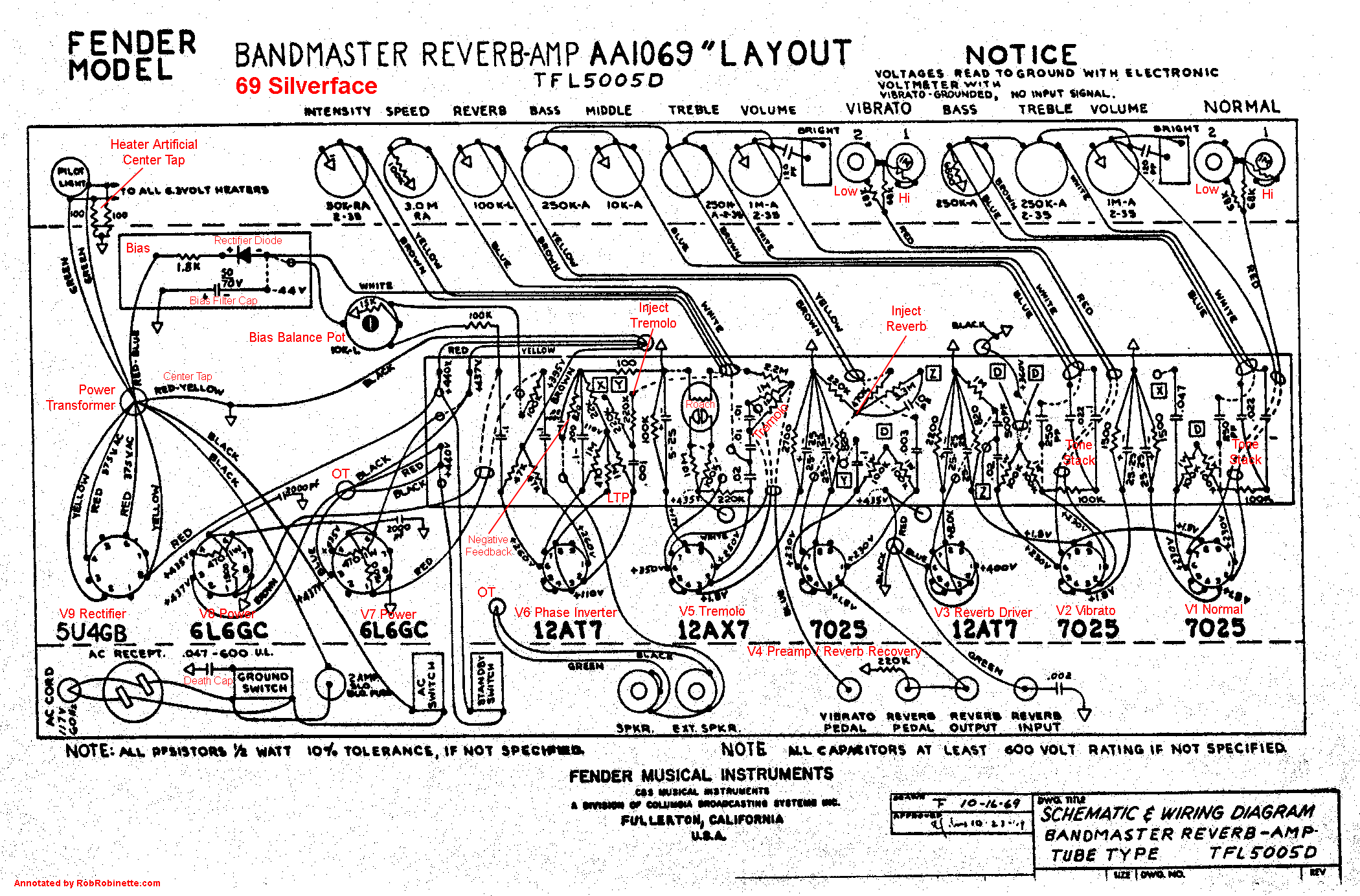
My AA1069 Bandmaster Reverb Layout Created In DIYLC
Click on the image to see the hi-res version. Download the pdf here and the DIYLC file here.
1972 AA270 Silverface Bandmaster Reverb
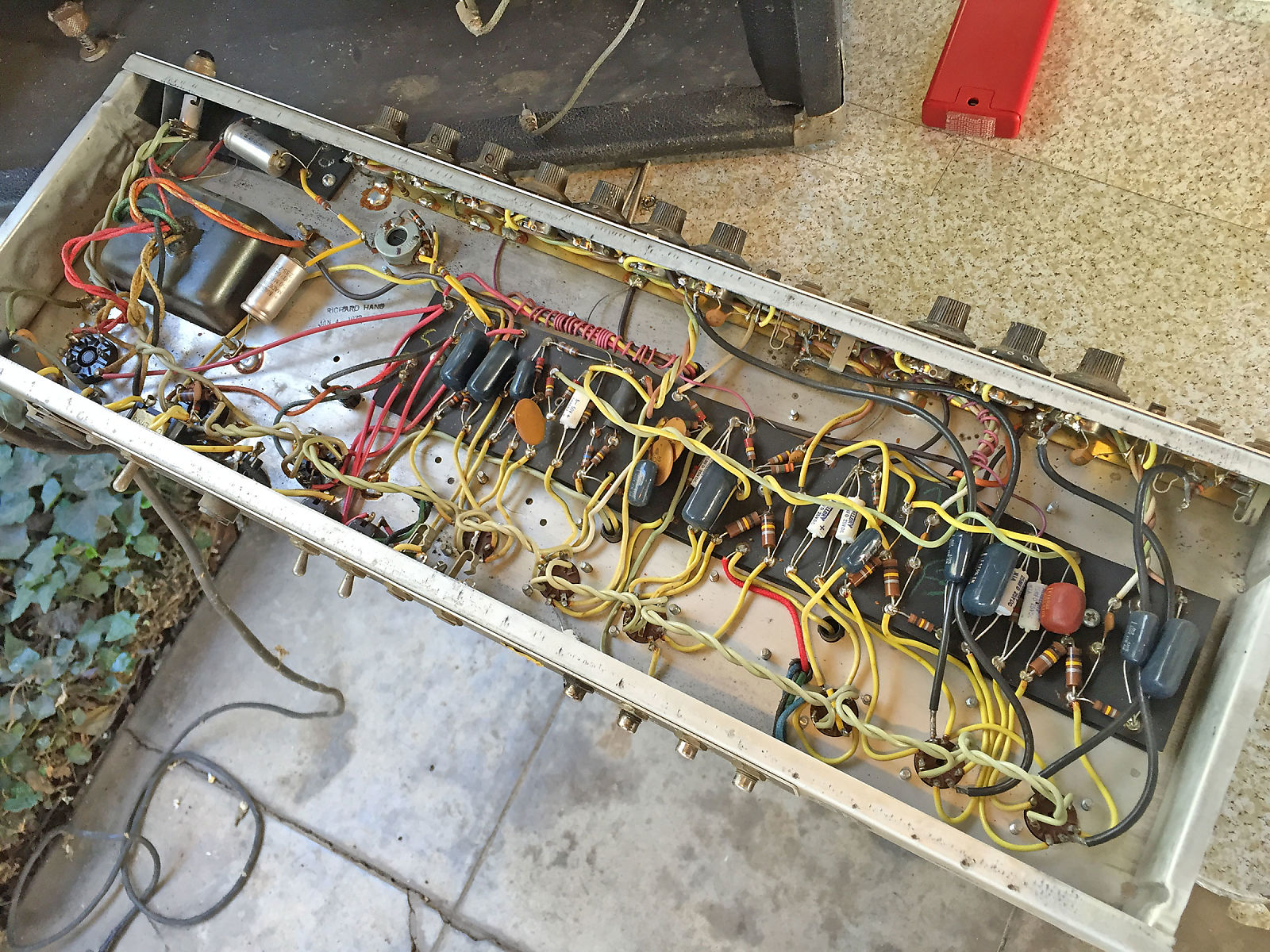
The only differences between the AA1069 and AA270 Bandmaster Reverb are the AA270's power transformer, bias circuit with 1k bias resistor, extra filter stage consisting of an additional 3.3k resistor and 50uF 70v filter cap and a 10x larger .01uF phase inverter input coupling cap. I changed the coupling cap to blackface standard .001uF. Note how Fender wrapped the doghouse power wires and control pot wires with red grounded wires for a "poor man's shielded cable" to reduce noise transmitted and received by these wire groups.
Differences between the AA1069 and AA270 are in pink. Click the image to see the hi-res version. Download the pdf here. Download the DIYLC file here.
"Blackface" a Silverface Amp
I blackfaced my 1972 AA270 silverface Bandmaster Reverb (TFL5005D) into a 1963 AB763 blackface Vibroverb with just a few mods shown in red below. The Phase Inverter Plate Load resistors are the most important blackface mod.
All the Differences Between the AB763 Vibroverb and AA1069 Bandmaster Reverb
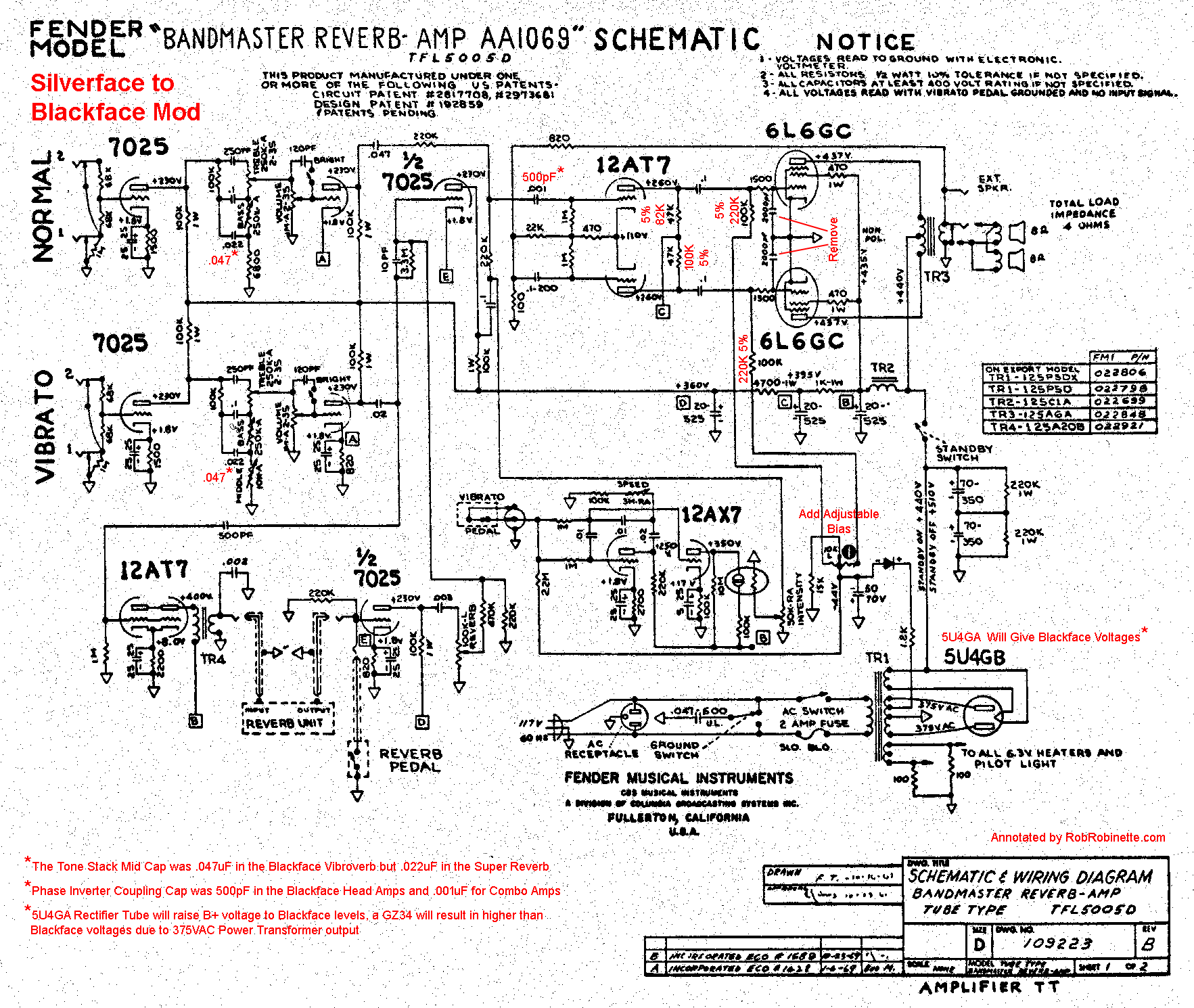
My AA270 Bandmaster Reverb had a .01uF (10 times larger) phase inverter coupling cap compared to the AA1069. The only other difference between the AA270 and AA1069 is the AA270's 1k bias resistor and extra filter stage in the bias circuit for less hum.
Replace the Phase Inverter Plate Load resistors with 82K (V6A) and 100K (V6B) 1/2 watt resistors. I like to use 1 or 2 watt rated resistors on preamp plates for a little less resistor hiss. 1/2 watt plate loads run pretty hot.
*The Tone Stack Mid Cap was .047uF in the blackface Deluxe, Deluxe Reverb, Vibroverb and Concert but .022uF in all other blackface amps. I'm a fan of the .022uF Mid Cap.
*Note the Phase Inverter Coupling Cap is shown in red with an asterisk because Blackface head amps used a 500pF coupling cap and the combo amps used a .001uF like this silverface. Fender used the smaller cap to trim some bass because the matching blackface extension cabs were closed back and had extended bass response. If you play mostly clean or use mostly open back cabs the .001uF cap would probably be best, but if you use closed back cabs or play a lot of overdrive the 500pF might be best for a slightly tighter overdrive tone. In 1970 Fender changed to a 10 times larger .01uF phase inverter input coupling cap. Verify the the cap value and change it to .001uF or 500pF. My AA270 Bandmaster Reverb had a .01uF installed so I replaced it with a .001uF.
*Using a 5U4GA Rectifier tube will bump the B+ voltage up to AB763 Vibroverb levels. Using a GZ34 like the Vibroverb will boost the B+ well beyond the Vibroverb levels because the Bandmaster Reverb's Power Transformer puts out 15 more volts than the Vibroverb. I don't recommend this mod since modern wall voltages are higher than the 117v the silverface amps were built for so internal voltages are already at or beyond what blackface amps operated at in the 1960's and '70's. To see how high the voltage is with modern wall power check out my voltage measurements here.
Replace the Power Tube Grid Leak resistors with 220K 1/2 watt resistors. If you push your amp hard with boost and gain pedals you may want to stick with the 100k resistors because they help prevent the power tubes from going into blocking distortion. Many Marshall amps use 100k Power Tube Grid Leak resistors for this reason.
Remove or clip the Stability Caps connected to the Power Tube Grids (pin 5). I recommend you desolder one end of the caps and test the amp with some high gain playing. If your amp oscillates after removing the caps try "chopsticking" the tube socket leads to better separate them, especially the preamp plate and grid wires (plate pins 1 & 6, grid pins 2 & 7). If you cannot fix the oscillation re-solder the caps back in or consider adding a 5F6A Bassman style 47pF stability cap between the phase inverter's plates.
I recommend keeping the AA1069 Bias Balance circuit and just add a 25k Bias trim pot so you have both adjustability to set the bias and a Bias Balance pot to match bias between the power tubes.
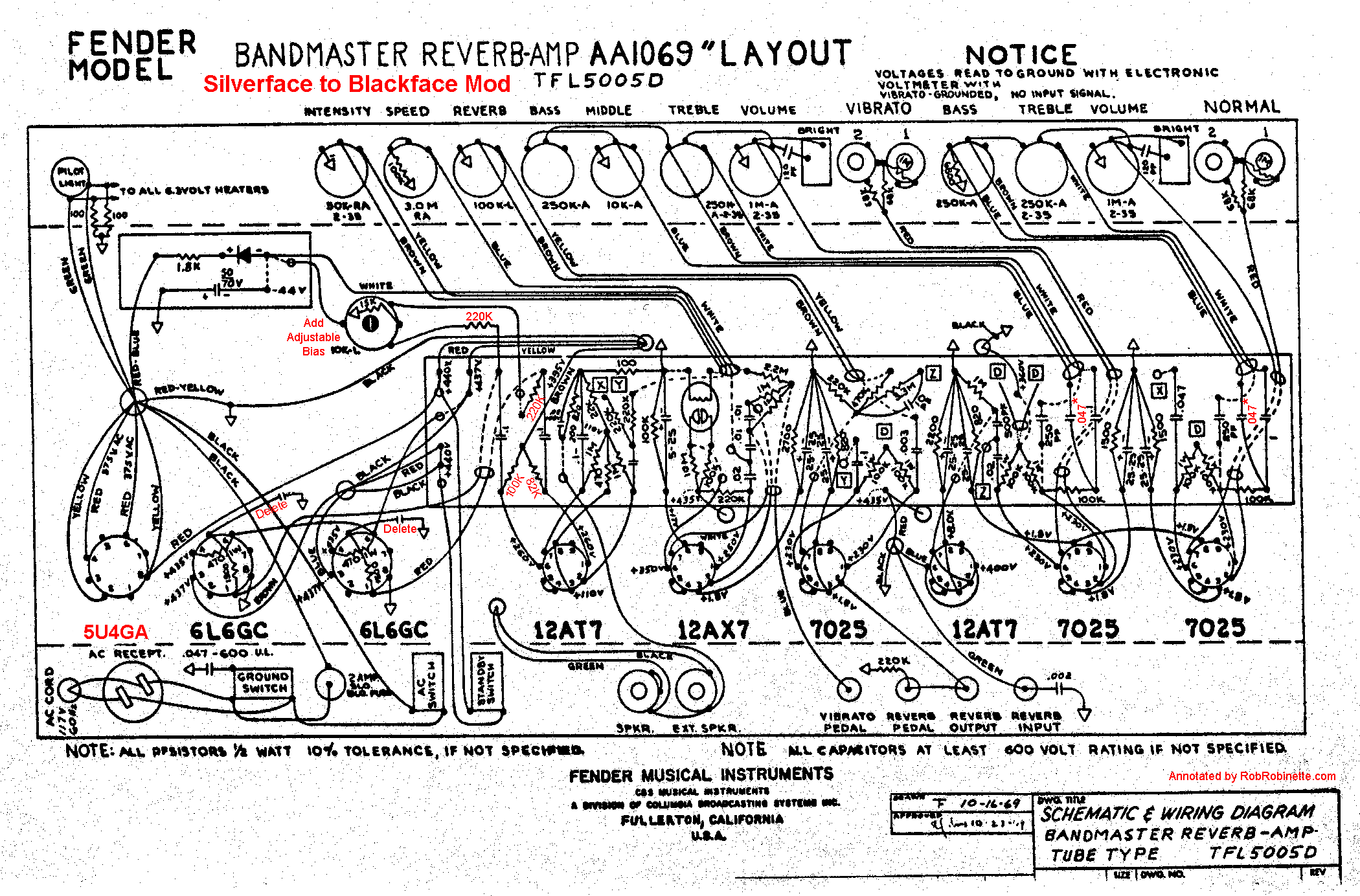
The blackface mods are shown in red.
The AB763 Vibroverb came with an 8 ohm output transformer with 820 / 47 ohm Negative FeedBack (NFB) circuit. The Bandmaster Reverb uses a 4 ohm output transformer with 820 / 100 negative feedback circuit. The two NFB resistors form a voltage divider so the different NFB resistors compensate for the 4 ohm transformer's lower output voltage. As long as the Bandmaster Reverb is connected to a 4 ohm speaker load (typically two 8 ohm speakers) the amount of NFB is the same as the Vibroverb.
All blackface mods apply to silverface amps that have been blackfaced.
Convert Bias Balance to Adjustable Bias + Bias Balance
This applies to most Fender amps with a Bias Balance pot but no bias level pot. Simply replace the 15K resistor that's soldered to the original Balance Bias pot's back with a 10k 1/2 watt resistor and a 25k to 50k trim pot. The Balance pot still acts to balance the bias between the power tubes but the trim pot will adjust the bias level of all the power tubes. Turning the trim pot clockwise to reduce resistance will pull the bias voltage toward zero volts and increase the bias current and make the bias hotter.
I highly recommend this Bourns 50k multi-turn trim pot part # 3299Y-1-503LF. At 50k it will offer a wide range of adjustment and since it's a multi turn trim pot it is very precise too.

The Original Bias Balance Pot
The silverface Bias Balance pot only adjusts the balance between the power tubes, it does not adjust the bias level. The 15k resistor sets the bias level. The Balance pot is a special center tapped 10k linear pot with four terminals. The terminal on the left is the center tap. The 15k Bias Resistor is soldered to the back of the Bias Balance pot for the ground connection.
Just add a 25k to 50k trim pot to the back of the original Bias Balance pot and replace the 15k resistor with a 10k 1/2 watt. You can bend the two trim pot leads 90 degrees to give more contact area and strengthen the solder joint. The trim pot's wiper and lower right terminal are soldered directly to the Bias Balance Pot where the original 15k resistor was connected. The trim pot's wiper connected to ground provides a failsafe in case the wiper fails. Reducing trim pot resistance moves the negative bias voltage closer to zero so bias current increases for a hotter bias. The Bias Balance pot wiper is also failsafe, if it fails the bias voltage will not be interrupted. You must bias the amp after this mod.
Another Version of the Silverface Bias Balance Circuit
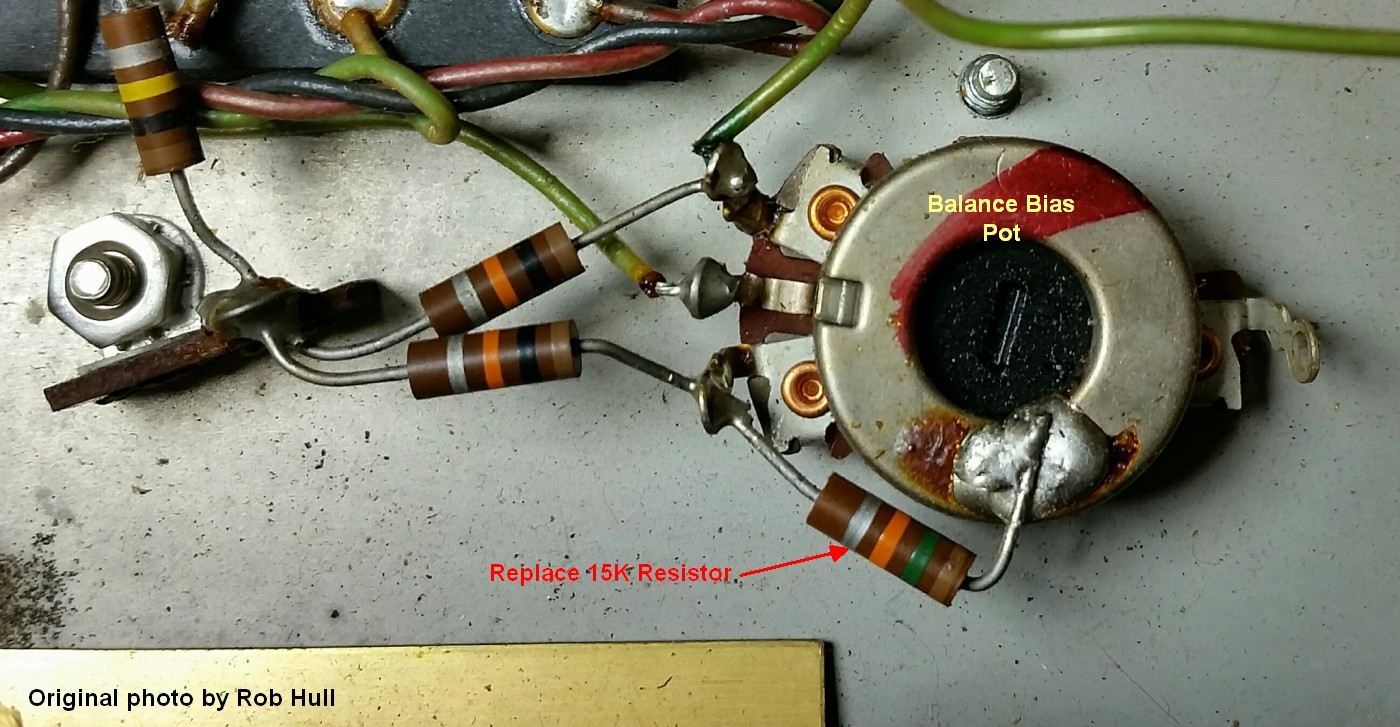
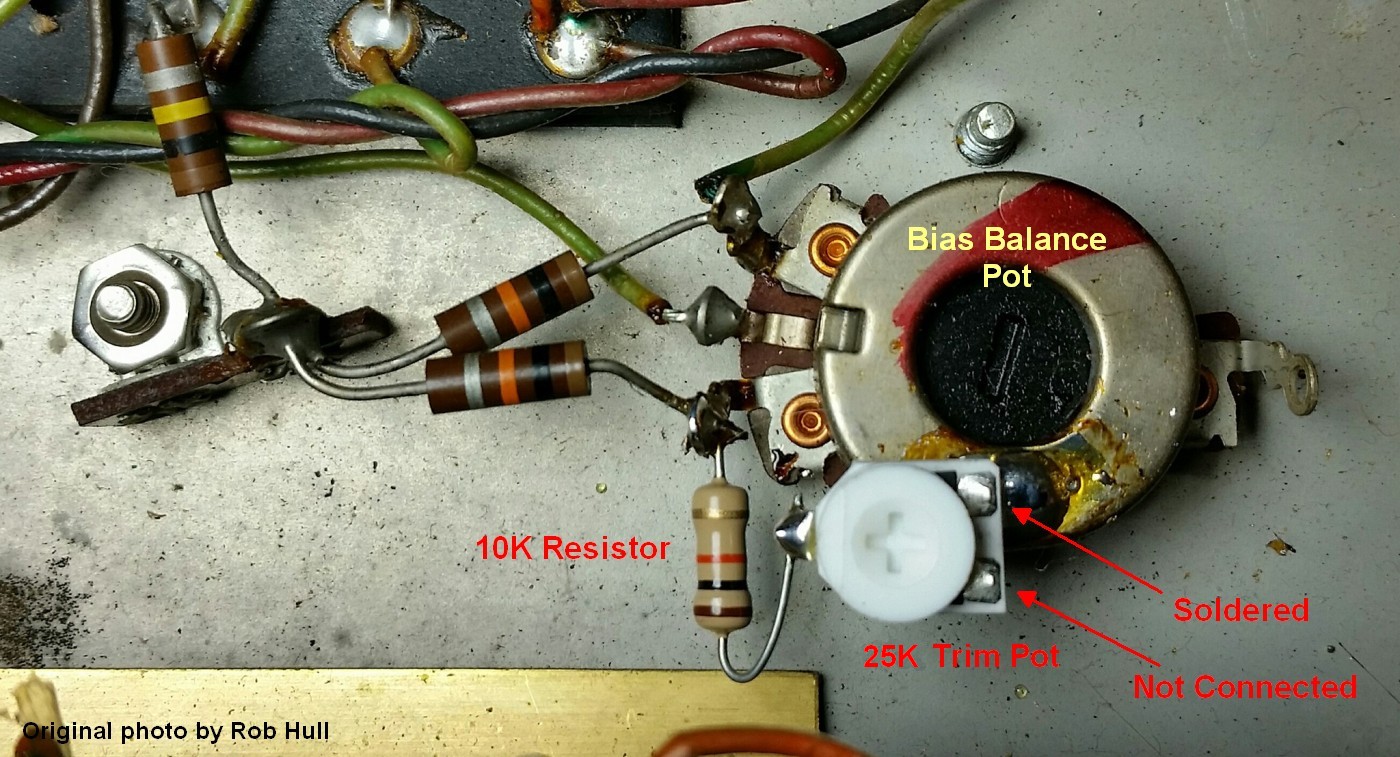
Replace the original 15k resistor with a 10k resistor + 25K trim pot. Set the trim pot to maximum resistance (full counter-clockwise) before installing so the bias will be set to coolest. You must bias the amp after this mod. The trim pot's upper right terminal is soldered to the back of the bias pot for a ground connection. The trim pot is wired as a variable resistor with the trim pot's lower right terminal not connected to anything. Notice how in this circuit the Bias pot's rear center tap terminal is not used. Mod and photos by Rob Hull.
Watch closely for power tube red plating when you start the amp up after this mod in case you set the bias trim pot incorrectly. You will need to bias the amp after this mod. See this for info on biasing an amp.
robrob Normal Channel Reverb Mod
This is my recommended mod to add reverb and tremolo to the Normal channel in blackface and silverface amps. Using this method we join the two channels using their own coupling caps and mixing resistors in a relatively noninvasive way. With each channel using a coupling cap and mixing resistor to feed the reverb circuit and V4B preamp, both channels' output are perfectly balanced with minimum attenuation and channel interaction.
By preserving the Normal channel coupling cap we can use it to voice the channel such as in the Lead Channel Mod. The robrob Reverb Mod is also superior to the "Fritz Mod" and Fender Reverb shown in the next section because retaining both mixing resistors prevents the severe signal attenuation and channel interaction that occurs with the other reverb mods. The robrob Reverb Mod does not affect the Vibrato Channel's tone at all. This mod also puts the two channels in phase so you can jumper the channels together for a slightly thicker tone. This is an excellent mod and I highly recommend it. This mod is also easy to reverse if you ever want to return to the stock Fender circuit.
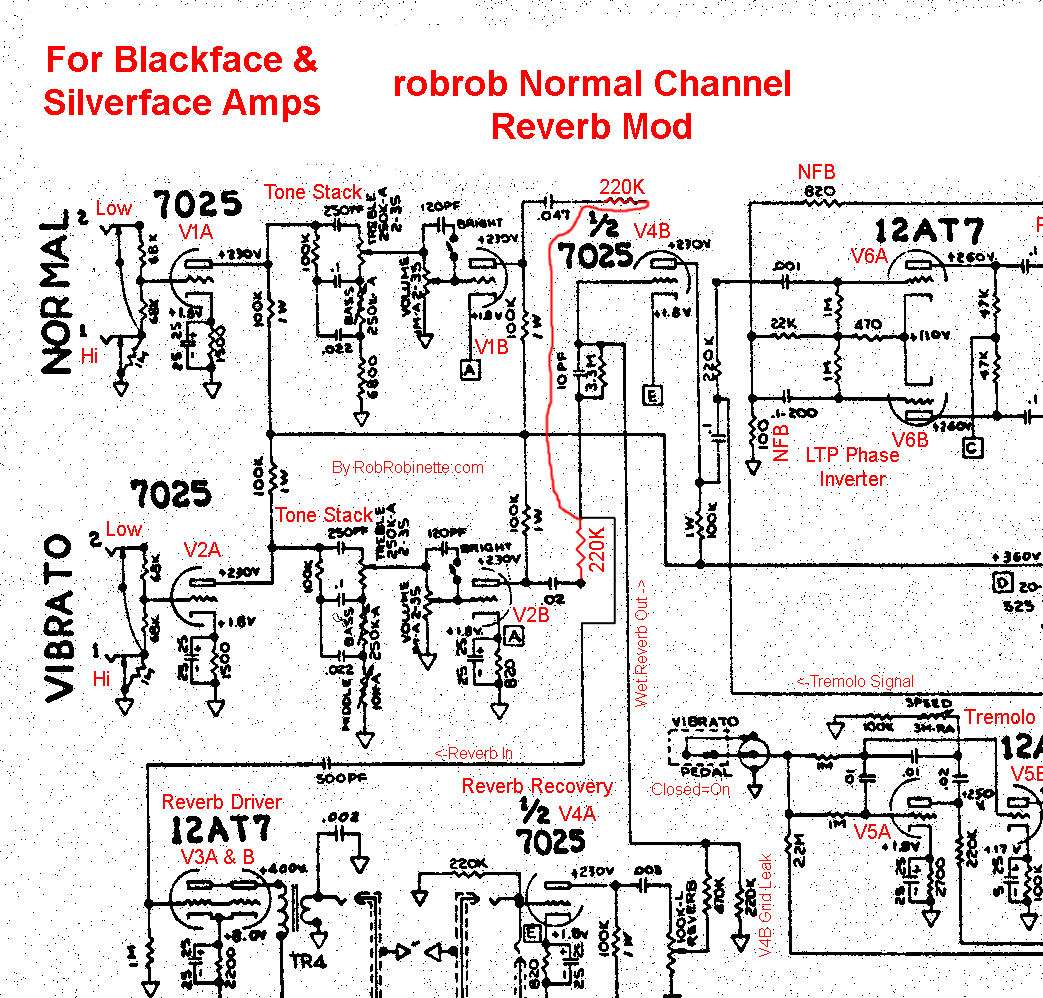
Both channels have a coupling cap and mixing resistor feeding the reverb circuit and the V4B preamp stage. The mixing resistors prevent channel interaction.
Here's the mod, refer to the layout below:
Note: if you're going to do the Lead Channel Mod then do it first because this mod moves the Normal channel coupling cap across the cathode resistor and bypass cap.
1. Desolder and pull the Vibrato channel .02uF coupling cap output end loose and bend it upwards, then tie the coupling cap loose end to the empty eyelet with a new Vibrato channel 220k 1/2 watt mixing resistor. Insert another 220k 1/2 watt mixing resistor for the Normal channel into the same eyelet as the new Vibrato channel 220k mixing resistor and solder them both into the eyelet.
2. Desolder and pull the Normal channel's .047uF cap's output end and bend it toward the new Normal channel mixing resistor from step 1, solder the .047uF coupling cap to the new Normal channel 220k mixing resistor.
If you want to change the Normal channel cap's value then simply remove the original cap and solder in the cap of choice as shown in the layout below.
3. The Normal channel original 220k Channel Mix resistor (below at far left) is not in the new circuit so it should be disconnected to prevent the long wire run across the board from becoming an antenna. Leave the Vibrato Channel original 220k Channel Mix resistor in place because it affects the phase inverter's overdrive tone.
robrob Normal Channel Reverb Mod
The Normal channel's coupling cap + new 220k mixing resistor easily span the distance to the Vibrato channel's new 220k mixing resistor. Remember to disconnect the original Normal Channel 220k Channel Mix resistor (at far left).
Fender Normal Channel Reverb Mod
This simple mod is how Fender added reverb to the 68 Custom Deluxe Reverb's Normal channel. It routes a silverface amp's Normal Channel through the reverb and tremolo effects and through the V4B third preamp gain stage. It does this by simply connecting the two channels' second triodes' plates together (see schematic below). This mod also puts the two channels in phase so you can jumper the channels together for a slightly thicker tone. This mod removes the Normal Channel's .047uF coupling cap and both channels' guitar signal flow through the Vibrato Channel's .022uF coupling cap. This method of running both channels through reverb and tremolo does not use mixing resistors so the two channels affect one another which can cause fluctuating attenuation and distortion. This is why I recommend the method above.
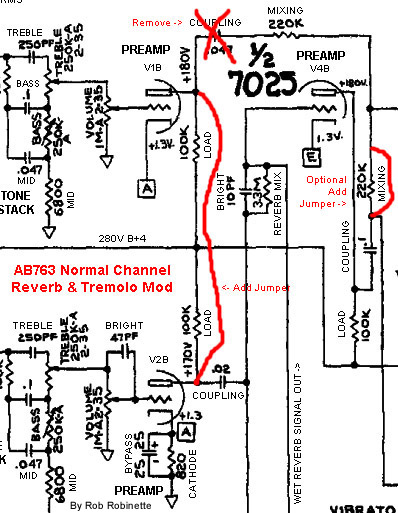
This mod directly connects V1B and V2B's plates which allows some unwanted channel interaction.
To send the Normal Channel signal through the reverb and tremolo you connect the V1B and V2B plates at the bottom (input, nearest tubes) of the two coupling caps. You must also clip or remove the V1B .047uF coupling cap on the right. Save the cap in case you ever want to reverse this mod. I also recommend jumpering around the now unneeded Vibrato channel 220K channel mixing resistor (at far left) for a slightly boosted, slightly brightened tone. You can use a temporary alligator clip lead to try the mixing resistor bypass. Click the image to see the full size version. Original photo by John Chabalko.
You can try this mod by unsoldering either end of the coupling cap (above right) and using a temporary alligator clip jumper.
This mod is already done in the 68 Custom Deluxe Reverb.
Lead Channel Mod
Many silverface players never use the Normal Channel since it has lower gain and no effects. If you don't use it you should consider voicing it as a "lead" channel by changing out only four components. Three of these component changes are straight from the 1987 Marshal "Plexi" lead channel preamp. They filter out excess bass frequencies that tend to boom or get muddy when severely overdriven. You will also gain some clean headroom and maximum volume because low frequencies use up a lot of the amps power so removing very low frequencies allows more amplification of the remaining audio frequencies.
With these four changes you can push the Lead Channel very hard with gain and boost pedals and get a nice, tight, modern overdrive tone. Reverb and delay effects and hot humbucker pickups will also sound better through this "lead" channel because the reduction in low frequencies will keep the amp from being overwhelmed. This mod will also make the channel more pedal friendly in general. You'll also get a really nice effect when you jumper the channels together. I really love the Lead Channel Mod.
When evaluating this mod be sure and try a boost pedal to get the gain and distortion up--this is when this mod really shines. The Lead Channel mod will not affect the Vibrato Channel.
Here's an excellent demo showing the difference between the 5E3 unmodified Bright channel and the "Lead Channel:" kdj 5E3 Lead Channel YouTube Demo The difference between the Vibrato and "Lead Channel" won't be quite so stark in a silverface.
The 2.7k cathode resistor is used in many high gain preamps and will bias the preamp cool and make creamy asymmetric distortion more likely. The 2.7k cathode resistor also boosts gain when paired with a 220k plate load resistor. The smaller .68uF bypass cap will boost more mids and highs for an apparent reduction of very low freqs. The V1A 220k 1 watt plate load resistor will add gain to the channel's first preamp gain stage and make overdrive more likely in the amp's following gain stages. Using a 1 watt plate load resistor will reduce resistor temperature and hiss. We reduce the V1B .047uF coupling cap to .0047uF 450V (or higher voltage) to again filter some low frequencies for tighter overdrive.
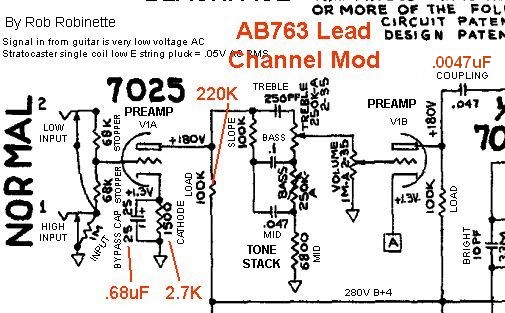
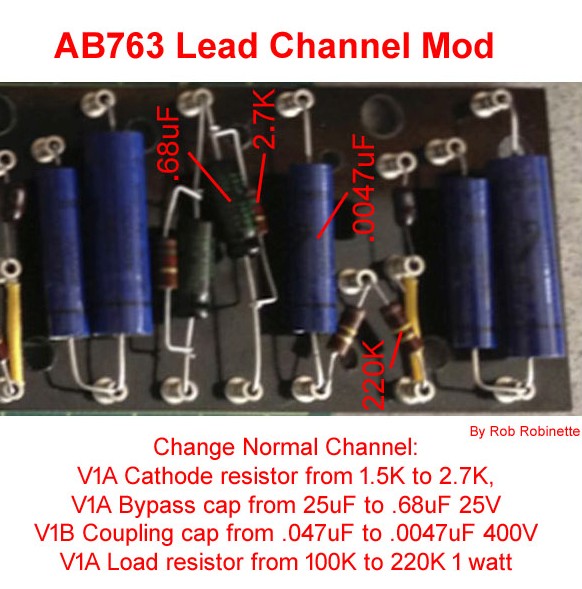
For the mod you increase the V1A cathode resistor from 1.5k to 2.7k (1/2 watt), reduce its bypass cap to .68uF (micro Farad) 25v, increase the plate load resistor from 100k to 220k 1 watt and reduce the big V1B .047uF coupling cap to .0047uF 450V (or higher voltage).
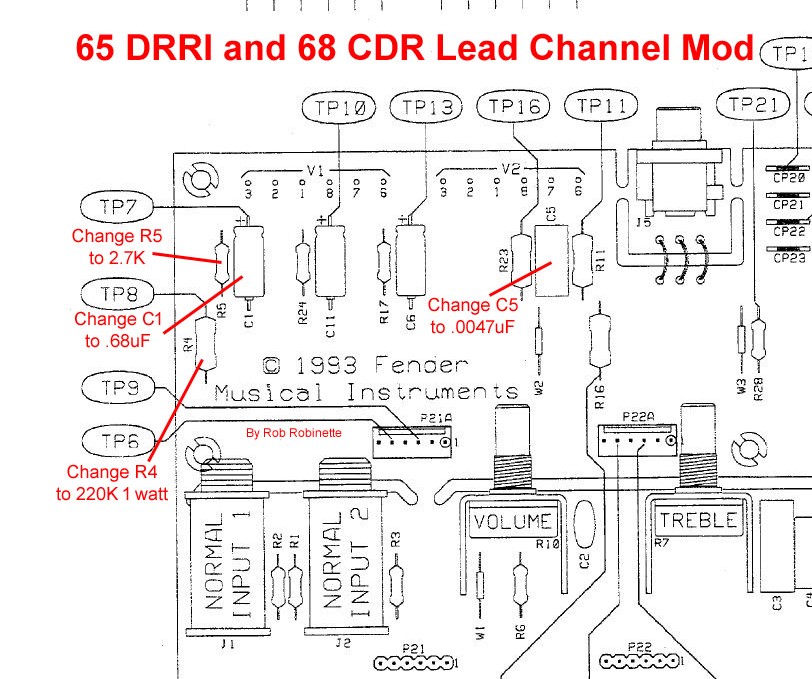
68 Custom Deluxe Reverb V1A cathode resistor is R5. The V1A cathode bypass capacitor is C1. The V1A plate load resistor is R4. The V1B coupling capacitor is C5. On the 68 CDR cap C5 is deleted so don't worry about it. The circuit board has these parts labeled.
3-Way Negative Feedback Switch
Silverface amps use an 820 ohm negative feedback (NFB) resistor to set the level of feedback. The reissue 68 Custom Deluxe Reverb cuts NFB in half by using a double size 1.5k NFB resistor. The NFB switch fundamentally changes the clean and overdrive tone of the amp. Playability and touch sensitivity are also changed in all three positions. This is a great modification and will really make the amp more versatile.
I like to use the 3-way ON/OFF/ON SPDT Ground Switch to give you: Normal/Light/Heavy negative feedback. You can leave the old 820 ohm NFB resistor in place on the circuit board.
Normal - Light - Heavy 3-Way NFB Switch
The 3-Way NFB Switch gives you "Normal", "Light" and "Heavy" NFB options. The center position uses only the 1.5k resistor for "Light" NFB (half of normal NFB). The right switch position parallels the 1.8k and 1.5k resistors for factory or "Normal" 820Ω of NFB resistance. The left position parallels the 1.5k and 820Ω resistors for 530Ω of "Heavy" NFB resistance. If you don't want to use the Ground Switch for NFB I suggest installing an SPDT ON/OFF/ON mini switch next to the tremolo intensity pot or on the back panel.
Another Switch Configuration
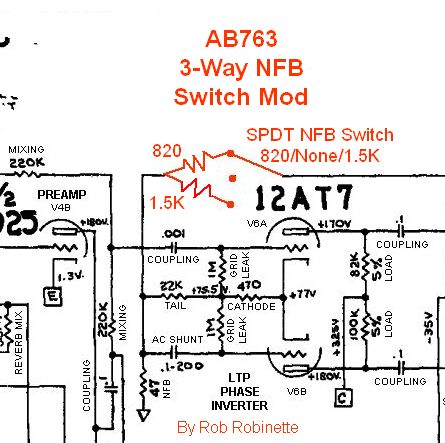
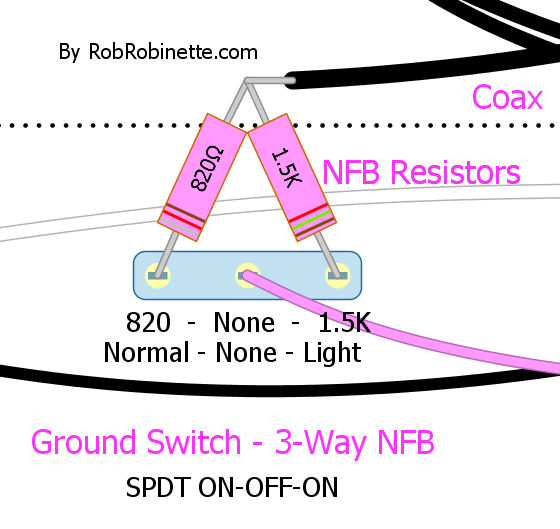
If you want a "No NFB" switch position then wire the switch like this. With the switch to the right you get Normal NFB with an 820 ohm resistor. Switch in the middle positions disconnects NFB. In the left position we get the 68 CDR "Light" NFB with a 1.5k resistor.

For the 65 Deluxe Reverb Reissue & 68 Custom Deluxe Reverb the negative feedback resistor is R64. It is 820 ohms for the '65 and 1.5k for the '68. The circuit board has this part labeled.
Trainwreck Type-2 & Type 3Master Volume Mods
The Trainwreck Type-2 is a very "transparent" master volume which virtually disappears when at max master volume setting. It is much more difficult to add to an existing amp so for modding an existing amp I recommend the Type-3 master volume.
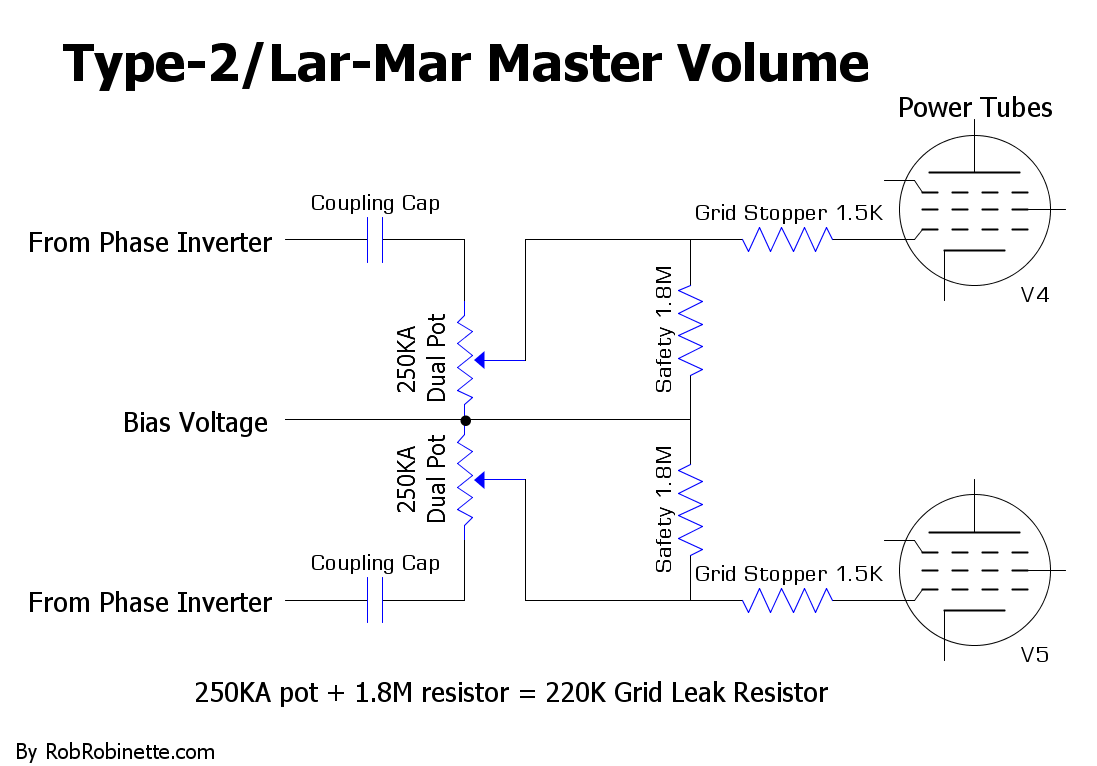
When the master volume is turned down the guitar signal is bled to ground through the bias circuit. The 1.8M Safety resistors allow bias voltage to pass around the master volume pot in case of a wiper failure. The resistors also lower the max grid leak resistance to 220k to match the stock grid leak resistors. If you can't find the 1.8M resistors you can substitute 2M.
Type-2/Lar-Mar Master Volume
A dual gang 250KA pot (one shaft turns both pots, audio or log taper) replaces the two 220k power tube grid leak resistors. This is the most transparent of all the master volume types. The 1.8M resistors on the Master Volume pot reduce the pot resistance to 220k (the stock value) and add a failsafe path for bias voltage. If you can't find a 1.8M resistor you can substitute 2M.
Trainwreck Type-3 Master Volume
The Trainwreck Type-3 Post Phase Inverter Master Volume (PPIMV) is very easy to install and it works about as well as any other master volume I've tried in any of my amps. This master volume controls the signal level feeding the power tubes so you can use it for lower volume distortion and to control the balance between preamp and power tube distortion. It works by mixing the two phase inverter output streams together and they cancel each other out. Less resistance = more signal mix and less output volume.
For the Type-3 master volume you simply add a 1 mega ohm audio (log) pot and two wires. It's easy to temporarily alligator clip the pot into the circuit to give it a try. When the Master Volume pot is set to max the master volume circuit virtually disappears and will not color the amp's tone.
You can place your master volume pot anywhere but you may have to use shielded wire to prevent noise or oscillation. I use RG-174 when I need shielded coax in an amp but two conductor shielded wire makes for a very tidy installation. Only ground one end of any coax cable in an amp, preferably the signal input end, to keep from forming a ground loop. If you keep the wire runs relatively short and away from the power transformer end of the amp you should be OK without using shielded coax.
Simple But Effective Trainwreck Type 3 Post Phase Inverter Master Volume (PPIMV)
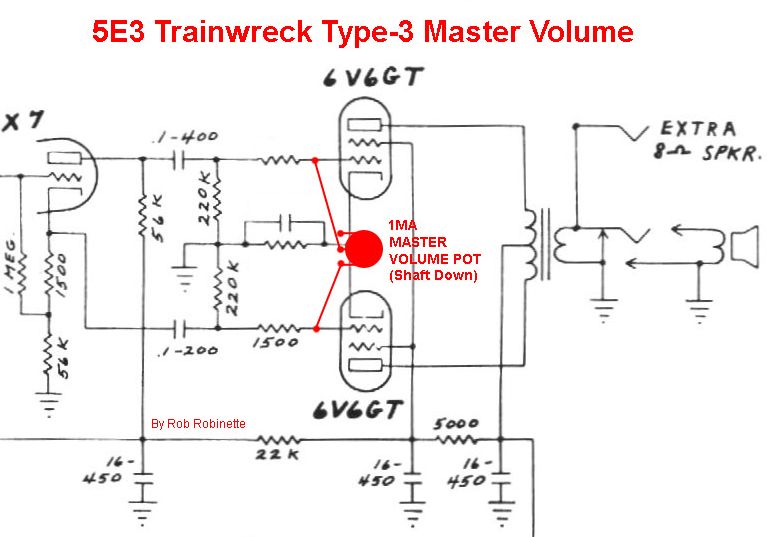
Add a 1 megaohm audio (log) pot and two wires and you've got an effective post phase inverter Master Volume. As you turn the Master Volume pot down (counterclockwise, pot is shown shaft down) more of the opposite phase signals from the phase inverter are mixed together which cancels the signal out. I did this mod to my 5F6A Bassman and it works great.
5F6A Trainwreck Type 3 Post Phase Inverter Master Volume (PPIMV)
Add a 1 megaohm audio (log) pot and two wires and you've got an effective post phase inverter Master Volume. As you turn the Master Volume pot down (counterclockwise) more of the opposite phase signals from the phase inverter are mixed together which cancels the signal out. The pot is shown shaft down in the layout. The layout shows a 5F6A Bassman but the connection is the same at the power tube grid leak resistors.
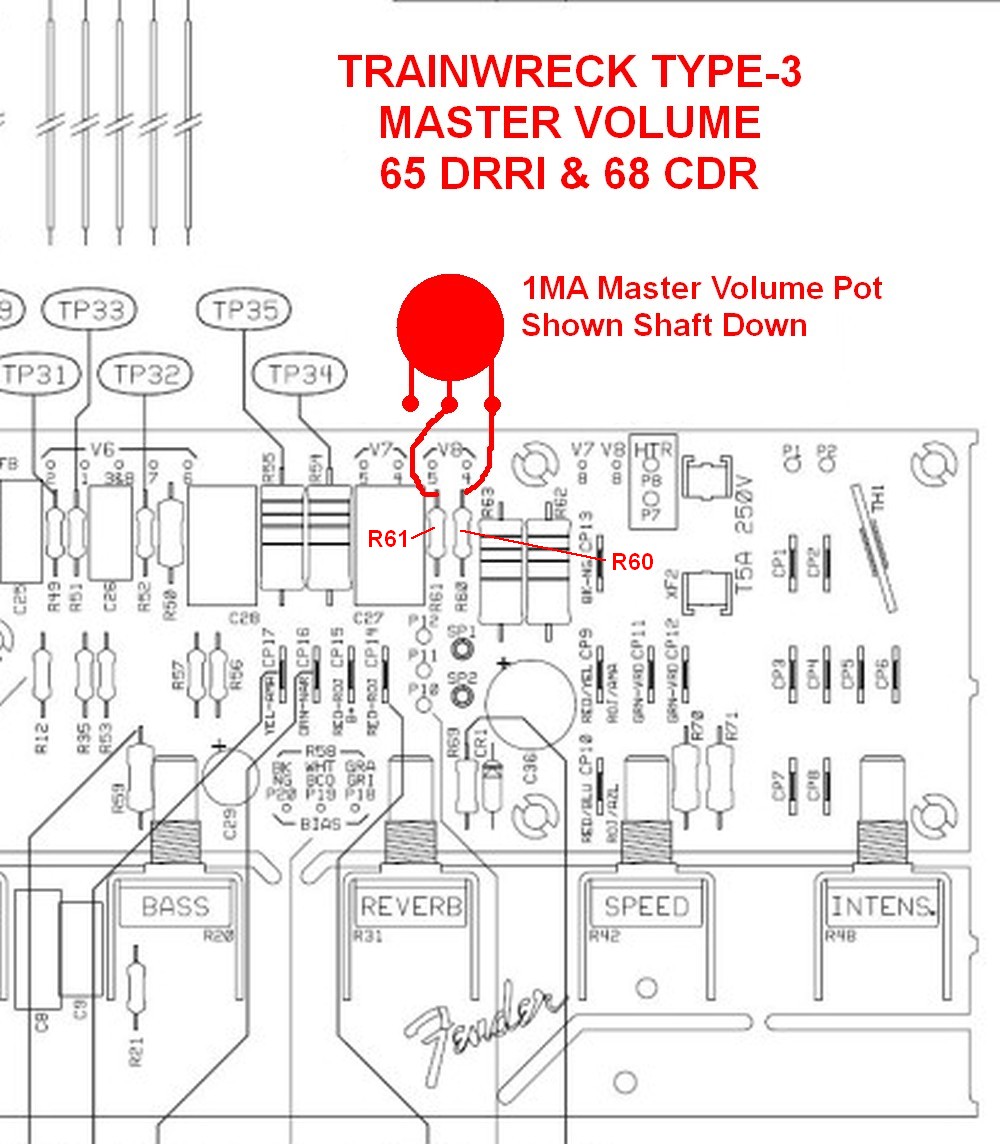
If you are anal you can completely eliminate the Type-3 from the amp circuit by adding a switch to disconnect the circuit. Use a 250KA pot with a push-pull DPDT switch and wire one leg of the master volume through the switch so when the master volume knob is down the circuit is completely disconnected. Pull the knob up to activate the master volume. A 250KA pot will give you a better volume sweep than a 1MA and since we can disconnect the MV we don't have to worry about the 250KA pot affecting the amp tone.
To do this you would run the wire from the #2 (center) pot terminal to the upper left DPDT switch terminal, then run a wire from the middle left DPDT switch terminal to the circuit board's right 220k resistor. The wire from the #1 (left) pot terminal would be wired as normal to the left 220k resistor (see layout below).
Type-3 With MV ON/OFF Push-Pull Pot
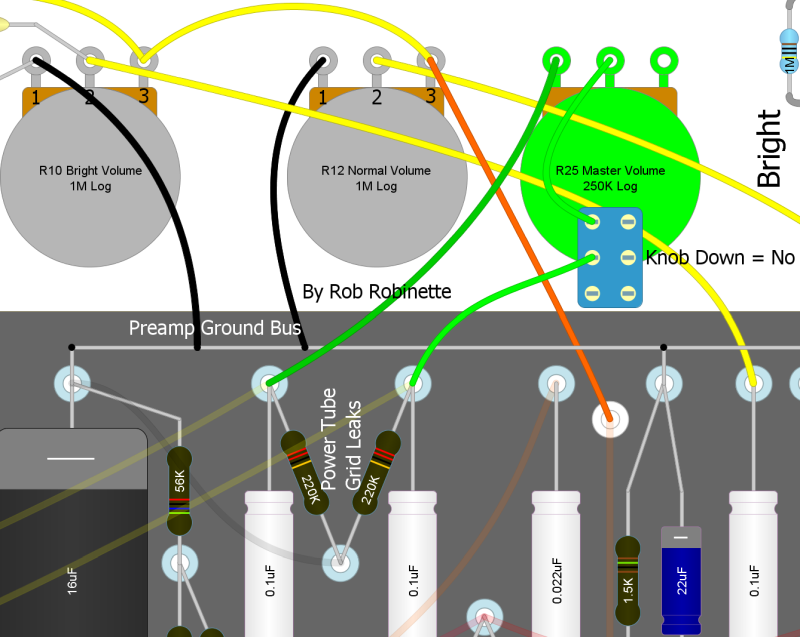
Master Volume knob Down = no master volume at all, Up = master volume on. This diagram shows a 5E3 Deluxe but the push-pull switch wiring is the same.
Another option is to use a switch and resistor for your master volume instead of a pot. You simply replace the master volume pot with a resistor on a switch. One guy used a 5k 1/2 watt resistor which gave him his preferred "bedroom practice" output level. Switch OFF = no master volume at all, ON = bedroom volume.
VOX Cut Control & Cut Control + Master Volume
The VOX Cut Control connects the two power tube grids with a 250k audio pot and 4.7nF (.0047uF 400v) capacitor to allow variable high end cut. In a push-pull amp the guitar audio signals on the two power tube grids are 180 degrees out of phase with one another so mixing them together nullifies the signal, kind of like mixing matter and antimatter. The capacitor limits the effect to high frequencies but if you jumper around the cap the pot becomes a Trainwreck Type-3 Master Volume.
I'm a big fan of this very late tone tweak because it pairs well with an early tone stack. Use the early tone control to get the overdrive tone and substance you want then use the Cut Control to fine tune the tone. The Cut Control affects only the power tubes.
Wire the cut pot as a variable resistor so that as you turn the knob up (clockwise) resistance increases. Up = more resistance = brighter tone.
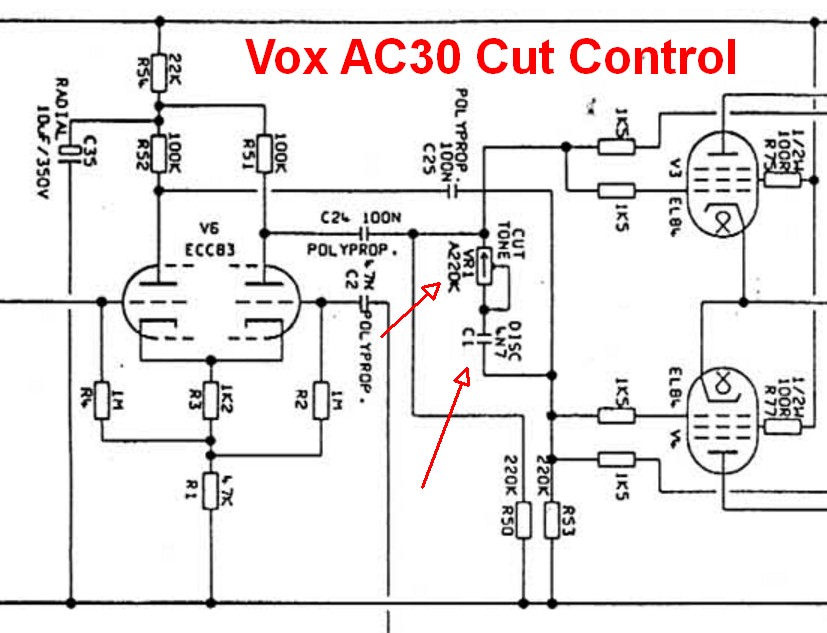
250KA pot (audio pot wired as variable resistor) and .0047uF 200v cap connect the two phase inverter outputs.
Cut Control on 5F6A Bassman
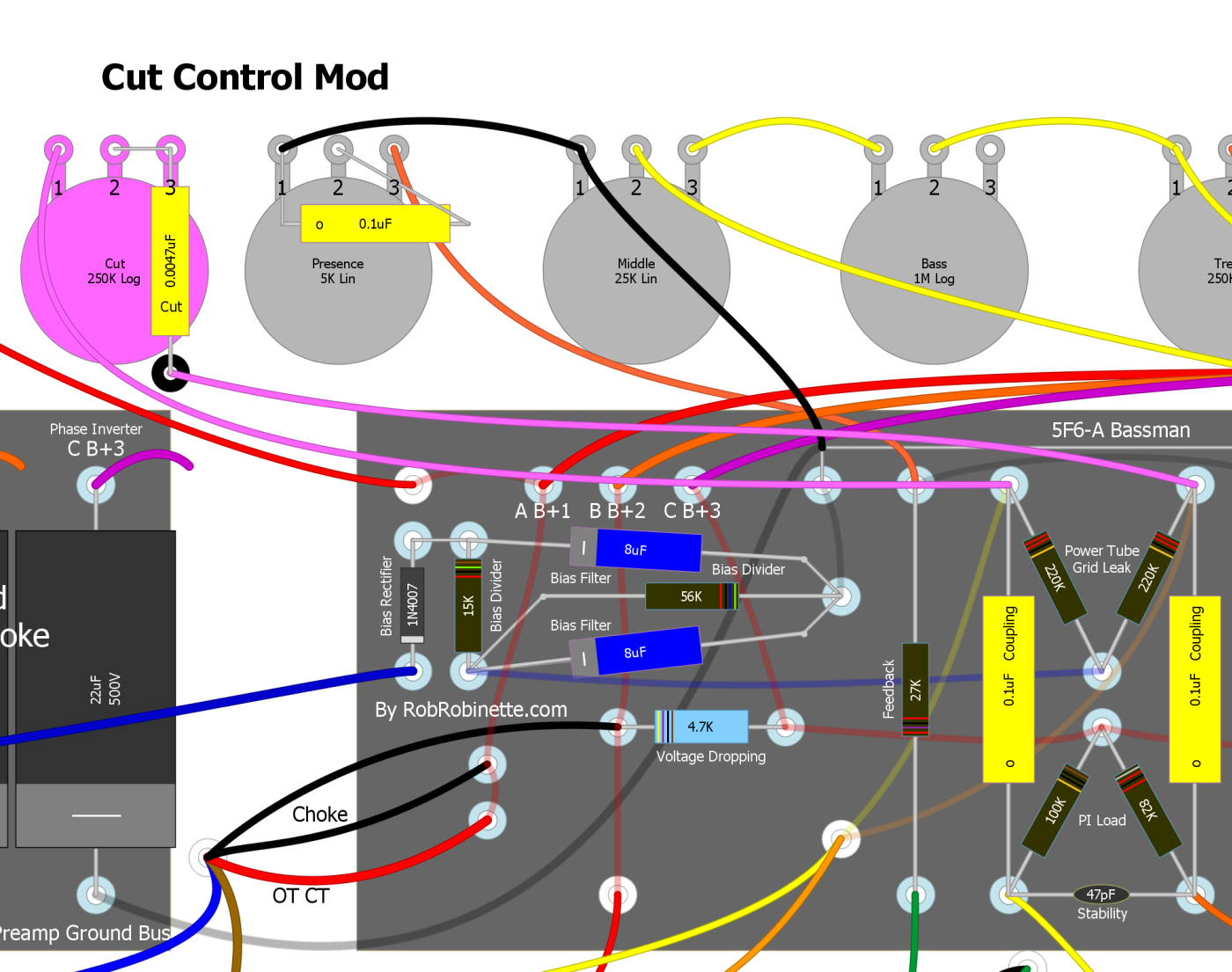
The Cut Control is shown on a 5F6A but the mod is almost identical on silverface amps. In many silverface amps one of the 100k grid leak resistors is mounted near the Bias Balance pot. The .0047uF Cut Cap can be supported by a non-grounded terminal strip.
Master Volume + Cut Control Push-Pull Pot Mod
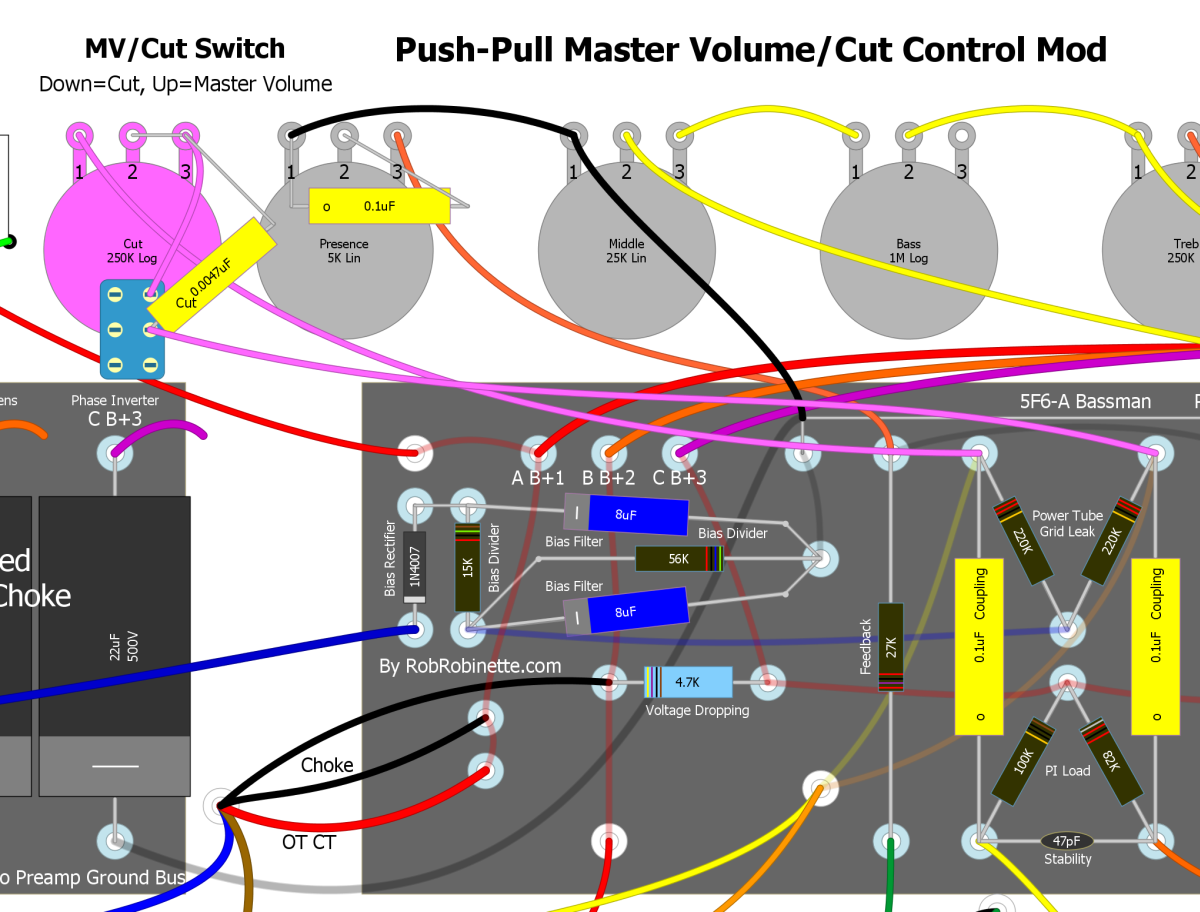
You can turn a Cut Control into a Trainwreck Type-3 Master Volume by simply jumpering around the Cut Cap. Use a 250KA push-pull pot and you can push the pot down for Cut Control or pull it up for Master Volume. Connect the "cut capacitor" from pot terminal #3 to the middle switch terminal. Pulling the knob up bypasses the Cut Capacitor which transforms the circuit from Cut Control to Master Volume.
1/4 Power Switch
This very cool 1/4 Power Switch is from the 20 watt Fender Eric Clapton Tremolux. The switch cuts the amp's output power by 75%, down to about 5 watts. The switch places an 8 ohm 25 watt resistor in series with the 8 ohm amplifier speaker (for a total of 16 ohms and a 50% cut in power), then places a 16 ohm 25 watt resistor in parallel to bring the total speaker load back down to 8 ohms and gives another 50% cut in power. The two resistors turn 3/4 of the amp's output signal into heat. With the switch in the "Normal" position the 8 ohm resistor is bypassed and the 16 ohm resistor is disconnected.
The Eric Clapton Tremolux is a 2x6V6 fixed bias amp putting out about 20 watts so this circuit will work with any amp with similar or lower output.
You can use the 1/4 Power Switch with the internal speaker and an external cab simultaneously but the speakers' load will drop to 4 ohms so most of the power will bypass the 16 ohm resistor and flow through the 8 ohm resistor and speakers. Total load on the output transformer drops to 6.8 ohms but the Fender 8 ohm transformer is designed to work with two parallel speakers at a 4 ohm load so it's not a problem.
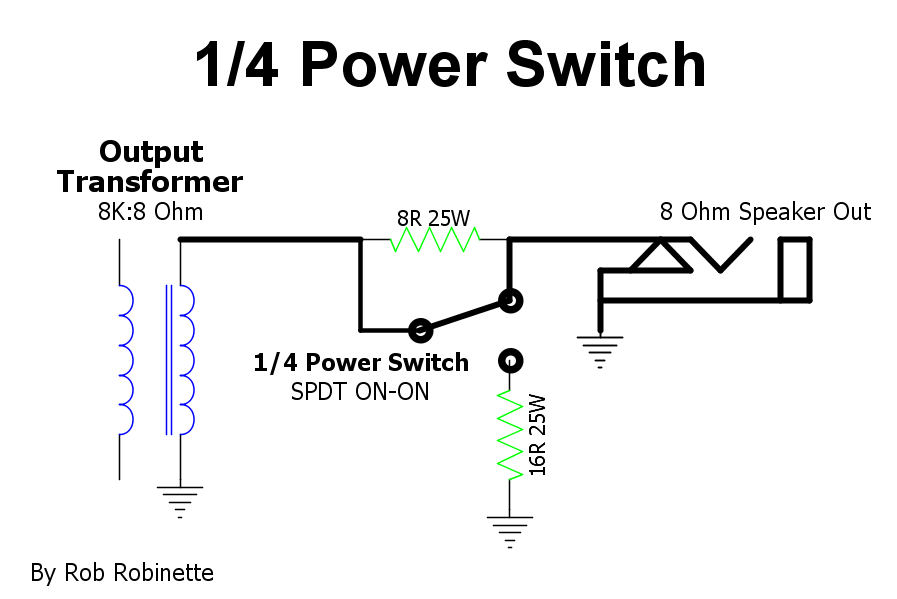
The 8 ohm 25w resistor is placed in series with the amplifier speaker and the 16 ohm 25 watt resistor is placed in parallel to bring the total speaker load back down to 8 ohms. If your amp does not have an Aux speaker jack just connect the 16 ohm resistor and switch wire to the speaker jack's Tip and Ground terminals.
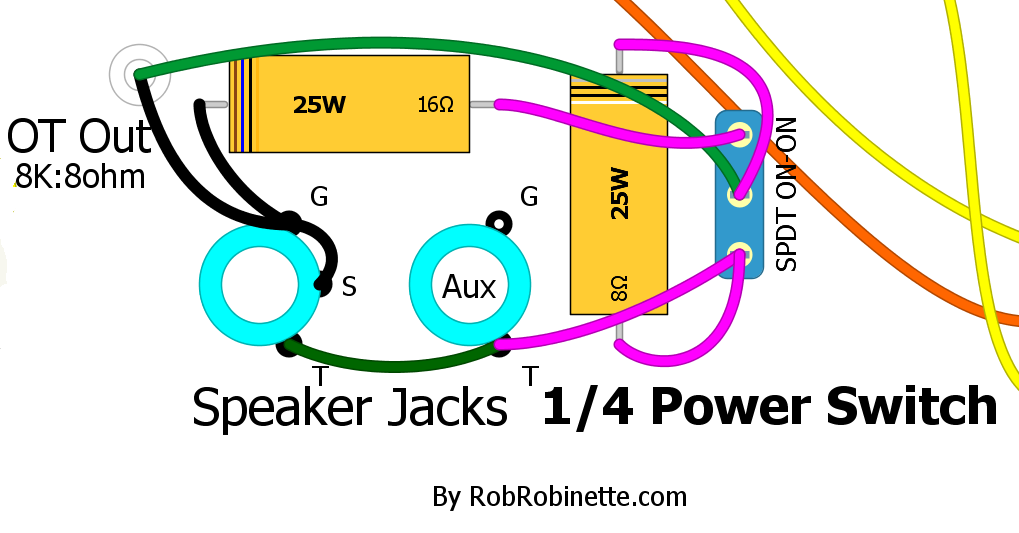
T=Tip and G=Ground.
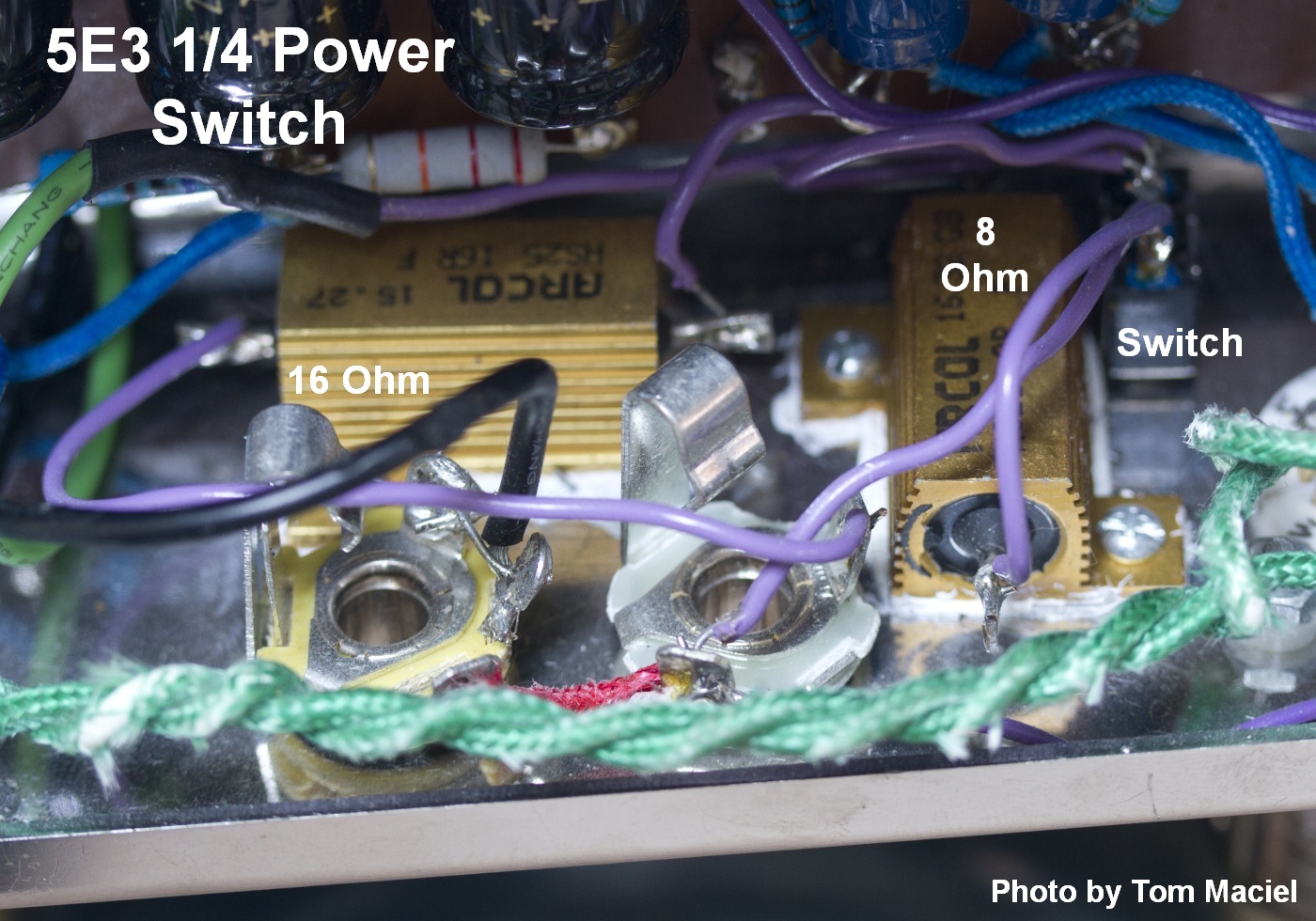
Large, gold colored 25 watt chassis mount resistors with 1/4 Power Switch at upper right. Photo by Tom Maciel.
Mouser.com: 8 ohm 25 watt wire wound chassis mount resistor, 16 ohm 25 watt resistor. The resistors are about $3 each.
These are chassis mount resistors and should be screwed or bolted to the chassis to dissipate heat. If they are not bolted to the chassis their heat rating drops to about 5 watts.
For a 4 ohm output transformer secondary change the resistors to a 4 ohm 25 watt and 8 ohm 25 watt.
For a 16 ohm output transformer secondary change the resistors to a 16 ohm 25 watt and 32 ohm 25 watt.
For a 1x6V6 cathode biased amp like the 5F1 Champ 10 watt chassis mounted resistors would be fine.
10% Power Switch
Several builders have complained that the 1/4 Power Switch shown above, which cuts 75% of the output power, only sounds like a 30 to 50% volume cut due to how our ears perceive volume. If you really want near-bedroom volume levels then a 90% cut in power can be attained by using a 16 ohm 25W resistor for the upper resistor and a 12 ohm 25W resistor for the lower resistor (8 ohm output transformer secondary). The 12 ohm resistor will burn most of the amp's output so for anything more powerful than a cathode biased push-pull 6V6 amp like the 5E3 Deluxe you'll need to bump the 12 ohm resistor's power handling to 50 watts to be safe (two 25 ohm 25 watt resistors in parallel will work).

90% of the amp's output power will be converted to heat.
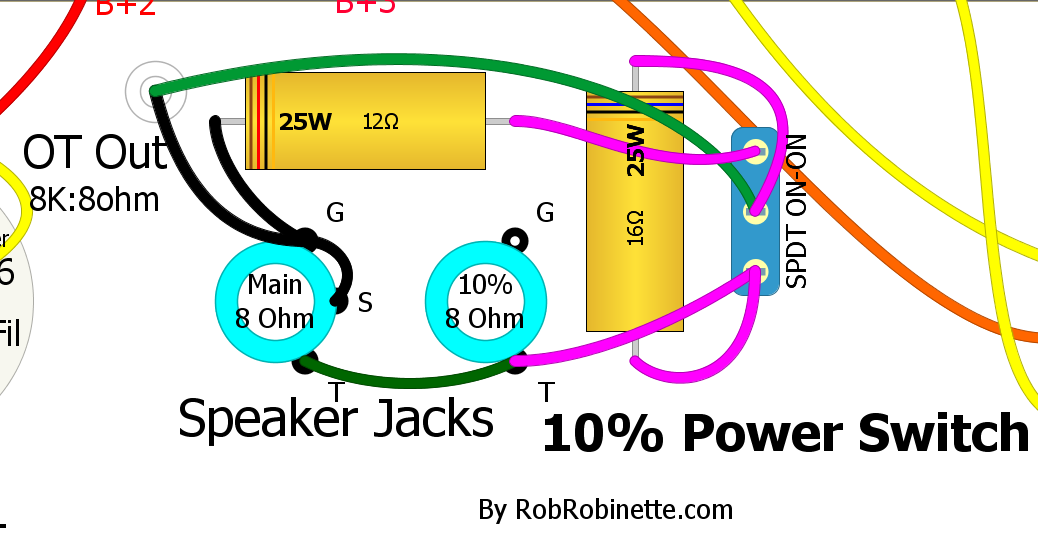
With the switch set to 10% both jacks will be 8 ohm with 90% of the amp power turned into resistor heat. These 25 watt resistors are adequate for 15 watt amps such as a 5E3 Deluxe or other cathode biased 6V6 push-pull amps.
These are chassis mount resistors and should be screwed or bolted to the chassis to dissipate heat. If they are not bolted to the chassis their heat rating drops to about 5 watts.
For 25 watt amps such as a blackface or silver face Deluxe or other fixed bias 2x6V6 push-pull amps I recommend 50 watt resistors (two 25 watt resistors in parallel will also give you 50 watts).
For 50 watt amps such as 2x6L6 amps I recommend 100 watt resistors (two 50 watt resistors in parallel will also give you 100 watts).
For a 100 watt amp such as 4x6L6 amps I recommend 200 watt resistors (two 100 watt resistors in parallel will also give you 200 watts). These would be difficult to stuff into an amp chassis.
For a 2 ohm output transformer secondary you would use 3 and 4 ohm resistors.
For a 4 ohm output transformer secondary you would use 6 and 8 ohm resistors.
For a 16 ohm output transformer secondary you would use 24 and 32 ohm resistors.
If your amp has a negative feedback loop then tap it from the main speaker jack tip connection.
10% Power Jack
You can wire your speaker aux jack as a 10% power output jack. This mod uses the circuit above but uses the main speaker jack switch to switch between full power and 10%.

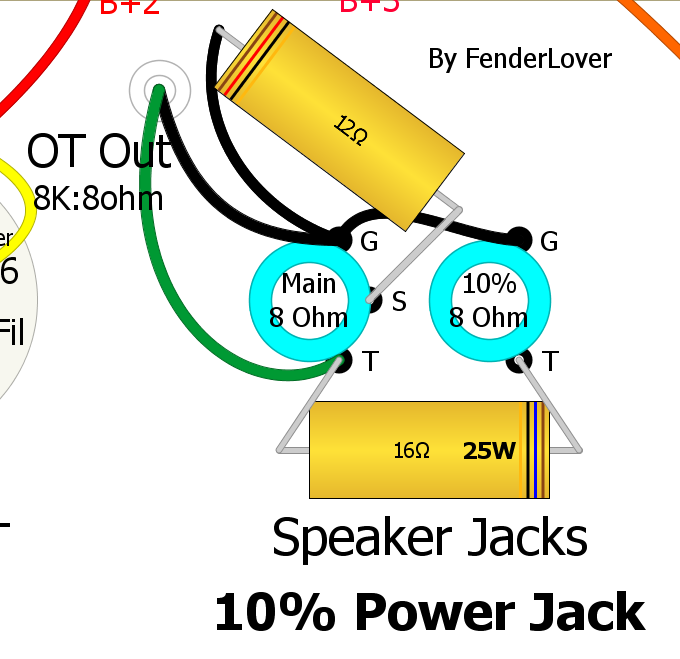
The main speaker jack on the left is 8 ohm full power. The 10% jack on the right is 8 ohm but 90% of the amp output power is burned in the two 25 watt resistors. These 25 watt resistors are adequate for 15 watt amps such as a 5E3 Deluxe or other cathode biased 6V6 push-pull amps.
These are chassis mount resistors and should be screwed or bolted to the chassis to dissipate heat. If they are not bolted to the chassis their heat rating drops to about 5 watts.
For 25 watt amps such as a blackface or silver face Deluxe or other fixed bias 2x6V6 push-pull amps I recommend 50 watt resistors (two 25 watt resistors in parallel will give you 50 watts).
For 50 watt amps such as 2x6L6 amps I recommend 100 watt resistors (two 50 watt resistors in parallel will also give you 100 watts).
For a 100 watt amp such as 4x6L6 amps I recommend 200 watt resistors (two 100 watt resistors in parallel will also give you 200 watts). These would be difficult to stuff into an amp chassis.
For a 2 ohm output transformer secondary you would use 3 and 4 ohm resistors.
For a 4 ohm output transformer secondary you would use 6 and 8 ohm resistors.
For a 16 ohm output transformer secondary you would use 24 and 32 ohm resistors.
If your amp has a negative feedback loop then tap it from the main speaker jack tip connection.
10% Power In External Box
This is the 10% power circuit in a box. The amp speaker out plugs into the IN jack and the speaker is plugged into the OUT jack.
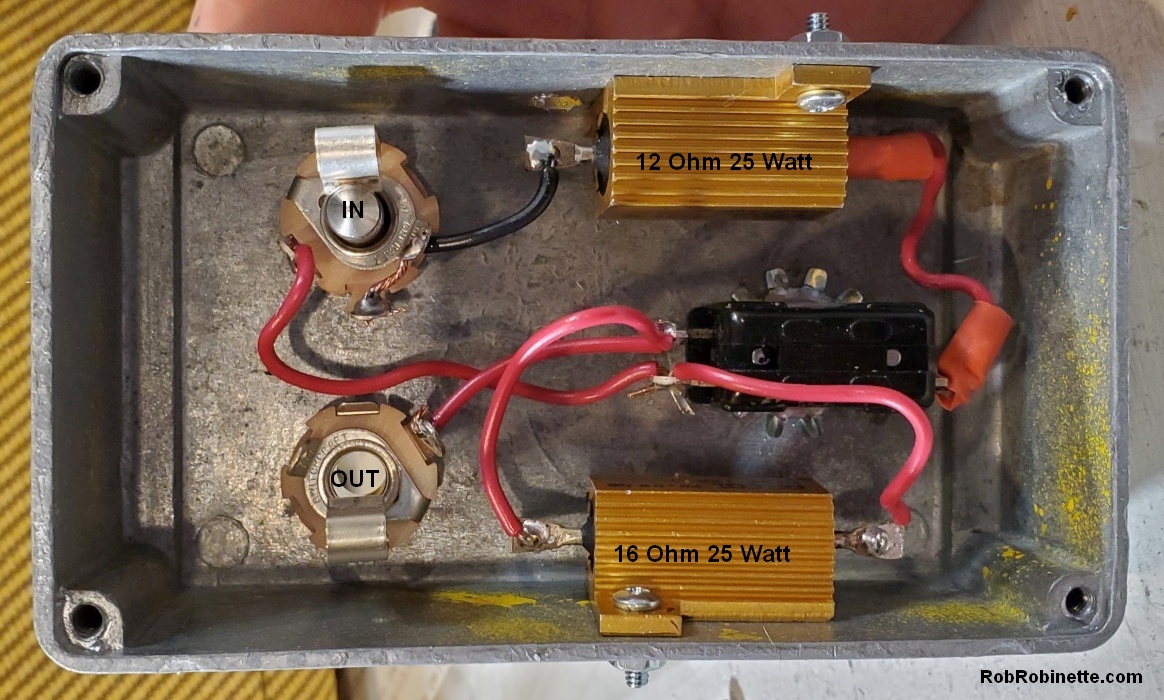
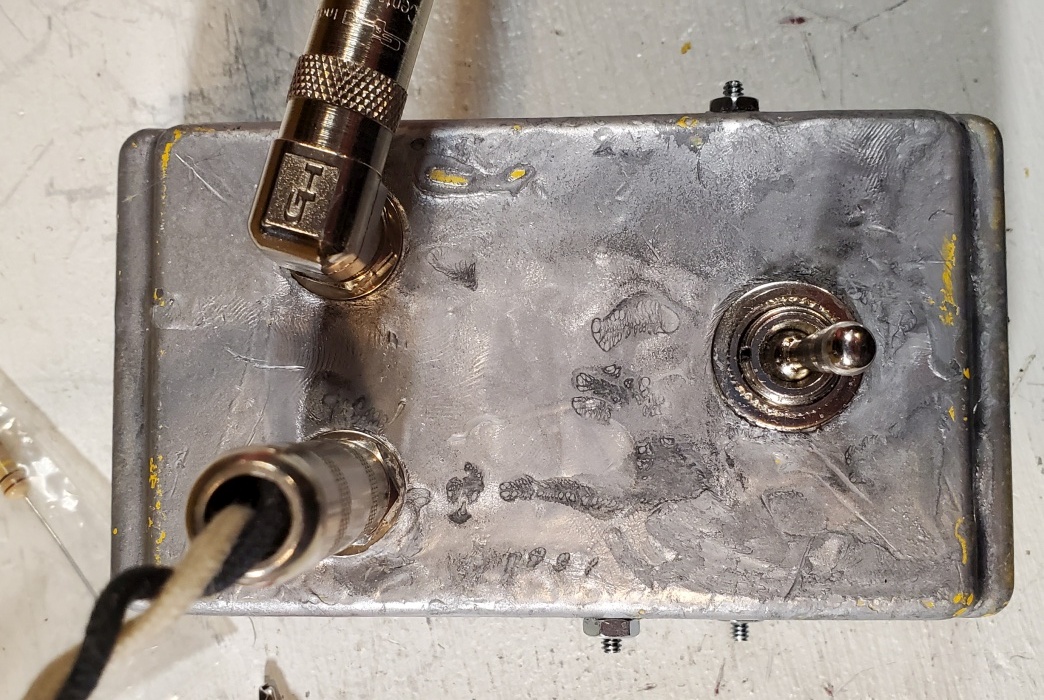
These are chassis mount resistors and should be screwed or bolted to the box to dissipate heat. If they are not bolted to the chassis their heat rating drops to about 5 watts.
For 25 watt amps such as a blackface or silver face Deluxe or other fixed bias 2x6V6 push-pull amps I recommend 50 watt resistors (two 25 watt resistors in parallel will also give you 50 watts).
For 50 watt amps such as 2x6L6 amps I recommend 100 watt resistors (two 50 watt resistors in parallel will also give you 100 watts).
For a 100 watt amp such as 4x6L6 amps I recommend 200 watt resistors (two 100 watt resistors in parallel will also give you 200 watts). I don't recommend this because the box would have to be really big to provide an adequate heat sink for the big resistors.
For a 2 ohm output transformer secondary you would use 3 and 4 ohm resistors.
For a 4 ohm output transformer secondary you would use 6 and 8 ohm resistors.
For a 16 ohm output transformer secondary you would use 24 and 32 ohm resistors.
1/2 Power Switch
This is a standard 'Pentode / Triode' type switch that lowers the power tube output for lower maximum volume. In reality this switch changes the 6V6 power tube from a pentode (5 electrodes: cathode, control grid, plate, screen grid and suppressor grid) to a tetrode (4 electrodes since the screen grid is deactivated) but by convention we call it a pentode / triode switch.
A triode tube's plate normally 'pulls' free electrons from the cathode but a triode's plate voltage fluctuates as it amplifies a guitar audio signal. When the plate voltage drops it does not pull electrons as hard as it does when the plate voltage is high. Adding a fixed, high voltage screen grid makes a tube much more efficient because the screen's constant strong pull of electrons does not drop when the plate's voltage drops so the tube flows more electrons.
The Half Power Switch (ON-ON DPDT mini switch) connects the power tube screens (pin 4) to B+2 (normal full power pentode) or to the power tube plates (pin 3 for half power 'triode' mode). Removing B+2 and tying the power tubes' screen and plate together deactivates the screen by allowing the screen voltage to fluctuate along with the plate voltage effectively creating a lower power 'triode.' Running a pentode in 'triode' mode definitely changes its clean and overdrive tone so it's more than just a 'half power' mode.
Half Power Switch in the BootHillAmps.com SixShooter
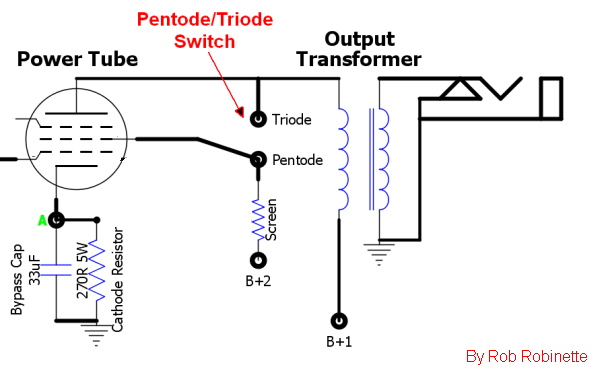
Power tube screen grid is connected to either the plate in the triode mode, or the B+2 screen power supply in the pentode mode.
This is a simple mod because there's room between the power tubes for the mini switch so the resistors can be connected directly between the tube sockets and switch. 470Ω 2 watt screen resistors are added to keep the screen voltage slightly lower than plate voltage. These resistors have no effect on amp tone but give the added benefit of protecting the power tubes from excessive screen current which can extend the life of your power tubes.
With the switch lever 'IN' you get normal full power. With the lever 'OUT' you get 'tetrode' half power.
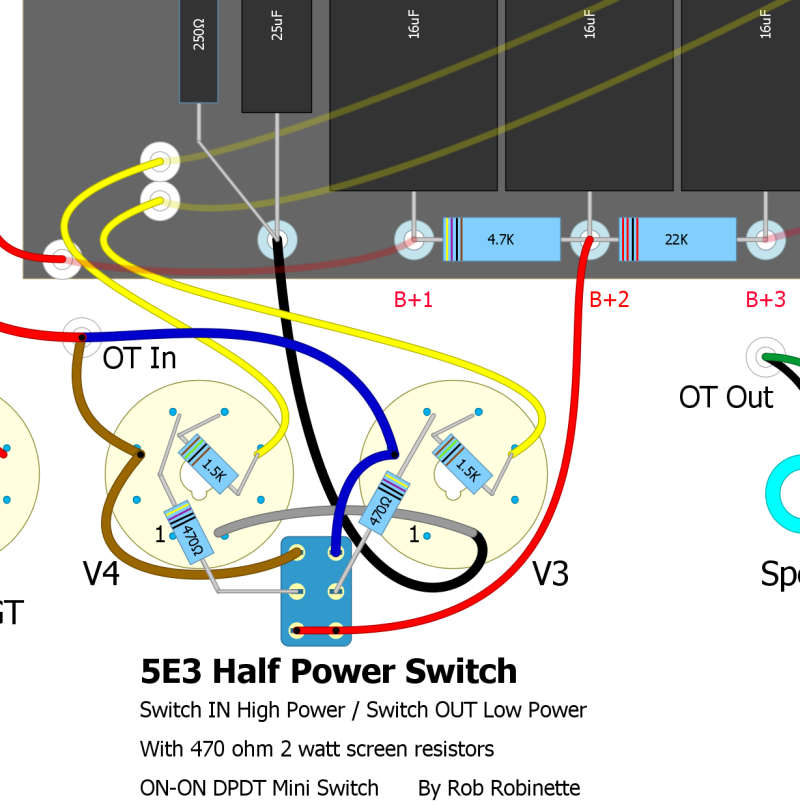
This is my recommended layout with 470Ω 2 watt screen resistors always in circuit to provide excess screen current protection.
Alternate Design With Screen Resistors Used only For Low Power
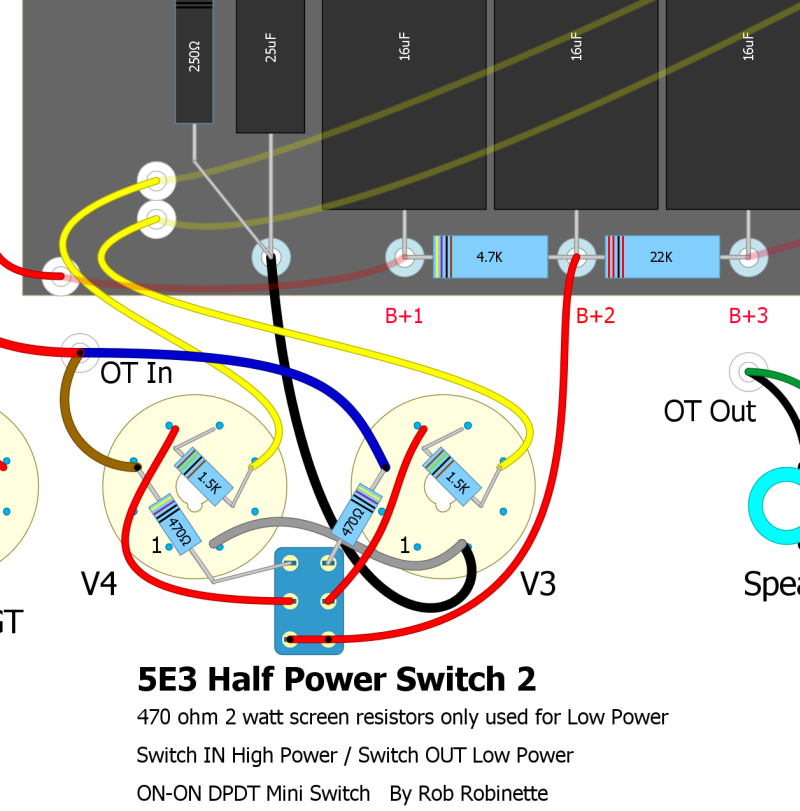
470Ω Screen Resistors moved to switch input so they are only used in the 'Low Power' switch position. Use this layout if you don't want to alter your 5E3's circuit with the switch in the normal 'High Power' position.
Add a Presence Control
I'm a fan of late-in-the-circuit tone controls which allow tone tweaks with less side effects and the Presence Control is one of my favorites. It's actually pretty easy to add a Presence Control to any blackface or silverface amp with a long tail pair phase inverter.
To add the Presence Control we'll delete the NFB Tail resistor and replace it with a 25KL pot with a .1uF (600v poly) cap and 4.7k 1/2 watt resistor. We also have to adjust the size of the NFB resistor and the phase inverter tail resistor (PI Tail in layout) to compensate for the presence control's added resistance (going from 47 ohm NFB tail to 4.7k of tail resistance). With this presence circuit you'll get standard Silverface tone with the presence pot turned full down.
The 4.7k presence resistor on the presence pot acts as the NFB Tail resistor. The .1uF cap blocks DC flow through the pot to eliminate "static" when adjusting the control. The cap also sends high frequencies from the NFB loop to ground which boosts highs at the speaker. These boosted highs have less NFB so they are "thicker and harrier" with additional harmonic and intermodulation distortion which adds "presence". Since the back of the presence pot is used as a ground be sure and use a star washer on the pot to ensure good pot-to-chassis contact.
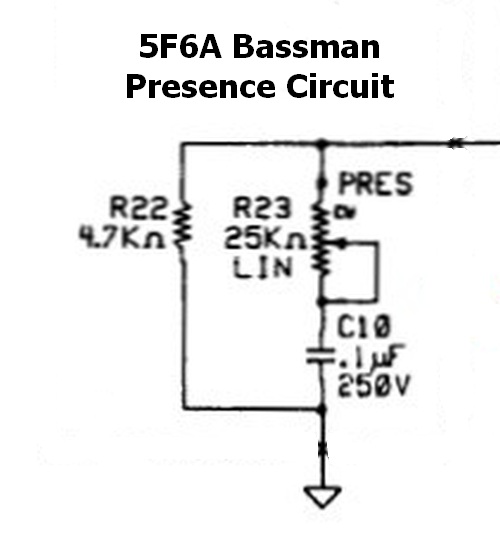
The Presence Cap bleeds NFB high frequencies to ground and also blocks DC from flowing through the Presence pot. This circuit differs from the Fender 5F6A schematic and layout but matches what was actually installed in most 5F6As from the factory.
The NFB Resistor and NFB Tail resistor form a voltage divider to set the NFB signal level. The ratio of this voltage divider can be used to calculate the value of our new NFB Resistor. Silverface amps use an 820 ohm NFB resistor with either a 47 or 100 ohm NFB Tail resistor. The 47 ohm NFB tail resistor was used in amps with 8 ohm outputs and the 100 ohm resistor was used to compensate for the lower voltage put out by 4 and 2 ohm power transformer secondaries.
Blackface/Silverface NFB Circuit
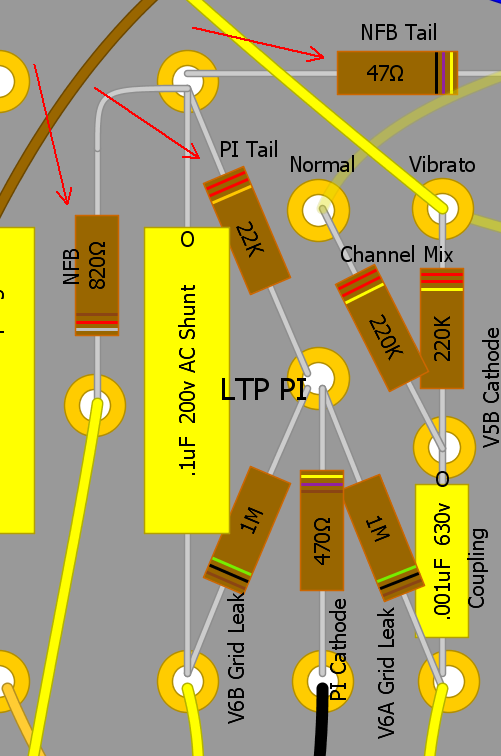
The ratio of our silverface amps with a 47 ohm NFB Tail resistor is 820 / 47 = 17.4. Since the NFB tail resistance is being increased from 47 to 4.7k we can use this NFB ratio to calculate the appropriate NFB resistor to pair with the presence circuit: 4.7k * 17.4 = 82k for the new NFB resistor.
For amps with a 100 ohm NFB Tail resistor we use 820 / 100 = 8.2, 4.7k * 8.2 = 38.5k. The nearest standard resistor value is a 39k NFB resistor for amps with 100 ohm NFB Tail resistors.
Since the presence control adds 4.7k of tail resistance to the phase inverter circuit we need to decrease the PI Tail resistor by 4k to compensate. If your PI Tail resistor is 22k then replace it with an 18k 1/2 watt resistor.
To add a Presence Control we delete the 47 ohm NFB Tail resistor from the circuit board and replace it with a 4.7k Presence resistor mounted on the Presence pot. The .1uF Presence capacitor forms an RC low pass filter with the NFB resistor. The Presence pot is wired as a variable resistor to control how much high frequency signal is bled to ground. The NFB resistor is increased to 82k and the PI Tail resistor is reduced by 4k to make up for the added NFB tail resistance. The NFB resistor should be 82k for amps with a 47 ohm NFB Tail resistor and 39k for amps with a 100 ohm NFB Tail.
Add a Mid Tone Pot
In the standard Fender tone stack a 6.8k Mid resistor is used in amps without a Mid pot (usually a 10KA pot). You can simply replace that 6.8k resistor with a pot wired as a variable resistor. A 10KA Mid pot is Fender standard but a 25KA, 50KA or 100KA can be used to give the Mid tone control more authority. Turning a 100KA Mid pot up adds resistance to the tone stack ground which "removes" the entire tone stack for a flatter tone curve and less signal load so you also get more gain. Turning the 100KA Mid pot up high gives us a "tweed" type tone due to a flatter tone curve and more gain. Also, as you turn up the Mid control the bass and treble pots will have less effect.
My personal favorite Mid tone control is a 6.8k resistor in series with a 100KA Mid pot. This allows me to set the Mid control to minimum and get Fender "normal" 6.8k mid resistance. Turn it up and I transition from blackface to tweed tone.
Typical Fender Tone Stack

The 6.8k Mid resistor is at the bottom of the schematic. It serves as the entire tone stack's ground connection. Adding Mid resistance adds mid frequencies and reduces the tone stack load which adds gain. Disconnecting the Mid resistor will completely remove the tone stack from the amp circuit.
Amp With a 6.8k Mid Resistor and No Mid Pot
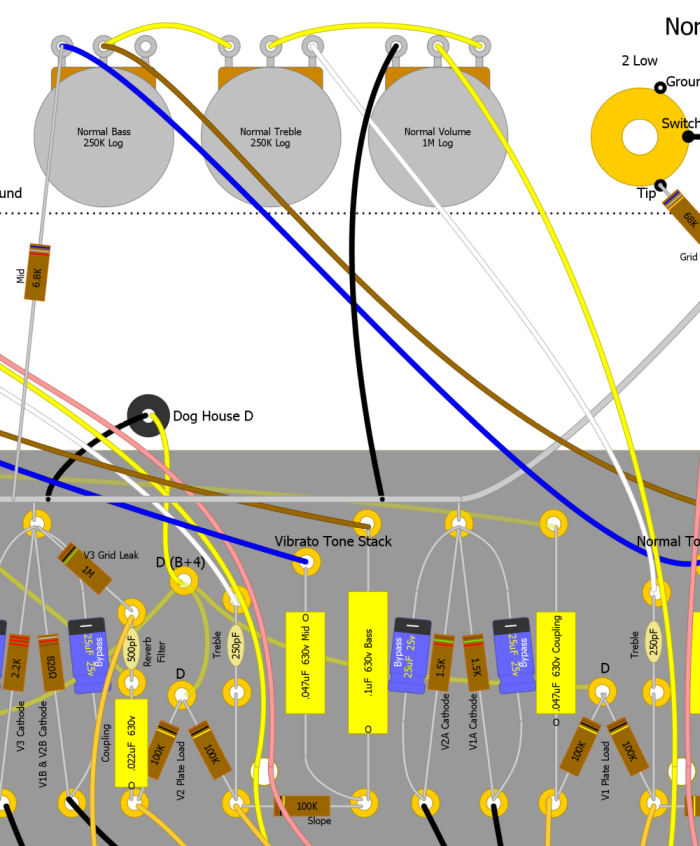
The 6.8k Mid resistor supplies the tone stack connection to ground. The bottom of the resistor is connected to the preamp ground bus bar.
Amp With a Mid Pot
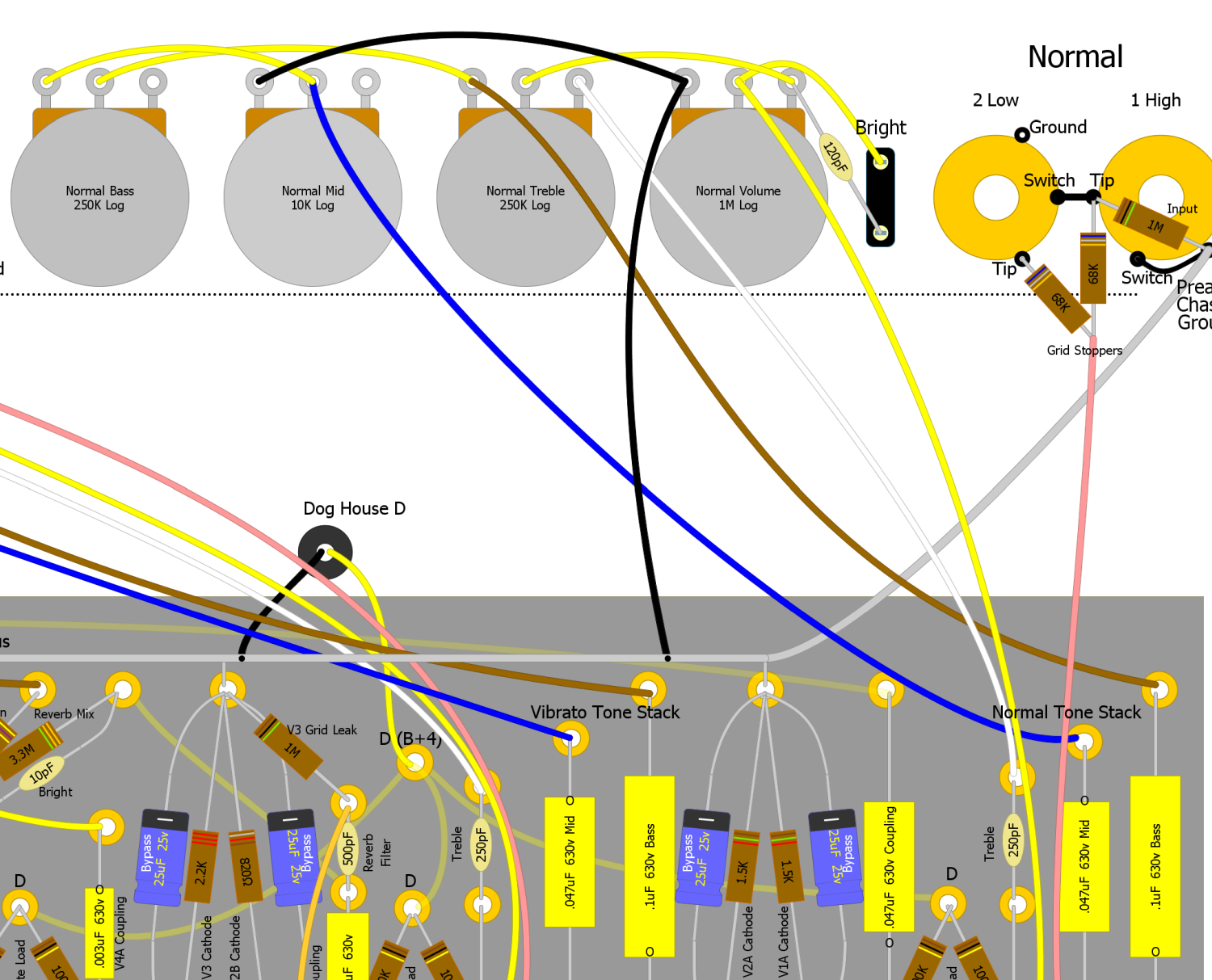
The Mid pot simply replaces the 6.8k Mid resistor.
My Favorite Mid Control Setup

100KA Mid/Raw pot with a 6.8k Mid Minimum resistor allows rolling the pot down to minimum to get "normal" Fender 6.8k mid tone. Turn up the pot a little to add mids, turn it up a lot and you approach tweed tone with flat tone curve and more preamp gain. You can also use a 25KA or 50KA Mid pot for less max tweed. Note that if a Presence pot ground is connected to the Mid pot you will need to run the presence pot directly to ground--do not run its ground through the 6.8k Mid Minimum resistor.
Raw Switch Mod
This is a great mod for pretty much any amp with a TMB (treble mid bass) tone stack. Because this type of tone stack really loads down the guitar signal being able to eliminate the tone stack is a valuable option. Just add an SPST ON/OFF mini-switch to the 6.8k Middle tone resistor's ground. No ground = no tone stack which gives you a very significant gain boost and pure "raw" unaltered tone. The raw tone has a non-scooped mid similar to the no-tone-stack tweed amps such as the 5E3 Deluxe. It also works great with EQ pedals because it lets the pedal do all the tone shaping.
If you feel the jump in gain is too much or the raw tone is too wooly you can reduce the raw boost effect by putting a resistor between the two raw switch terminals so when the switch opens for "raw tone" some tone stack current can still flow. Opening the raw switch will add the resistor value to the tone stack mid cap value. When the raw switch is in the normal, closed position the raw switch resistor is bypassed.
Raw Switch On and Off
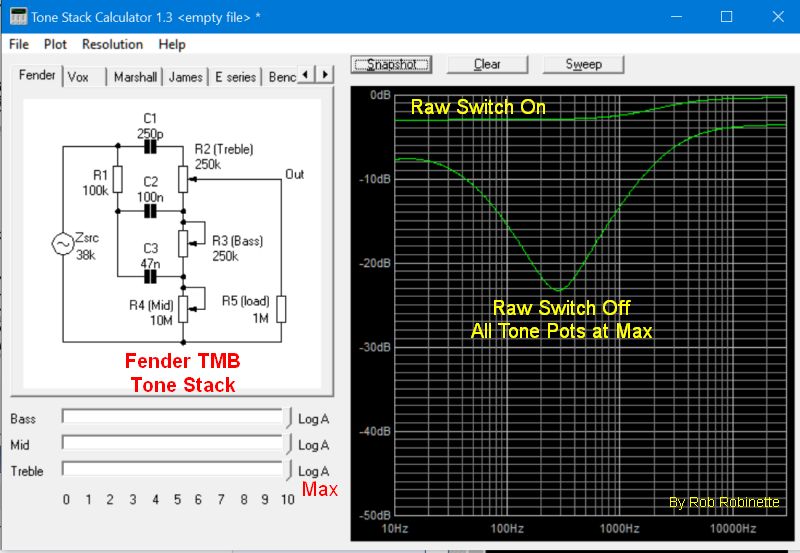
You can see how even with all three tone pots at max what a huge boost in signal you get when the Raw Switch is engaged (tone stack ground disconnected). The mid scoop is also flattened out. Chart is from the Duncan Tone Stack Calculator.
I placed my Raw mini-switch between the Treble and Bass pots but you can also mount it on the back of the chassis.

Raw switch added to AB763 Normal Channel--it's the same in a silverface amp. The switch is grounded at the Volume pot ground. The switch is a SPST (Single Post, Single Throw) ON/OFF mini-switch.
The 6.8k Mid resistors are located on both Bass pots. Just remove the resistor from the pot and connect the pot's left terminal to a Raw switch terminal with a new 6.8k 1/2 watt resistor (the leads of the original resistor won't be long enough to reach the switch). Connect the other switch terminal to ground and you're done.
With the switch in the connected position the tone stack is completely normal. With the switch in the disconnected position the tone stack disappears from the circuit and you get a big, fat signal boost. I like to orient the switch so that down is normal (connected) and up is raw/boost (disconnected).
You can use a push-pull 1MA volume pot as the raw switch if you prefer not to drill a hole in your faceplate for a switch. Just replace the volume pot with a 1MA (1 meg audio) push-pull pot and connect the 6.8k Mid resistor to the center-left push-pull terminal and connect the ground to the bottom-left terminal. With the push-pull down you will have a normal tone stack. Pull the volume control up and you get raw/boost.

For the 68 Custom Deluxe Reverb the Mid tone resistors are Normal Channel R9, Vibrato Channel R21 (at far right). The circuit board has these parts labeled. The resistors are mounted next to the Bass tone pots. Disconnect one end of resistor R9 and bend it to one side. Connect the Raw switch to the free end of R9 and the empty R9 mounting pad.
If your silverface amp has a Mid tone pot then you don't need the 6.8k resistor at all. Just run the Mid pot's ground wire (on the left Mid pot terminal) to a Raw switch terminal and the other switch terminal to ground. The switch will now interrupt the tone stack's ground.
Another option is to replace the 10KA (audio or log) Mid pot with a 25KA, 50KA or even 100KA pot (I prefer the 100KA). When you turn the Mid knob higher it will act as a "Raw" control, boosting the signal and removing the mid scoop.
Tone Stack Mods
Since both channels' tone stacks are identical you might want to consider changing one to offer different tone shaping options.
The Tone Stack is a series of three RC (resistance capacitance) audio filters that block three bands of audio frequencies. The Treble and Bass pots change the resistance of the RC audio filters to change the amount of signal filtered out. The silverface tone stack is a passive filter so it cannot boost any frequency band, it can only remove parts of the guitar audio signal. Note the Treble pot is wired as a variable voltage divider (potentiometer) while the Bass pot is wired as a variable resistor (the input and wiper terminals are tied together). In amps with a Mid pot it is a 10KA (audio or log) wired as a variable resistor.
Be aware that tone stack mods can affect "Fender Shimmer." When an AC audio signal enters a capacitor there is a slight delay as the cap fills and drains. This delay is called "phase shift". The larger the cap value the more delay so bass frequencies are phase shifted more than treble frequencies in the blackface/silver face tone stack. Fender Shimmer is caused by this differing phase shift between treble (goes through a tiny 250pF treble cap) and bass (goes through large .1uF cap). The shimmer occurs where the treble and bass frequencies overlap--the mid highs to the mid lows. The treble control acts as a mixer for the treble and bass and maximum shimmer will occur near the treble control mid point when bass and treble are most balanced. The effect is similar to two guitars playing, one playing treble and one playing bass and they are slightly out of time which creates a nice, fat mid frequency tone. As guitar notes decay their harmonic overtones cause varying amounts of phase shift through the tone stack which causes the actual wavering "shimmer" effect. The greater the difference between the treble and bass capacitance values, the greater the shimmer effect. Blackface/silver face tone stacks with their large .1uF bass caps, tiny 250pF treble caps and 100k tone slope resistors seem to work best at maximizing shimmer. A lower 56k tone slope resistor raises the point of maximum shimmer a full octave. AB763 tone stack Fender Shimmer is one of the main reasons blackface amps are considered the high water mark of Fender amps. The shimmer added the missing ingredient needed to make solid body electric guitars sound their best.
Typical Fender Tone Stack

Both channels' tone stacks are usually identical. The stacks' output flows directly into the Volume pot.
A common mod is to replace the 100k Tone Slope (yes, that's where he got his name) resistor with a 56k or even 33k which changes the way the tone controls operate. Others prefer a 150k Tone Slope. Keep in mind a lower Tone Slope resistor will increase the load of the tone stack and reduce gain.
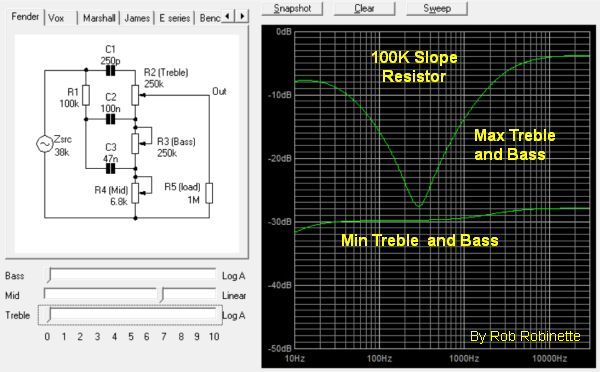
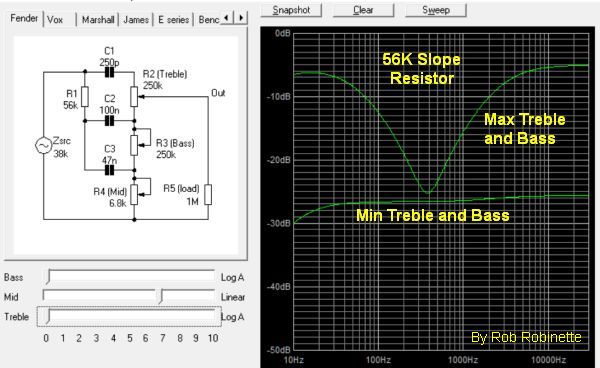
Standard 100k Tone Slope resistor on the left, 56k on the right. The effect is subtle but some prefer the 56k slope. Notice how the max bass and treble are balanced on the right with the 56k slope resistor. The 56k also boosts the midrange by 2.5dB.
Another common mod is replacing the Tone Stack's 250pF treble tone cap with a 500pF which will extend the treble controls reach into the mid frequencies.
Tone Stack Mid Cap Change
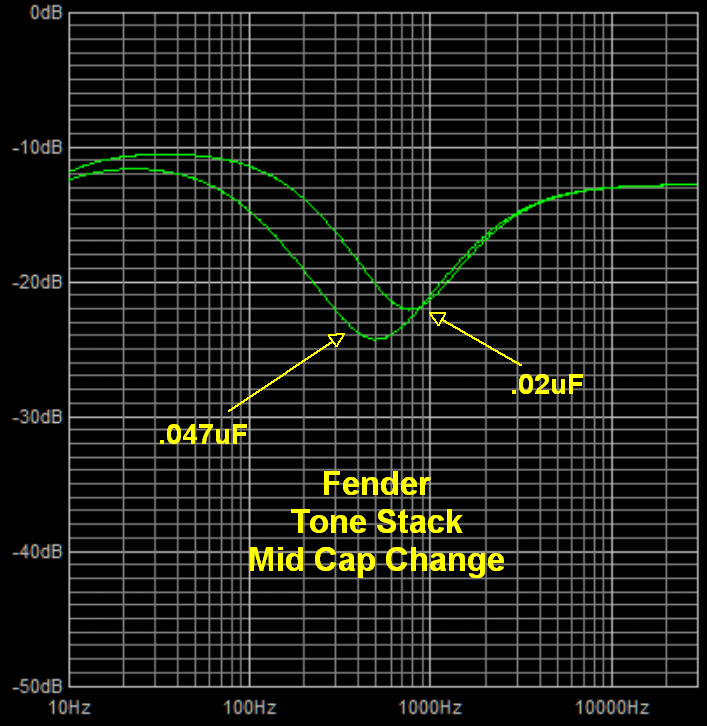
The 68 CDR Custom channel's reduced .02uF middle cap shifts the "mid" frequency band higher and reduces the mid scoop by over 2dB.
The 68 Custom Deluxe Reverb also has an 18k resistor between the Bass pot and 6.8k Mid resistor. The 18k resistor works as a minimum bass setting and keeps the bass from falling off a cliff as you approach the Bass pot's minimum setting. It makes setting low bass settings easier and more precise but it does limit you to how low you can set the bass.
If you are considering modifying the tone stack I recommend you download the free Duncan Amps Tone Stack Calculator so you can see graphically what the modifications do and how the Treble and Bass pots will react to the new component values.
Duncan Amps Tone Stack Calculator
Once you get the Tone Stack Calculator running click on the Tone Stack Calculator's "Fender" tab at upper left. By setting the Mid slider (bottom left) to 68% you get 6800 ohms to equal the Deluxe Reverb's fixed 6800 ohm Mid resistor. You can double-click any component in the tone stack schematic to change its value so it's easy to see what happens to the control movements when you change the 100k slope resistor to 56k or adjust the value of the Mid resistor. The frequency response graph on the right will change as you alter component values or move the Bass and Treble pot sliders (at bottom left). Just playing with the pot sliders and watching the graph will tell you a lot about the interactive nature of the TMB (treble mid bass) tone stack. The Tone Stack Calculator is a very cool tool.
If you do install the Tone Stack Calculator be sure and see how a 25KL and 100KL Mid pot can act as a "Raw" control and boost the signal compared to a 6.8k resistor or 10KA pot.
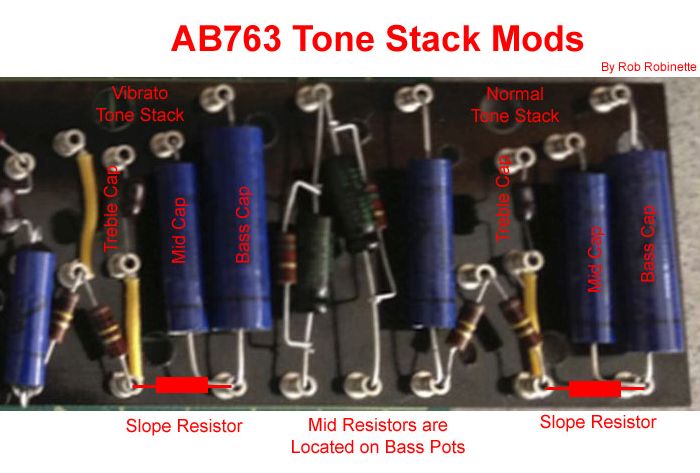
Change the tone stack caps and resistors to suit your taste.
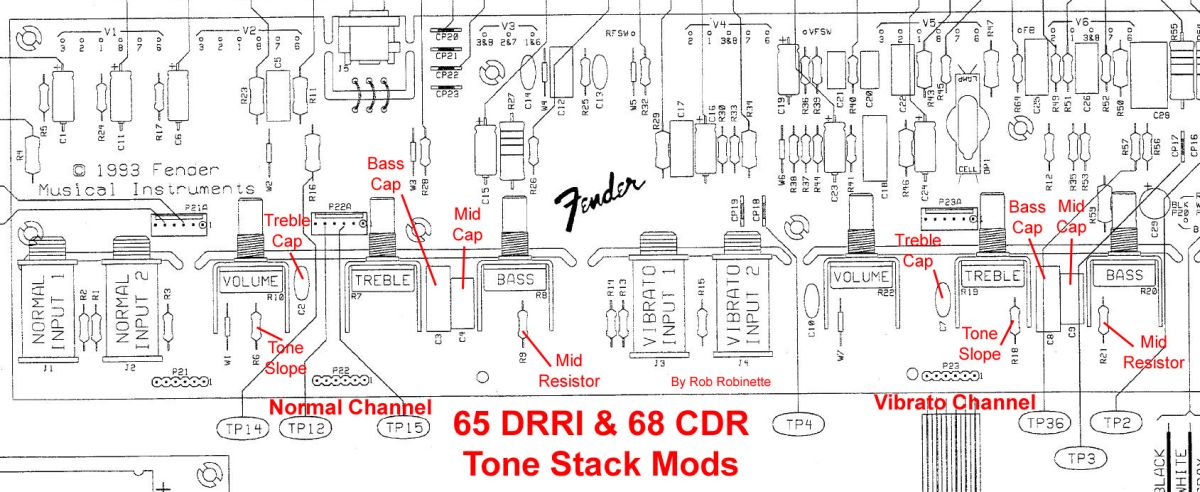
68 Custom Deluxe Reverb Tone Stack Part Numbers:
Normal or Custom Channel Tone Stack
Tone Slope R6, Treble cap C2, Bass cap C3, Mid cap C4, Mid resistor R9
Vibrato or Vintage Channel Tone Stack
Tone Slope R18, Treble cap C7, Bass cap C8, Mid cap C9, Mid resistor R21
These part numbers are marked on the circuit board.
Add Tremolo to Both Channels
You simply need to move the yellow tremolo wire that runs from the Tremolo Intensity pot right terminal to the Vibrato channel 220k mixing resistor to after the mixing resistors--where both 220k mixing resistors join together. The tremolo wire connects to the Vibrato channel mixing resistor under the circuit board. If you don't want to lift the board to disconnect the tremolo wire you can disconnect it at the Tremolo Intensity pot and then run a new wire from the intensity pot to the two Mixing resistors. My annotated Band-Master layout says "Inject Tremolo" at "point Y." Move the yellow tremolo wire that runs from the Intensity pot to point Y to the other end of the mixing resistor.

Tremolo is injected at point Y using the yellow wire from the Intensity Pot right terminal (center of layout). The connection point is marked in red "Inject Tremolo" label. Simply move that wire from the top of the 220k Mixing resistor to the bottom of the same resistor.
Tremolo Cut Switch Mod
This SPST ON/OFF mini switch completely disconnects the Tremolo circuit which will really boost the guitar signal because the 50k tremolo intensity pot places a heavy load on the Vibrato channel's guitar audio signal. I was really surprised by how much gain was added by simply putting a switch in the Tremolo Intensity pot's input wire.
I like to orient the Tremolo Cut switch so that down is Tremolo off (switch open) and up is Tremolo on.
You can also replace the Tremolo Intensity pot with a 50KRA (reverse audio) push-pull pot. I purchased a 50KRA pot with an off position when you turn the dial full down from Vintage Amp Repair's ebay store for a very clean looking mod. You get higher gain with it clicked off and normal Vibrato channel gain with it clicked on in the "1" position.
50KRA Tremolo Intensity Pot With Off Position
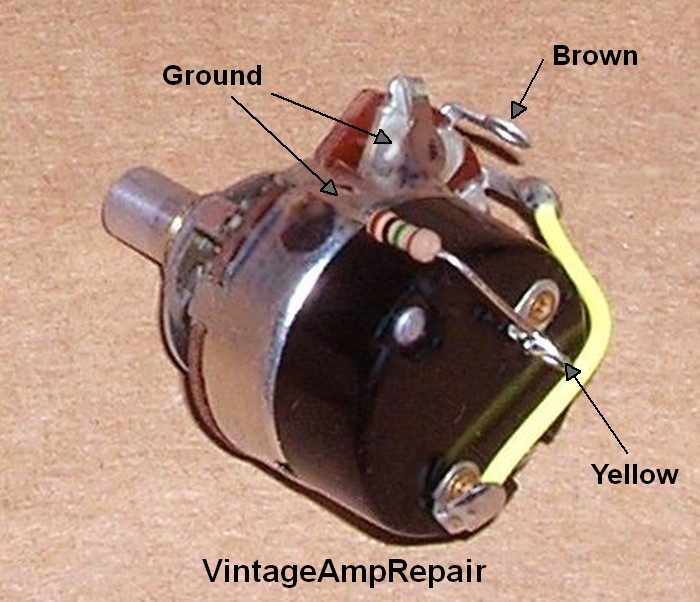
Photo by Randy Adkins, Vintage Amp Repair.
It's difficult to find a 50KRA push-pull pot but you can make one by purchasing a common 250KA (non-reverse audio) push-pull pot and a 50KRA pot, then swap the 50KRA disc into the push-pull pot. I like to wire the push-pull switch pull-on but if you are a heavy tremolo user you can wire it pull-off .
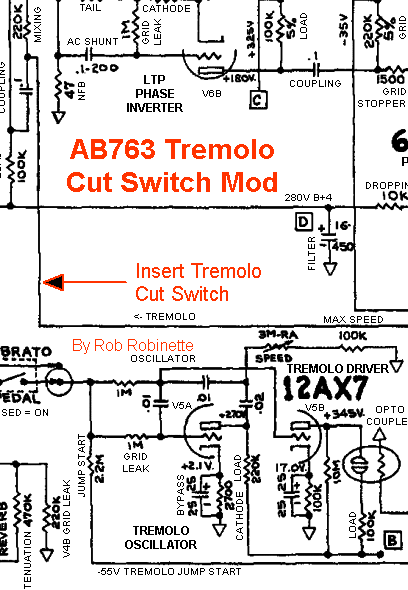
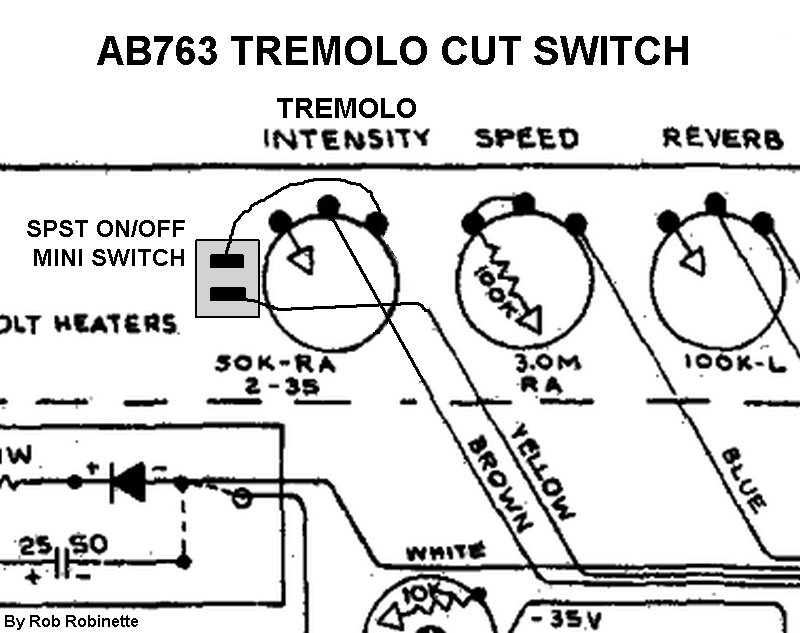
Splice in a SPST ON/OFF mini switch in the Tremolo Intensity pot's yellow (input) wire to completely disconnect the tremolo circuit.
To prevent the switch from popping when you engage tremolo you can place a 1M 1/4 watt resistor connected to ground (back of the pot) on one end and to the switch terminal that the amp's yellow wire connects to.
This mod is a little more difficult in the 68 Custom Deluxe Reverb because there is no wire, only a trace between the Tremolo Intensity pot and the 220k Vibrato Channel Mixing resistor R35 so you must cut the trace and bridge the cut with the Tremolo Cut switch.
You can also reduce the tremolo circuit load and boost gain by replacing the stock 50K-RA (reverse audio) Tremolo Intensity pot with a 100K-RA pot.
Slow the Tremolo
This is a pretty common mod that allows a slower tremolo which I really like. The tremolo circuit has three disk capacitors. Two are .01uF and the other is .02uF. Replace the two .01uF caps with .02uF 400v (or higher voltage) to slow the tremolo. Many people like to use Orange Drop caps in the tremolo oscillator.
If after this mod you would like a faster maximum tremolo speed you can reduce the size of the 100k "Max Speed" resistor located on the Tremolo Speed pot.
This mod puts a little more strain on the V5 tremolo tube so if the tremolo stops working after changing the two caps just install a fresh 12AX7.
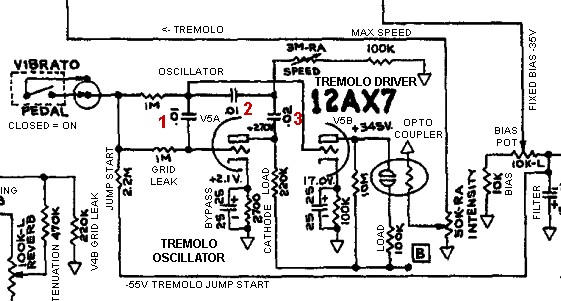
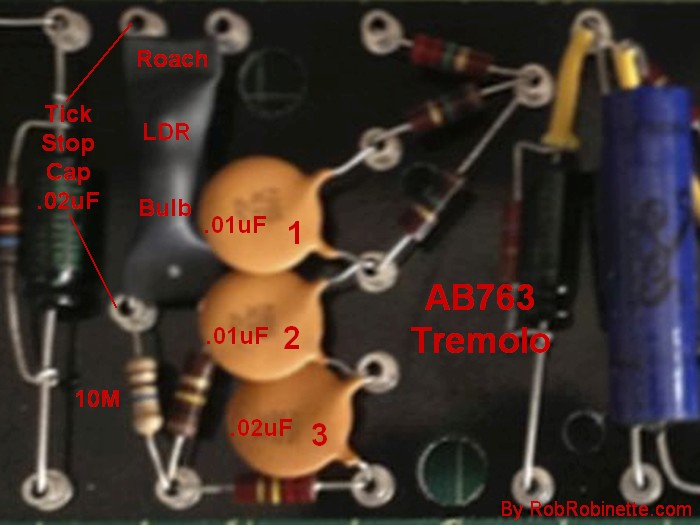
Disk cap numbers 1, 2 and 3 match the numbers in the schematic above. Replace #1 and #2 with .02uF 400v caps.
Stop Tremolo Ticking
The very strong tremolo oscillator signal can induce ticking into the amp's signal stream. First try to separate the tremolo driver plate (V5 pin 6) wire from any grid wires to stop the ticking. Pay close attention to the nearby V6A phase inverter grid (pin 2) wire.
Another option is to use a shielded cable like RG174 for the tremolo driver plate wire (V5 pin 6) to stop the transmission of the tremolo signal. This is almost a 100% fix for tremolo ticking. Ground the cable shield at only one end (either end) to prevent a ground loop.
If the above don't work then adding a .01uF 600v mylar cap to the tremolo roach should stop it.

Add a .01uF 600v (or higher voltage) mylar cap across the left side of the tremolo roach to cure tremolo tick. I now recommend a .01uF cap.
Fender service bulletin #9.
The ticking caused by the Vibrato is caused by improper lead dress. It can almost be "cured" by connecting a .01 mfd 600 volt Mylar capacitor on the 10 meg ohm resistor in the vibrato circuit. This resistor is located on the parts panel. If present, remove the capacitor in parallel with the 10 meg ohm resistor (old modification). [Rob recommends doing the lead dress changes in 1 & 2 below]
In other words, run the cap from the junction of the 10 meg resistor and the opto-isolator to ground [as in photo above].
If this does not produce the desired results, then the leads should be dressed as follows and excessive lengths shortened. [Shortening the leads should be your last resort]
1. Dress the leads to the vibrato speed and intensity controls away from the tone controls and filter leads. [Run the vibrato leads half-way between the tone control wires and filter cap wires]
2. "Bunch" the leads to the components on the parts panel which connect to the tube socket of the V5 7025 (12AX7) vibrato tube. [They carry a very strong signal]
Tremolo Always On RCA Plug
Silverface amps have a female RCA jack for the tremolo foot switch. Tremolo is turned on when the footswitch is closed. This little shorted male RCA plug will turn on the tremolo without having to plug in the tremolo footswitch. I like to keep mine in all the time. The $1 Switchcraft 3501MX RCA plug is a perfect fit with a long center connector.
Switchcraft 3501MX RCA Plug
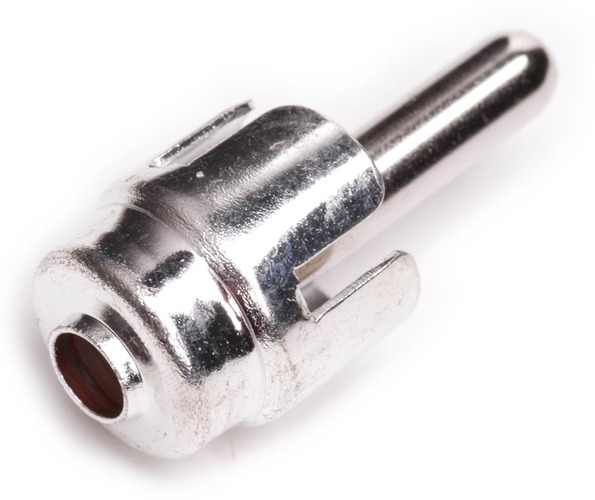
To short the plug insert a bare wire all the way through the connector--there's a hole in the end of the prong so run the wire all the way through then solder both ends of the wire to the plug. Be generous with the solder. Trim the wire flush at both ends and you're done.
Add Reverb Dwell Control
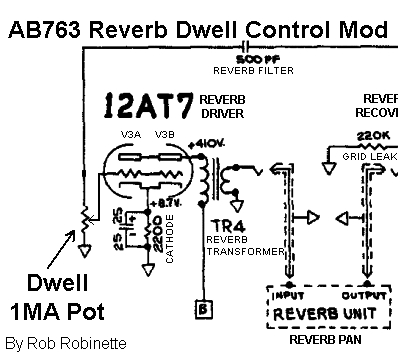
Simply replace the 12AT7 1M grid leak resistor with a 1MA pot.
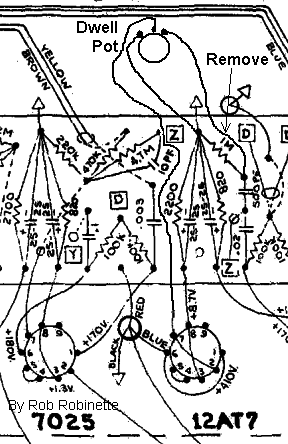
12AT7 1M grid leak resistor clipped or removed. 1MA pot wired in its place.
The Reverb driver 1M grid leak works with the 500pF Reverb Filter cap to form a CR (capacitance-resistance) high pass filter with a corner freq of 318Hz (everything below 318Hz is cut). By replacing the 1M grid leak with a 1MA pot you will not only cut the amount of guitar signal entering the reverb driver as you turn down the Dwell pot but you will lower the CR corner freq as well which will allow more low freqs into the reverb circuit.
Place your dwell pot or trimmer wherever you want. Remove the 1M resistor. Wire the pot's left terminal to any ground. Wire the right terminal to the now empty right resistor eyelet (or turret). Wire the pot's center terminal (wiper) to V3 (12AT7) pin 7.
Channel Mixing Resistor Bright Caps Mod
Putting 500pF bright caps around the 220k Channel Mixing resistors will slightly brighten the tone of the modified channel. You can do one or both channels. You can alligator clip the cap in place temporarily to see if you like the mod.
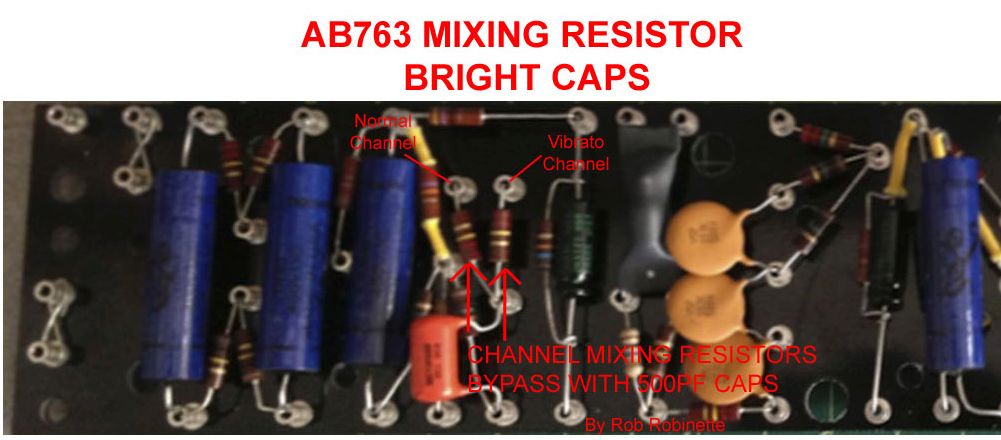
The 220k Channel Mixing resistor on the left is the Normal Channel's, the Vibrato Channel's resistor is on the right. Original photo by John Chabalko.
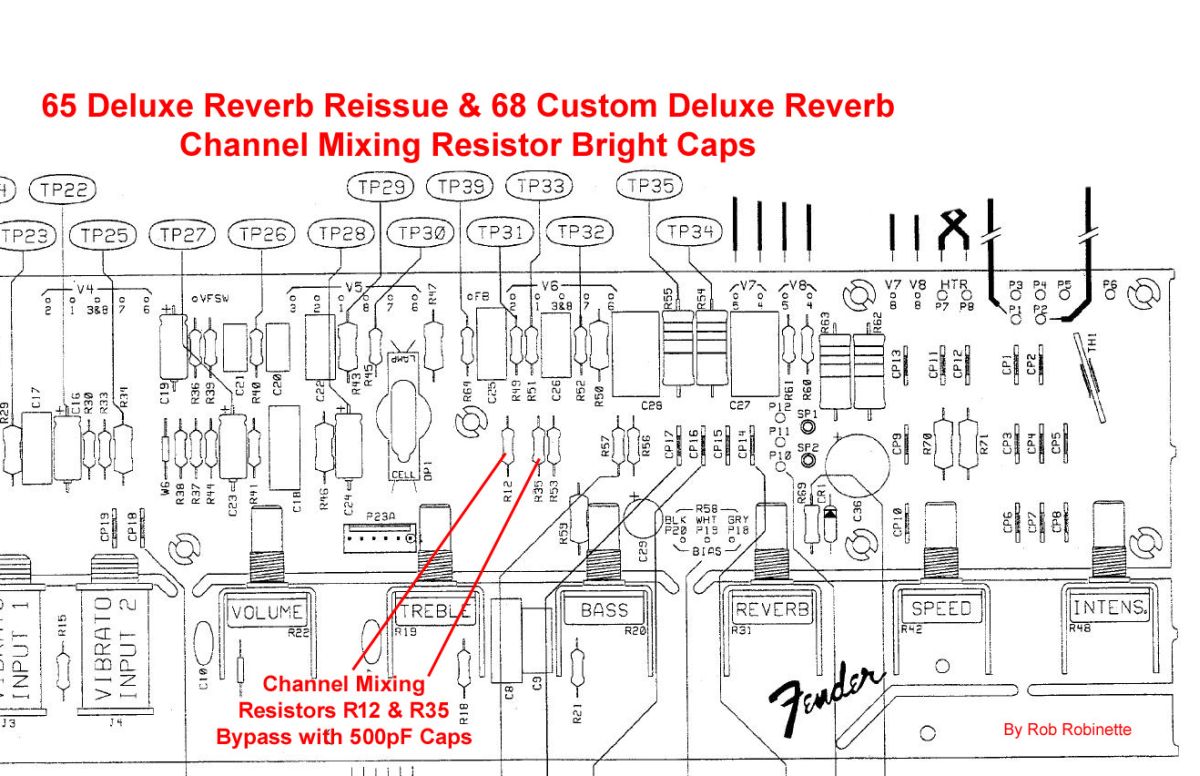
For the 68 Custom Deluxe Reverb the Normal Channel Mixing resistor is R12. The Vibrato Channel Mixing resistor is R35. The circuit board has these parts labeled.
Increase Preamp & Phase Inverter Voltage
The Deluxe, Deluxe Reverb, Vibrolux and Tremolux amps run with low voltage preamps compared to the other silverface amps. The schematic for the Deluxe shows only 170 idle volts on the preamp tube plates while the Twin Reverb shows 270v. You can add preamp clean headroom by changing the two power (voltage dropping) resistors to the Twin Reverb values which will bump up the phase inverter and preamp plate voltage. This mod will add preamp headroom and shift the preamp/power amp distortion mix toward the power amp which might actually be too much for the 6V6 power tubes in the Deluxe and Deluxe Reverb. When doing this mod be sure and sample the max volume distortion tone to ensure the power tubes aren't pushed too far. This is an excellent mod for people that want to run 6L6 power tubes in their 6V6 amps. The extra voltage swing will drive the 6L6 harder into distortion and keep the preamp/power amp distortion balance intact.
The high preamp voltage silverface amps like the Twin Reverb use a 1k 1 watt "C" power node power resistor and 4.7k 1 watt "D" power resistor.
C and D Power Resistors in the Twin Reverb
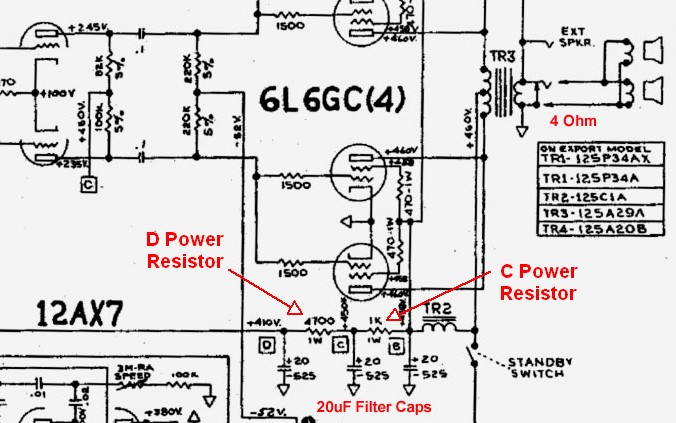
In the Twin Reverb the C Power Resistor is a 1k 1 watt resistor. The D resistor is a 4.7k 1 watt.
I recommend you start by modifying just the C power node power resistor first and sample the modified tone. Reducing the value of the C power resistor will raise the voltage on all the tube plates except the power tubes. Replace the C power resistor with a 1k 3 watt. I recommend a 3 watt rating for these resistors for longevity's sake. The C and D power resistors are located in the "doghouse" which is located outside the chassis next to the output transformer. You can temporarily alligator clip a resistor in parallel with the existing power resistor to try a lower value. For example, the Deluxe Reverb has a 10k C resistor so paralleling a 1.2k (1 watt or higher) will give you 1k of resistance [ 1 / (1/10k + 1/1.2k) = 1k ]
You don't have to use a 1k resistor here, you can chose any resistor value between the original value and 1k to tweak the tone change to your liking.
If you like the change and want more then replace the D power resistor with a 4.7k 3 watt which will boost only the preamp voltage (and reverb recovery in the reverb amps). Again, you don't have to use a 4.7k resistor here, you can chose any resistor value between the original value and 4.7k.
Deluxe Reverb Power Resistors
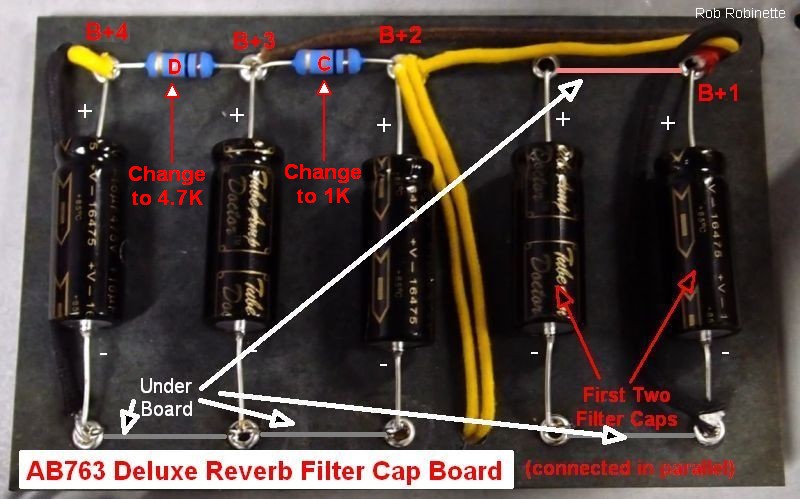
The C and D power resistors are located at upper left in the filter cap "doghouse."
Vibrolux & Tremolux Power Resistors
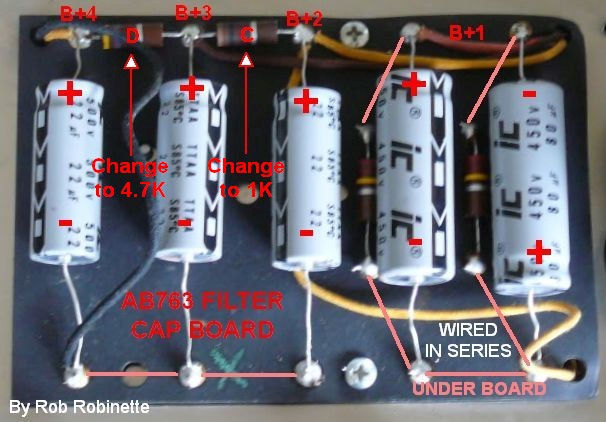
The C and D power resistors are located at upper left in the filter cap "doghouse."
68 CDR Power Resistors
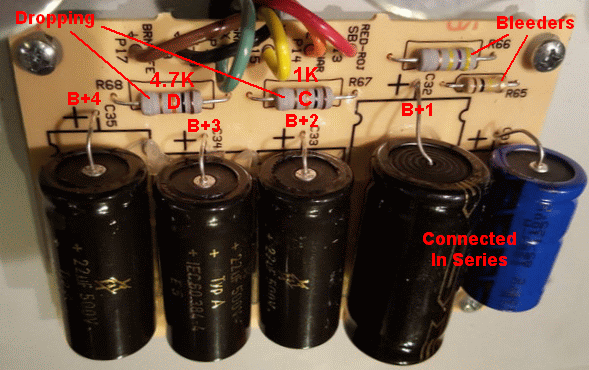
The C and D power (voltage dropping) resistors are located at upper-center left in the filter cap "doghouse."
Reduce Ice Pick Highs
If your particular speakers are giving you too many 'ice pick' highs simply adding a 100pF Mica capacitor across the feedback resistor will filter out some very high freqs that can cause ice pick highs. The cap allows high freqs to go around the feedback resistor so they are used for feedback which will reduce them from the amp's output. This is a nice, subtle mod that won't screw up your silverface's perfect tone. It's easy to use alligator clips to clip the cap in place temporarily to see if you like the mod. If you would like to cut even more highs than the 100pF cap, you can go all the way up to a .022uF cap to lower the filter's cutoff freq so more mid-high freqs would be cut. There's a small chance the Ice Pick Cap can induce oscillation at high volume. If that happens you can put a 4.7k resistor in series with the cap to reduce the very high frequencies that cause oscillation.
This is an Ice Pick Cap on a 5F6A Bassman but it works the same way in silverface amps. Just put the cap around the 820 ohm Negative Feedback resistor.
Humdinger Heater Hum Pot
This simple mod allows you to balance the voltage of the 6.3v heater circuit to minimize heater hum. Use a 100 or 250 ohm, 1 watt or greater linear pot. The Humdinger pot replaces the power transformer's 6.3v center tap or an artificial center tap made up of two resistors. Remove your current 6.3v center tap before installing the Humdinger. You simply turn the amplifier up and adjust the pot for minimum hum. If you don't hear a difference just center the pot.
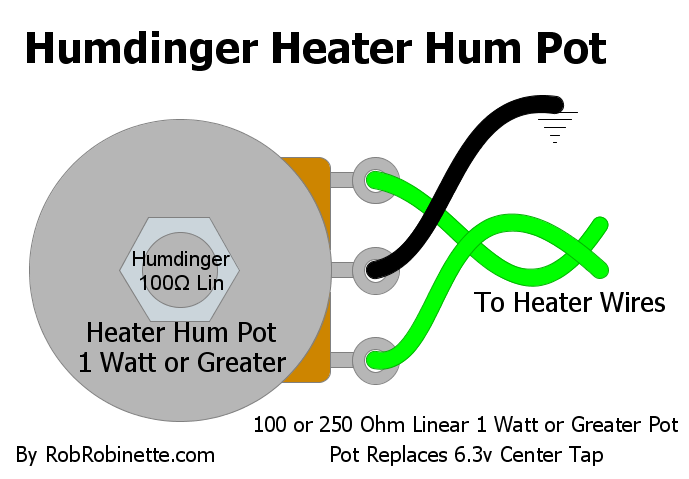
The 100 or 250 ohm linear pot wiper is connected to chassis ground and the two outside pot terminals are connected to the heater wires at any spot along the heater circuit. The pot needs to be rated at 1 watt or higher. This 100 ohm, 5 watt pot is perfect as a humdinger.
Speaker Suggestions for Silverface Amps
Weber 12F150 Vintage American Voice, 12", ferrite magnet, 1.5 inch voice coil, light dope $114. Weber's and my recommendation for the silverface amps that use 12" speakers. 10F150 is my recommendation for silverface amps that use 10" speakers, $94. Both require a long, 50 hour break in unless you have Weber do their free break in service.
Weber Ceramic Signature 10" and 12" for the budget minded. Some actually prefer the Sigs to the more expensive 10F150 and 12F150. Four Sig 10's in a Super Reverb sound absolutely glorious.
The 68 Custom Deluxe Reverb comes with a British voiced 12” Celestion G12V-70 and the amp gets great reviews.
Eminence GA-SC64 Vintage American Voice, "Tones of 1964 still ring true in this vintage voiced speaker by seasoned amp guru George Alessandro. Well balanced from top to bottom, the GA-SC64’s warm, dynamic character lends itself to vintage amps as well as modern gain and distortion. The traditional build materials offer warmth, dynamics, low note articulation and proper distorted harmonic content layering."
Eminence Cannabis Rex A lot of Deluxe Reverbs run a C Rex and get heaps of praise. "The Eminence Cannabis Rex guitar speaker lets your laid-back style come through. Clean and full, with lots of body and sparkle. Smokey smooth with high-end definition. Country, Jazz or Classical guitarists take notice."
JBL D120F Loud, clean, efficient but heavy and adds some mids the amps needs. Best defense against ham fisted drummers. You can always find a blown one and have it reconed.
Celestion 12M Greenback Warm and Woody with relatively early breakup.
Eminence GB128 Vintage British Voice, "The Eminence Legend GB128 guitar speaker helps clean up your act. Cleaner British voiced tone with a full low end, warm, throaty mids and a very open top end. Turn up the volume and turn back the clock."
The WGS ET65 is an amazing replacement speaker for Fender amps even before you consider its low low price. "The ET65's creamy lows blend with tight midrange and sparkling highs for some of the best tones ever created. This speaker is for classic rock, country, and blues. Upgrade from your Celestion™ G12-65."
Add 8" Speakers to a Head Cab
The Bandmaster Reverb head has an extra large cabinet to keep the power transformer away from the reverb pan. This extra cab size allows two 8" speakers to fit nicely. I recommend you leave your original "baffle board" alone and create a copy to cut the speaker holes in. You can buy silverface grill cloth and Fender logos to cover the new board. You should also paint the new board black. My Bandmaster Reverb had two Jensen Special Design C8R 8ohm 25W 93dB speakers wired in parallel already installed when I bought it. The two 25 watt speakers sound great with a Vibrolux kind of vibe and can handle 50 watts together so they can handle the amp fully cranked. With a low efficiency of 93dB they're not too loud and are great for getting a little dirt at practice volume.
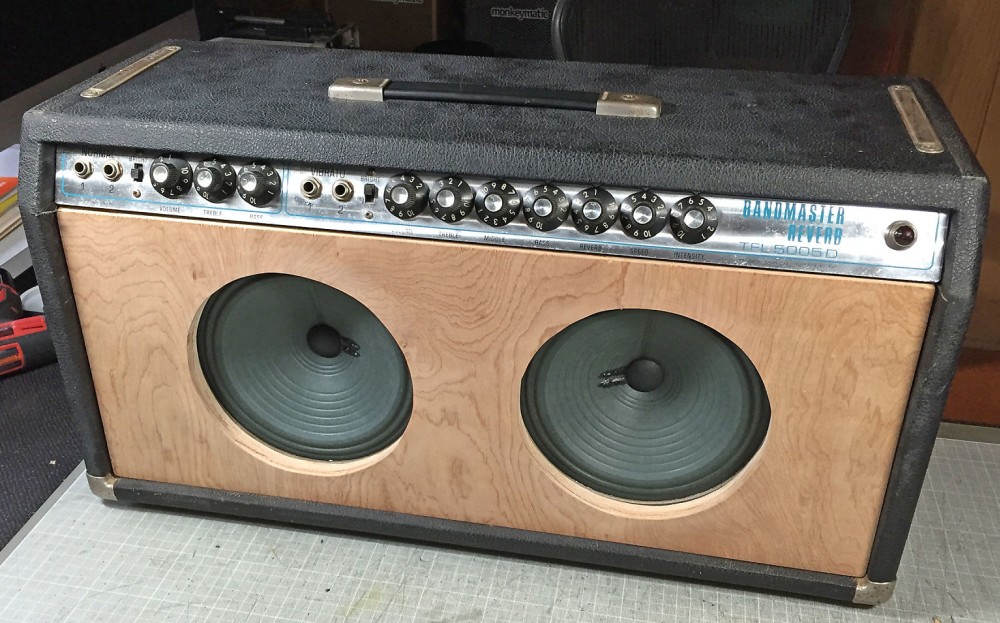
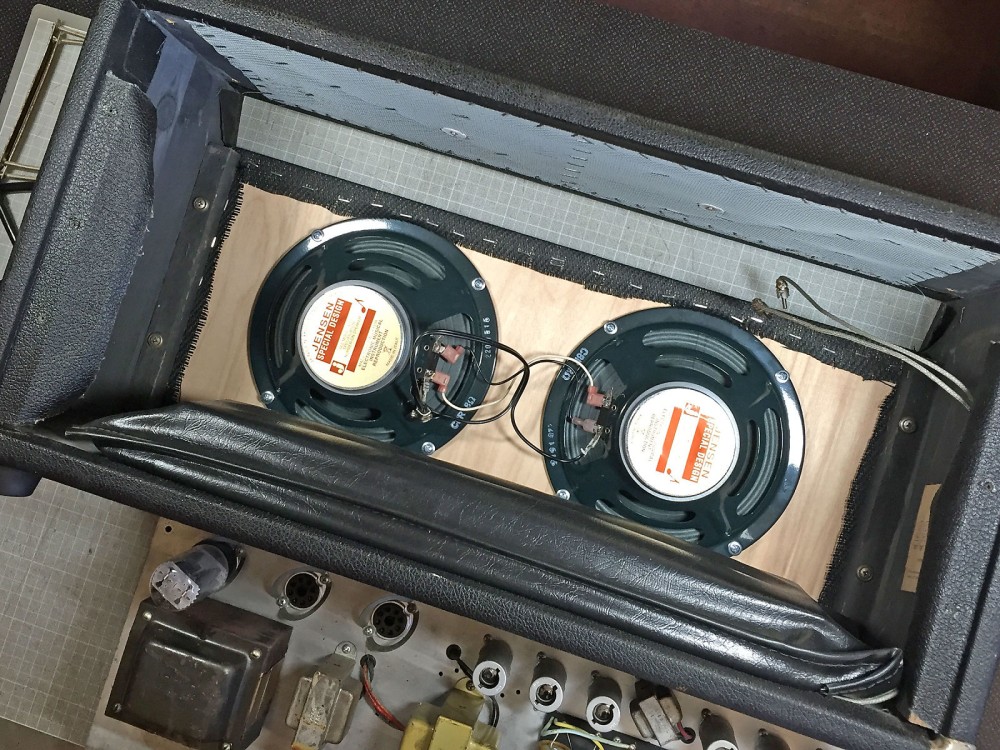
Why not?
Preamp Tube Tweaks
Pull the Normal Channel preamp tube V1 and use the Vibrato Channel. Of course this assumes you don't use the Normal Channel because tube V1 is the Normal Channel first and second preamp stages. Pulling V1 changes the amp circuit because the V1B and V2B triodes share an 820 ohm cathode resistor. Two triodes sharing an 820 ohm cathode resistor is the equivalent of each triode having its own 1.5k resistor. If you remove V1 then the V2B (Vibrato Channel second gain stage) preamp goes from normal center bias to a warm bias with an 820 ohm cathode resistor. In other words pulling V1 is exactly like changing the Vibrato Channel second preamp gain stage from a 1.5k cathode resistor to an 820 ohm. This warm bias increases gain and makes creamy sounding asymmetric clipping more likely. Removing V1 will also raise the plate voltage on all the preamp gain stages which adds a some gain also. Removing V1 works really well with hot boost pedals or even hot humbucker guitars.
Replace V1 or V2 with a 12AY7. You can go the opposite direction and reduce preamp gain by replacing the 12AX7 in V1 (Normal Channel) or V2 (Vibrato Channel) with a lower gain 12AY7. The 12AY7 was used as the first gain stage for many of the tweed amps and will offer up more clean headroom because its lower gain will reduce preamp distortion. This swap can really shift the distortion balance between preamp and power amp to favor power tube distortion when you combine it with the V6 phase inverter tube change as discussed in the next paragraph.
Try a 12AX7 in the V6 Phase Inverter for more power tube distortion. The 12AX7's extra gain will hit the power tubes with a hotter signal. This is a way to shift the AB763's preamp/poweramp distortion balance toward the power tubes. To give it a try just move the V1 12AX7 into the V6 socket and use the Vibrato Channel. You can balance the extra gain from the 12AX7 in one of the channels by swapping out V1 (Normal channel) or V2 (Vibrato channel) with a lower gain 12AY7 to make your clean channel cleaner.
Replace the V3 12AT7 Reverb Driver tube with a lower gain 12AU7 to give you more usable room on the Reverb Control. The Reverb pot can be a little touchy with a usable range from 0 to 3 or 4. A 12AU7 won't push the reverb circuit as hard so the usable range can extend up to 5 or 6 on the dial and make dialing in just the right amount of reverb easier. The lower gain 12AU7 can also reduce reverb circuit noise.
Another option to tame the reverb level is to install a 7247 or 12DW7 tube in V4. These tubes are dual triodes but the A triode is a 12AU7 equivalent with lower gain than a 12AX7. The B triode is a 12AX7 equivalent so the V4B preamp stage stays at full gain. Decreasing the reverb recovery's gain makes the Reverb Control less touchy, somewhat enhances the reverb tone and can decrease reverb noise.
Run 6V6 Power Tubes In 6L6 Amps
Running 6V6 power tubes in a big bottle silverface amp will give you small bottle tone but with lots more power tube overdrive because the preamp is tuned to hit the phase inverter and power tubes harder than in the small bottle amps.
To compensate for the different power tube impedance we need to adjust the speaker impedance. Since the little 6V6s put out much less current they need a higher impedance load. For a big bottle amp with a 4 ohm output transformer secondary we need to connect an 8 ohm speaker. With a 2 ohm secondary we need a 4 ohm speaker or with an 8 ohm secondary we need a 16 ohm speaker.
JJ 6V6S power tubes are good for 500 plate volts so they can handle 6L6 voltage but for normal 6V6 tubes you must do something to lower the plate voltage to keep from frying them. For amps with tube rectifiers you can plug in a lower rated rectifier like the 5R4 (less sag) or 5Y3 (more sag) to bring down the voltage. For amps with solid state rectifiers like the Twin Reverb and Single and Dual Showman you can plug the amp into a variac and turn down the amp's input voltage. A bucking transformer at its lowest setting may also do the job.
You may also need to adjust the bias after installing the 6V6 tubes. See this to measure and adjust the bias.
Run 6L6 Power Tubes In 6V6 Amps
You can get a different tone from the small bottle Deluxe Reverb by installing 6L6 power tubes but the power and output transformers can't supply all the extra current needed to actually get much more volume at the speaker. Running 6L6 tubes will stress the transformers so I don't recommend it but if you want to give it a try then you should make a change to the speaker load to compensate for the different power tube impedance. Just use a 4 ohm speaker with the Deluxe Reverb's 8 ohm secondary.
The amp may sound more sterile because the low voltage preamp and phase inverter are tuned to drive the 6V6 so you'll get less power tube distortion. If you plan to permanently swap to the 6L6 then I recommend you raise the preamp and phase inverter voltage to better drive the 6L6 power tubes.
Everyone that moves up from small bottle power tubes to large should measure their 6.3v heater voltage and make sure it's not 10% lower than spec (lower than 5.7v). The extra current draw of the big tubes can over tax some power transformers.
Keep an eye on your power transformer's temperature when running the big power tubes but be careful because the transformer can get hot enough to burn your fingers. I use an infra red no-touch thermometer to monitor amp component temperatures. Take a measurement with the normal 6V6 tubes so you have a baseline temp to compare to how hot it gets with the big tubes.
Replacing the GZ34 tube rectifier with a solid state rectifier like the plug-n-play Weber WS1 Copper Cap will supply the amp with a little more voltage and current to better drive the big 6L6 tubes.
You will probably need to turn up the bias to get the most from your 6L6 tubes. See this to measure and adjust the bias.
Run 2 Power Tubes in a 4 Power Tube Amp
Many push-pull amps designed to run 4 power tubes can be run with 2 power tubes to cut the output power in half. But since the output transformer was designed to load the current put out by 4 power tubes we need to make an adjustment on the speaker end to load 2 tubes properly. Since 2 power tubes put out half the current of 4 tubes we need to double the speaker impedance so 2 tubes feel the same load as when 4 tubes are used. For example your amp is designed to run an 8 ohm speaker with 4 tubes it will need a 16 ohm speaker when run with 2 power tubes.
To run two power tubes you pull the two outside power tubes, which in the Twin Reverb are V7 and V10 (tube numbering starts with the first preamp tube on the far right).
The plate voltage will be higher with only two tubes pulling current through the power supply so you may need to adjust the amp's bias. See this to measure and adjust the bias.
Run 2 6V6 Power Tubes in a 4x6L6 Amp
As stated above we need to up the speaker impedance when substituting 6V6 tubes in a 6L6 amp and we also need to up the impedance when running only 2 power tubes in a 4 tube amp so we need to take two steps up in speaker impedance to run 2 6V6 power tubes in an amp designed for 4 6L6 tubes. For an amp with a 2 ohm secondary we would need an 8 ohm speaker, a 4 ohm secondary needs a 16 ohm speaker and an 8 ohm secondary would need 32 ohms of speaker load (two 16 ohm speakers wired in series). For example, the Twin Reverb has a 4 ohm output transformer secondary. It has two 8 ohm speakers wired in parallel to give the transformer its needed 4 ohm load. With two 6V6 tubes the amp will need a 16 ohm load which can be done by simply wiring the two speakers in series.
You must consider the power tube plate voltage when running 2 6V6 tubes. With only two small power tubes pulling current through the power supply all the voltages in the amp will be higher than normal. JJ 6V6S power tubes are good for 500 plate volts so they can handle the Twin Reverb's voltage but for normal 6V6 tubes you must do something to lower the plate voltage to keep from frying them. For amps with tube rectifiers you can plug in a lower rated rectifier like the 5R4 (less sag) or 5Y3 (more sag) to bring down the voltage. For amps with solid state rectifiers like the Twin Reverb you can plug the amp into a variac and turn down the amp's input voltage. A bucking transformer at its lowest setting may also do the job.
To run two power tubes you pull the two outside power tubes, which in the Twin Reverb are V7 and V10 (tube numbering starts with the first preamp tube on the far right).
You will probably need to adjust the bias when running two 6V6 tubes. See this to measure and adjust the bias.
robrob's AA270 Bandmaster Reverb Mods
These are the mods I did to my sweet ass Bandmaster Reverb head amp:
Blackfaced it but chose to leave the power tube grid leak resistors at 100k to help reduce blocking distortion.
robrob Normal Channel Reverb Mod to add reverb and tremolo to the Normal channel.
Installed a slightly tweaked version of the Lead Channel Mod with 2.2k V1A cathode resistor and .0022uF coupling cap.
Reduced the V4 shared cathode resistor from 820 ohms (1.6k per triode equivalent) to 410 ohms (820 ohms per triode equivalent) for more V4B preamp gain.
Turned the Normal channel's second gain stage into a Marshall style Cold Clipper with an un-bypassed 10k cathode resistor.
Added a Tremolo Cut switch to boost gain.
Replaced the Normal channel Volume pot with a 1MA push-pull pot for a pull-Raw switch.
Replaced the Vibrato Channel Middle Tone pot with a 100KA pot so I can push the mids into tweed territory.
A previous owner had already replaced all the filter caps, installed two 8" Jensen Special Design C8R 8ohm 25W 93dB speakers, and added adjustable bias to the bias balance circuit.
The Normal channel is now geared toward lead guitar and works great with boost pedals for a leaner, cleaner, more modern overdrive tone.
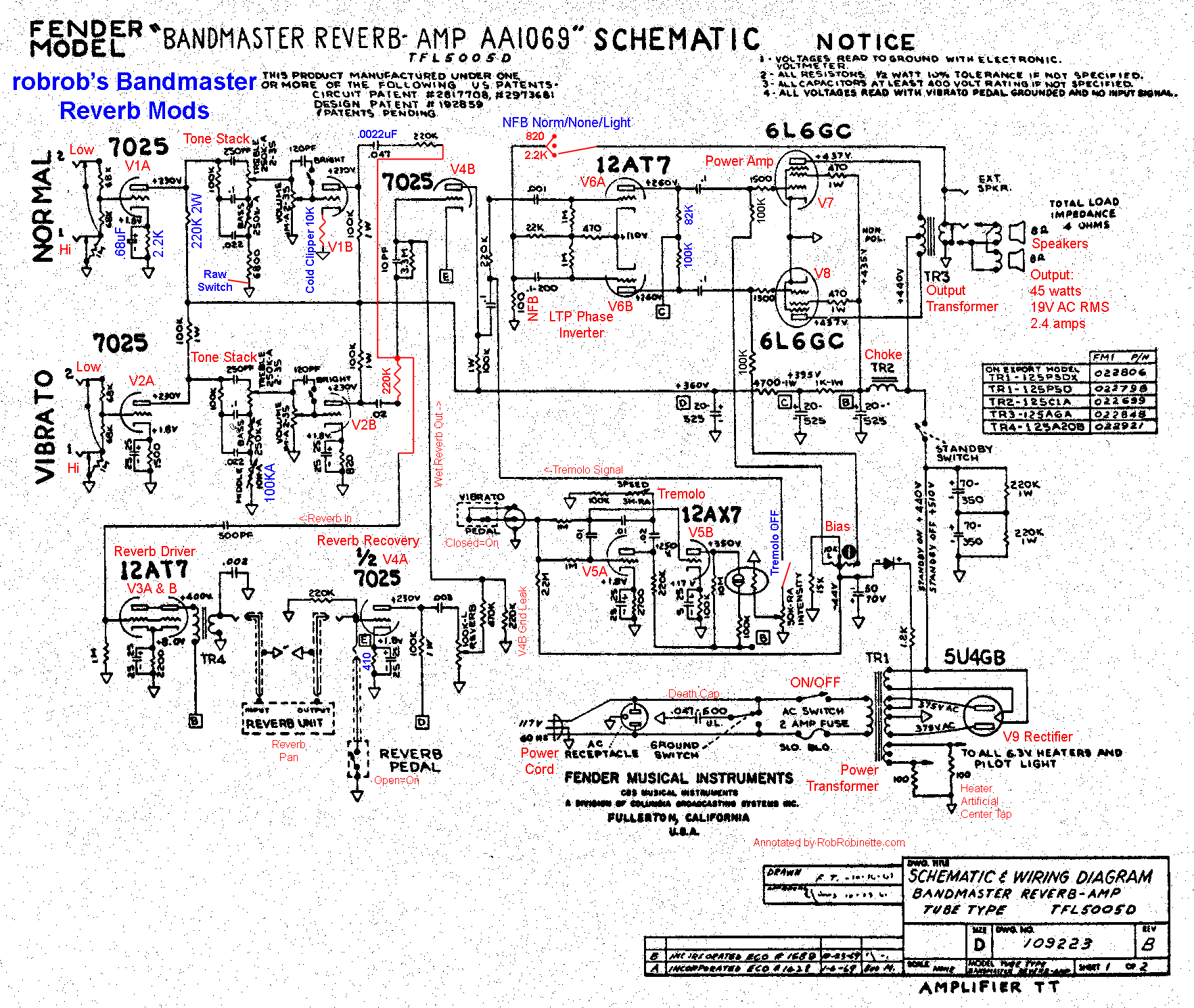
I also had to change my AA270's phase inverter coupling cap from .01uF to .001uF.
Real World Voltages
Here's the voltages I measured on my bone-stock AA1069 Bandmaster Reverb (schematic values in parenthesis):
All AC voltages are RMS
Wall voltage 124.7v AC (AA1069 schematic shows 117v)
Rectifier 5v heater measured 5.3v AC
6.3v heater measured 6.8v AC
Bias tap 59v AC
Power Transformer High Voltage Secondary: 384-0-384v AC (schematic shows 375-0-375v)
All following voltages are DC
A B+1 460v (schematic shows 440v)
B B+2 458v Power Tube Screens, Reverb Transformer, Tremolo (435v)
C B+3 444v Phase Inverter (390v)
D B+4 408v Reverb Recovery, Preamp Tubes (360v)
Power Tube Grid Bias Voltage V7 -45.2*, V8 -44* with balanced bias current of 39.8ma per tube of plate current at 460 plate voltage and 60.8% of max plate dissipation. *This amplifier has a bias balance pot and has been modified with an added adjustable bias pot.
Silverface Bandmaster Reverb Tube Pin Voltages
| Pin |
V1 Normal Preamp |
V2 Vibrato Preamp |
V3 Reverb Driver |
V4 Reverb Recovery & Preamp |
V5 Tremolo |
V6 Phase Inverter |
V7 Power |
V8 Power |
||
| 1 Plate |
230 |
280 |
451 |
262 |
270-290 |
303 |
|
|
||
| 2 Grid |
0 |
0 |
0.34 |
0 |
0 |
104 |
|
|
||
| 3 Cathode |
1.8 |
1.96 |
7.75 |
1.8 |
1.8 |
100 |
460 |
460 |
3 Plate | |
|
|
|
|
|
|
|
458 |
458 |
4 Screen | ||
|
|
|
|
|
|
|
-45.2 |
-44 |
5 Grid | ||
| 6 Plate |
296 |
297 |
466 |
250 |
420-430 |
327 |
|
|
||
| 7 Grid |
0 |
0 |
0.34 |
0 |
0 |
102 |
|
|
||
| 8 Cathode |
2.1 |
2.1 |
7.75 |
1.8 |
19-24 |
98 |
0 |
0 |
8 Cathode |
Wall voltage 124.7VAC. V5 (Tremolo) voltages oscillated. Tremolo set to minimum speed and intensity. Heater voltage was 6.8v AC.
68 Custom Deluxe Reverb Schematic
The 68 CDR is not a silverface amp, it is an almost exact copy of the 65 Deluxe Reverb Reissue with just a few valuable tweaks. Click the image for the full size schematic.
68 Custom Deluxe Reverb PCB Layout
Click the image for the full size layout.
Silverface Deluxe Reverb Chassis Photos by Psionic Audio
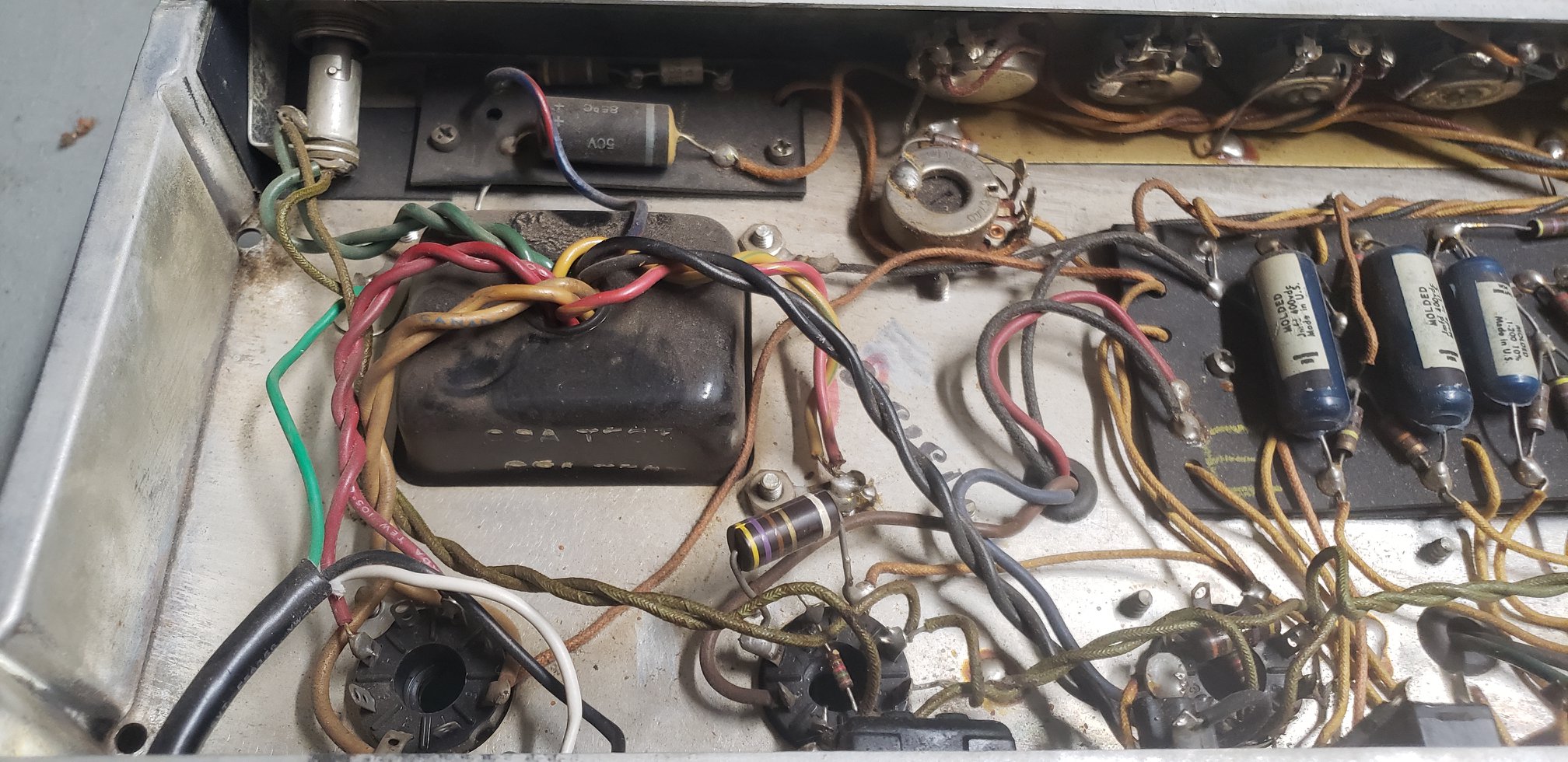
This is a 1967 early silverface Deluxe Reverb. Almost everything is original. Large screen resistor (lower center) is not original. The chassis interior is very blackface.
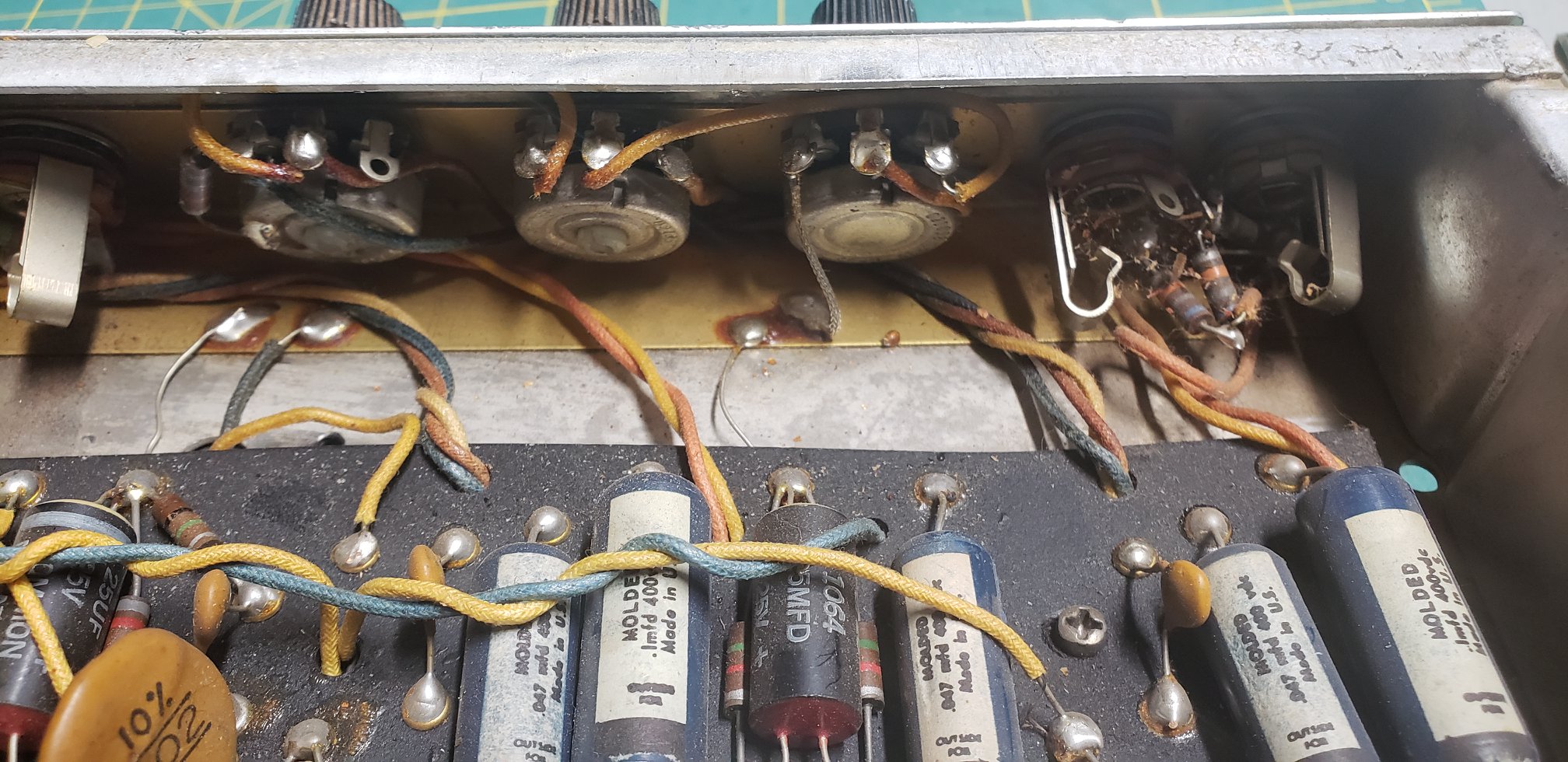
This guy did not use his Normal Channel (cobwebs on input jack).
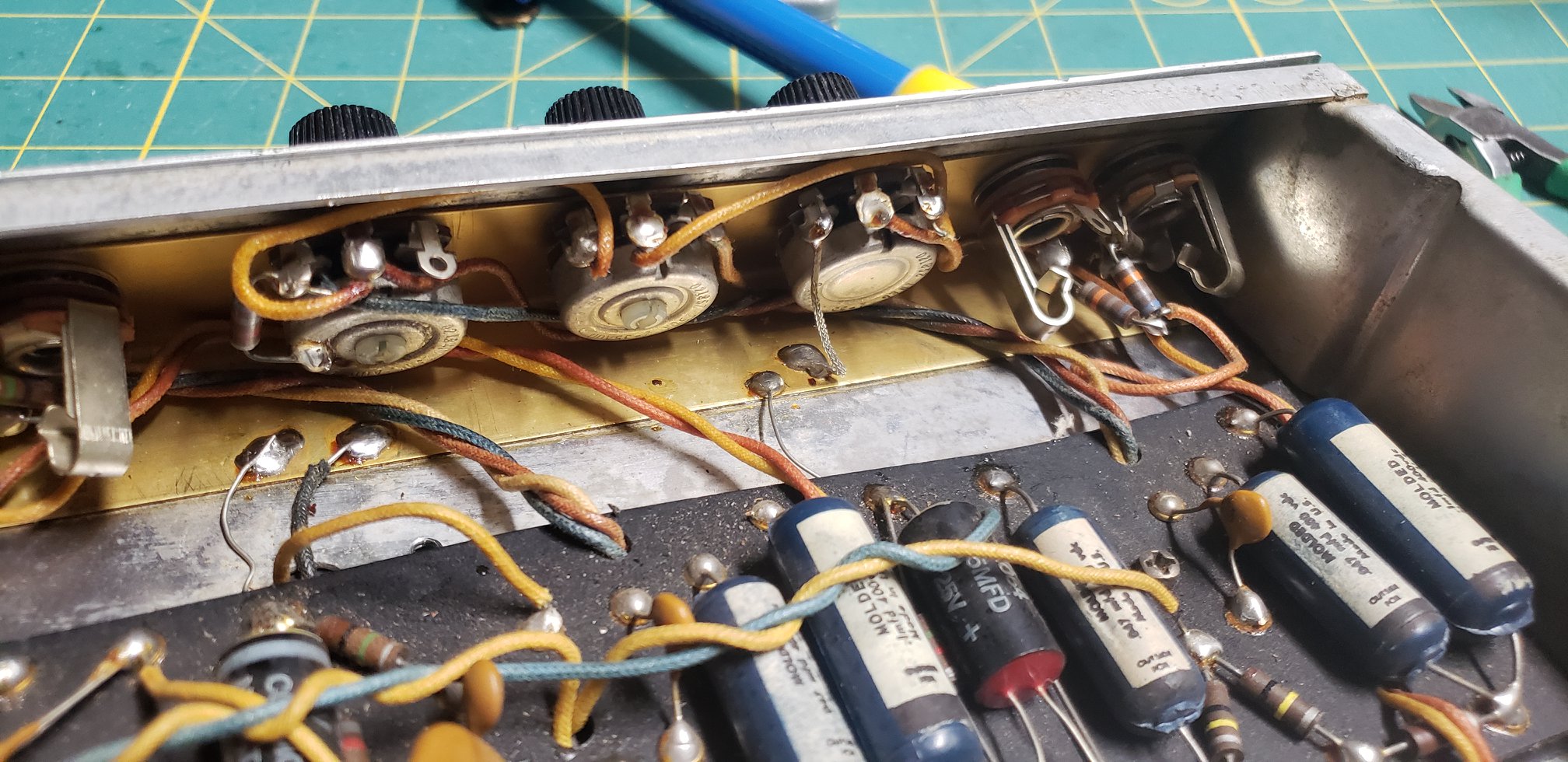
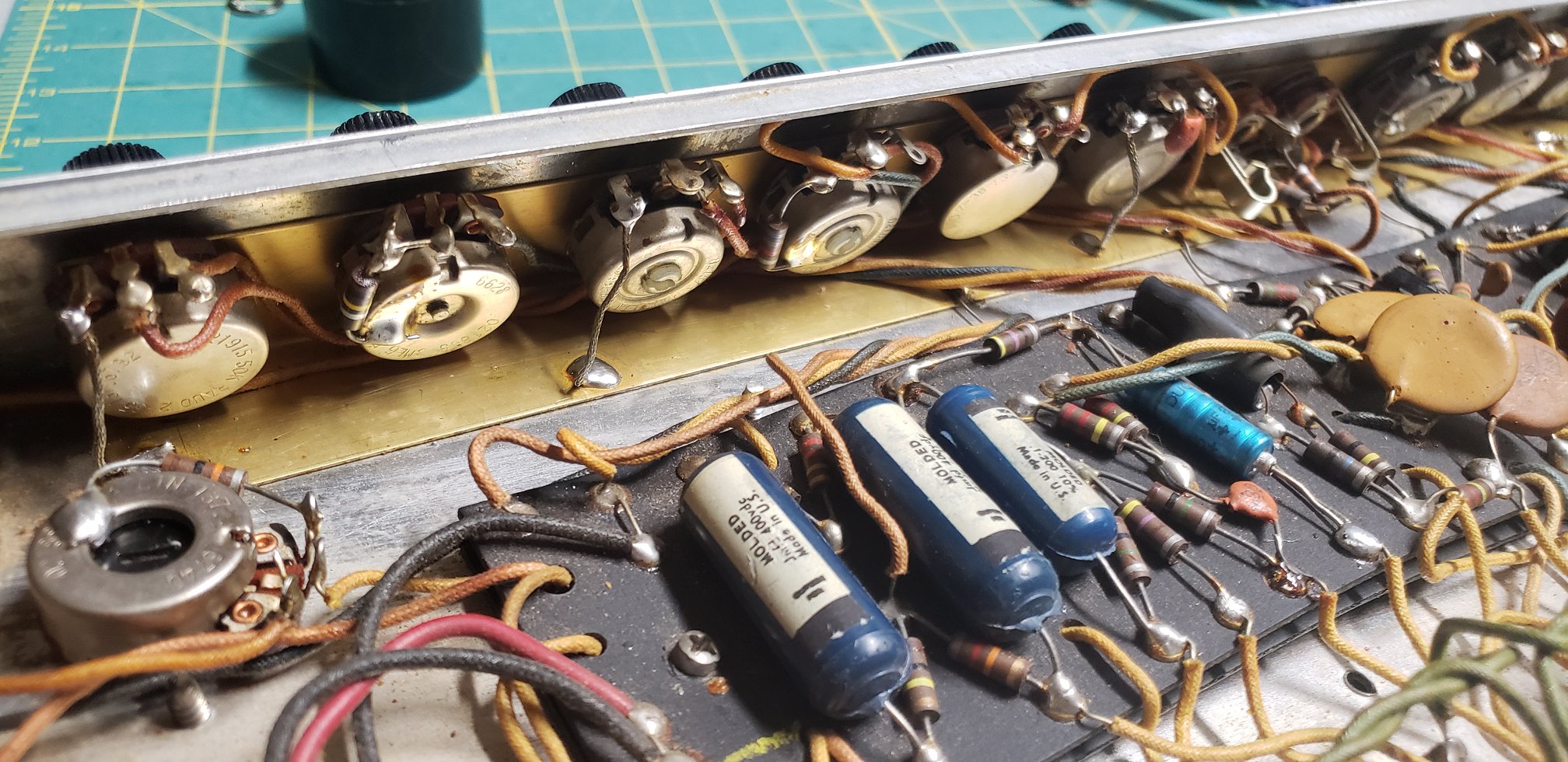

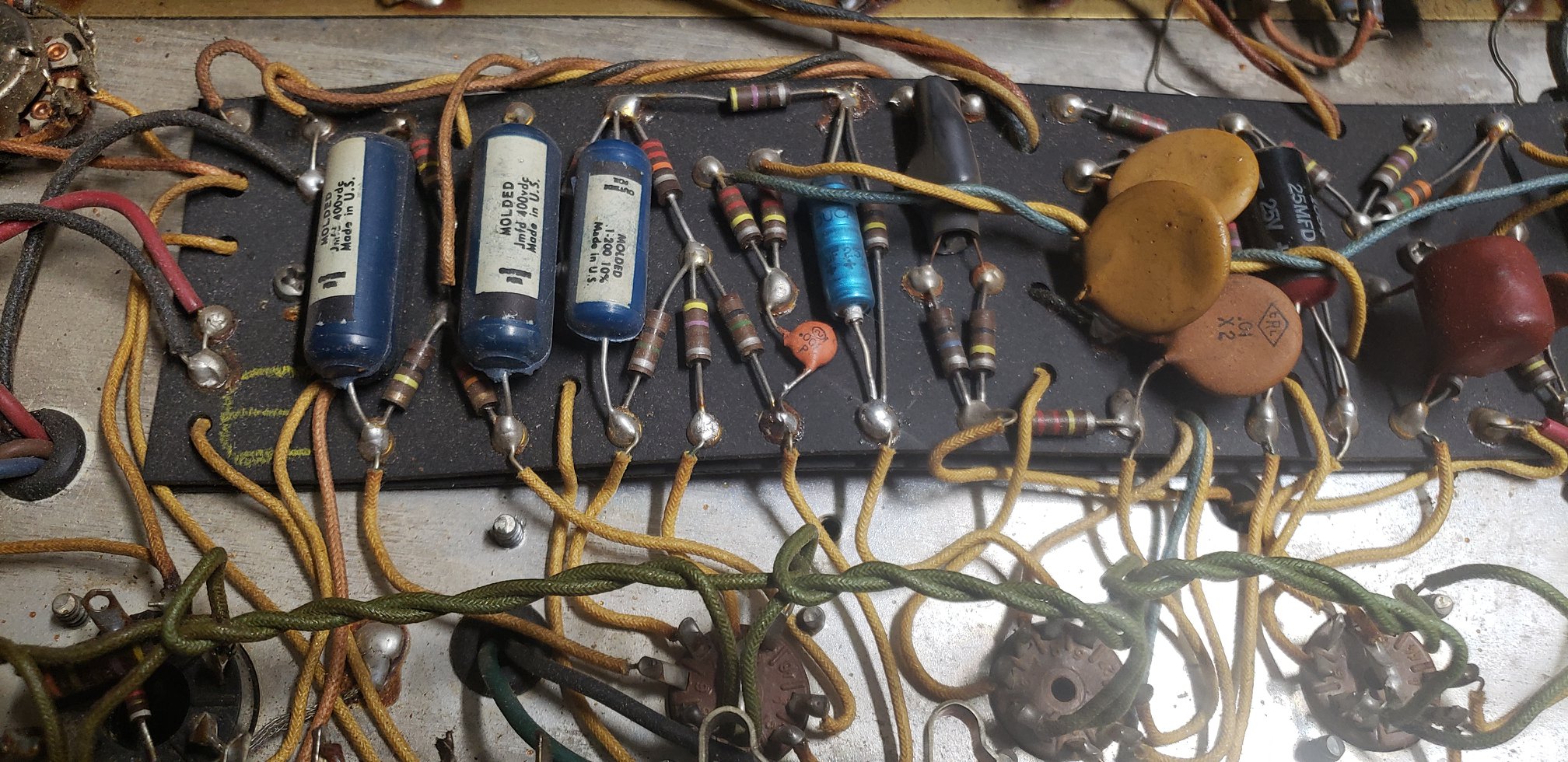
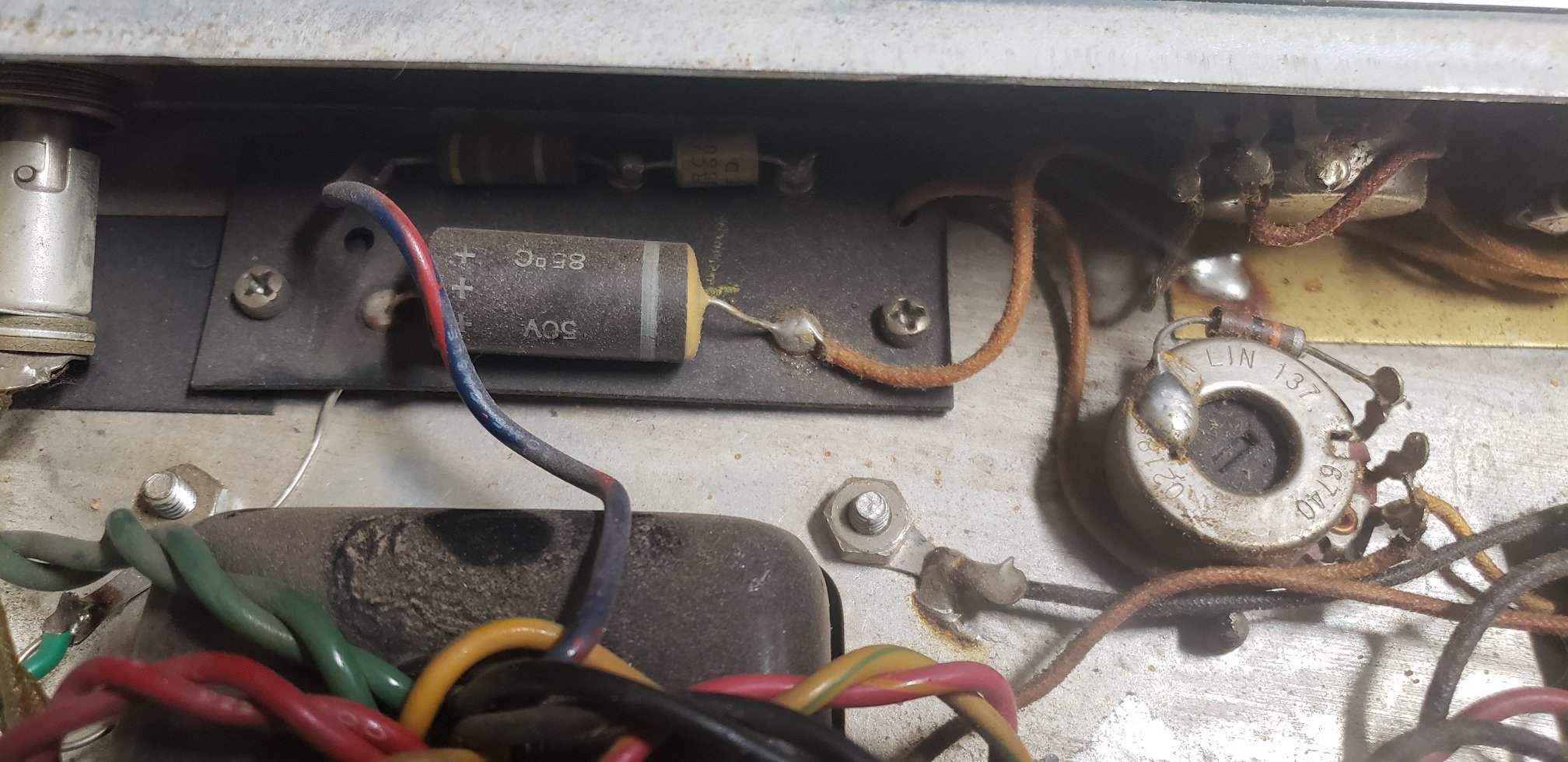
Pilot light at extreme left, bias board and bias pot.
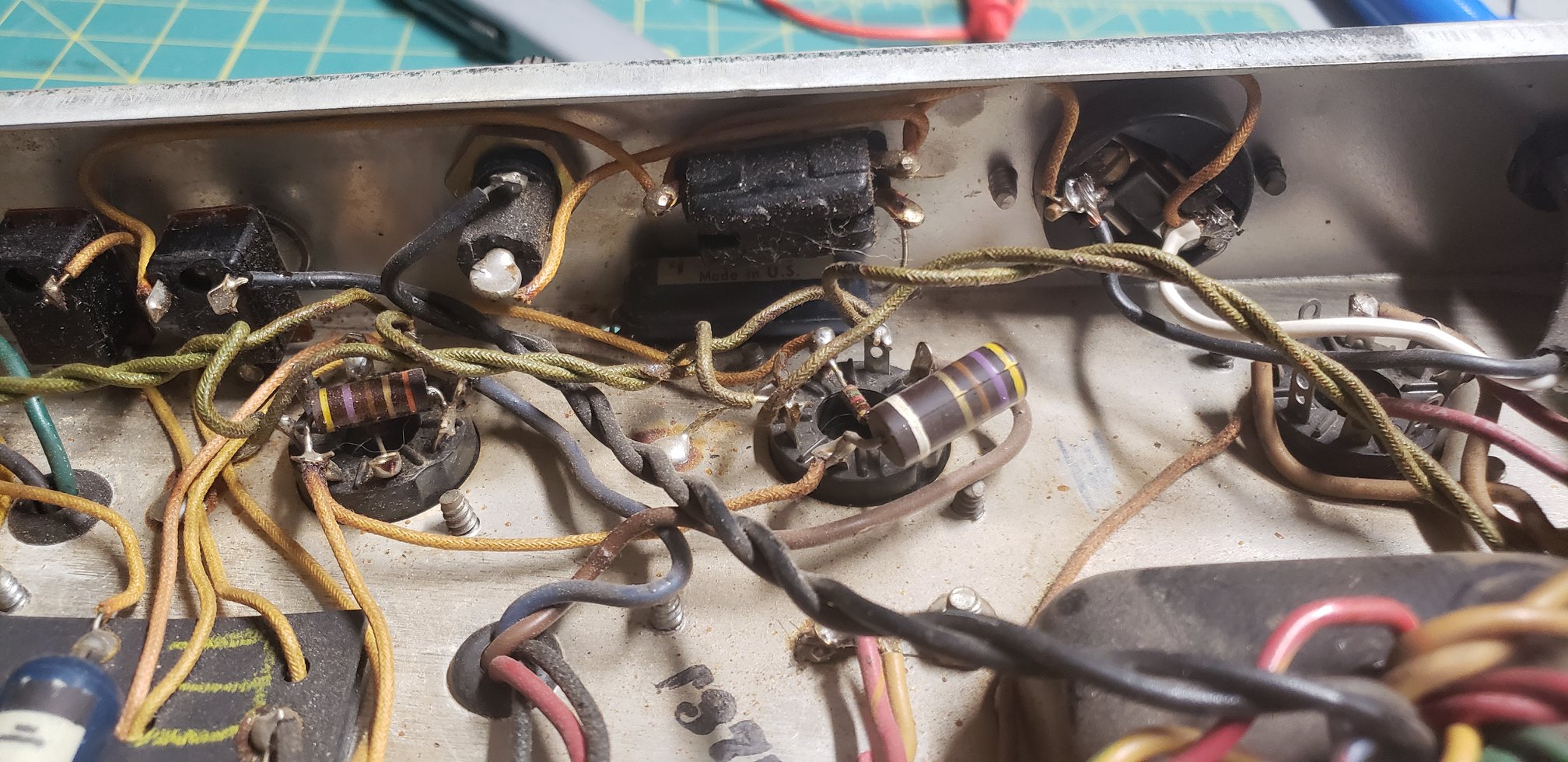
Standby Switch at far left, Power Switch, Fuse, Ground Switch (with "death cap" hiding underneath) and power receptacle at far right. Thanks again to Psionic Audio for the use of these excellent photographs of a very original silverface Deluxe Reverb. I highly recommend Psionic for tube amp maintenance and repair. They are located in Memphis, TN.
Photos of My Beloved 1972 Bandmaster Reverb
Gassy 6N3C power tubes make this image pop.
For more info on the silverface amp circuit see How the AB763 Deluxe Reverb Works.
By Rob Robinette
References
RCA Corporation, RCA Receiving Tube Manual, RC30.
Merlin Blencowe, Designing Tube Preamps for Guitar and Bass, 2nd Edition.
Merlin Blencowe, Designing High-Fidelity Tube Preamps
Morgan Jones, Valve Amplifiers, 4th Edition.
Richard Kuehnel, Circuit Analysis of a Legendary Tube Amplifier: The Fender Bassman 5F6-A, 3rd Edition.
Richard Kuehnel, Vacuum Tube Circuit Design: Guitar Amplifier Preamps, 2nd Edition.
Richard Kuehnel, Vacuum Tube Circuit Design: Guitar Amplifier Power Amps
Robert C. Megantz, Design and Construction of Tube Guitar Amplifiers
Neumann & Irving, Guitar Amplifier Overdrive, A Visual Tour It's fairly technical but it's the only book written specifically about guitar amplifier overdrive. It includes many graphs to help make the material easier to understand.
T.E. Rutt, Vacuum Tube Triode Nonlinearity as Part of The Electric Guitar Sound
[ How the 5E3 Deluxe Works ] [ Deluxe Models ] [ My 5E3 Build ] [ The Trainwreck Pages ] [ Fender Input Jacks ] [ B9A Prototype Boards ]

